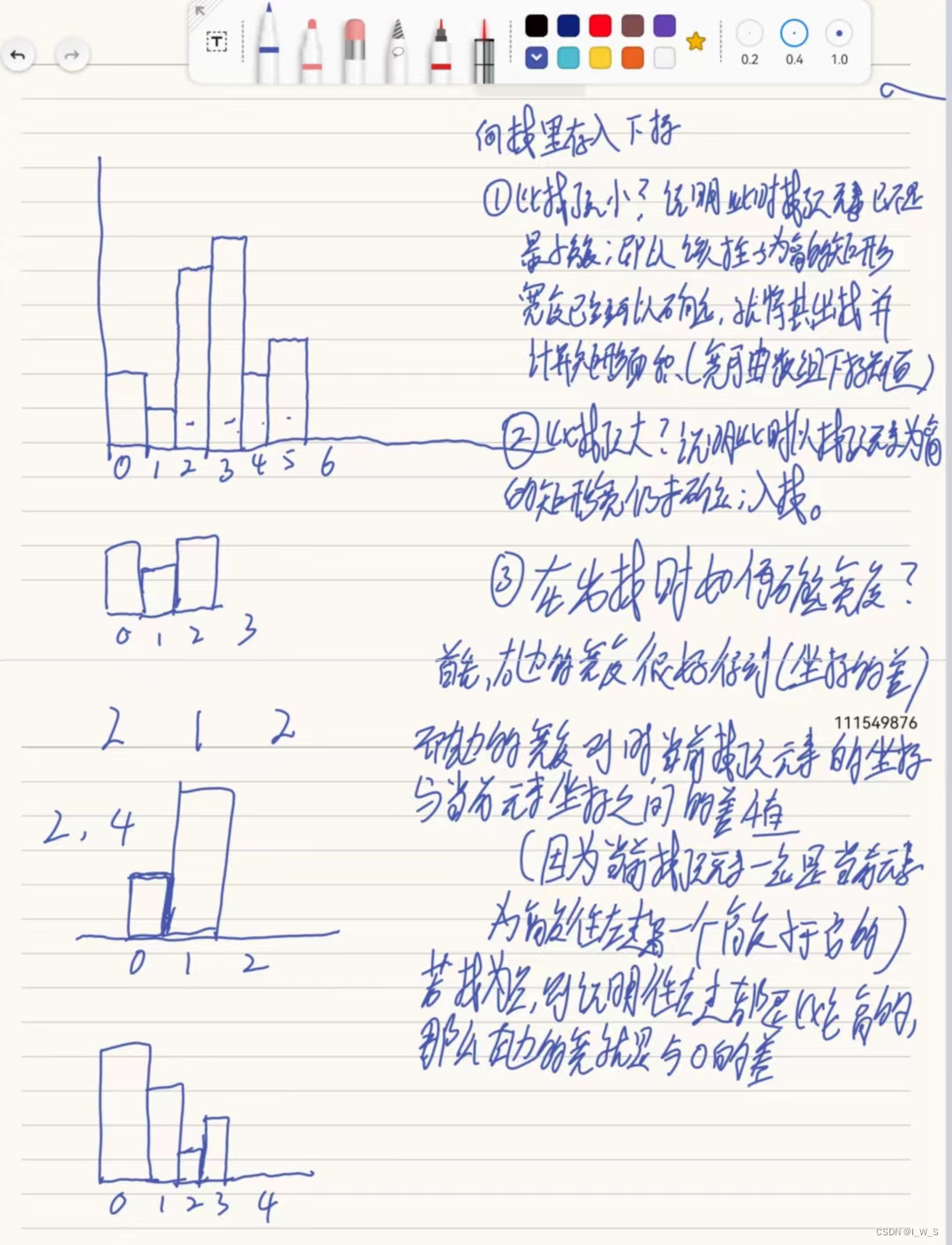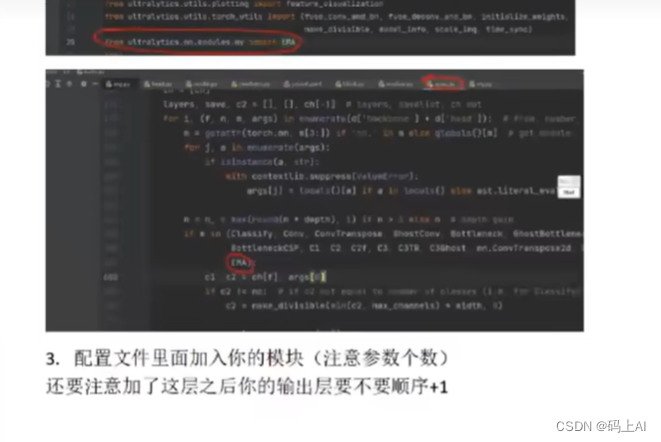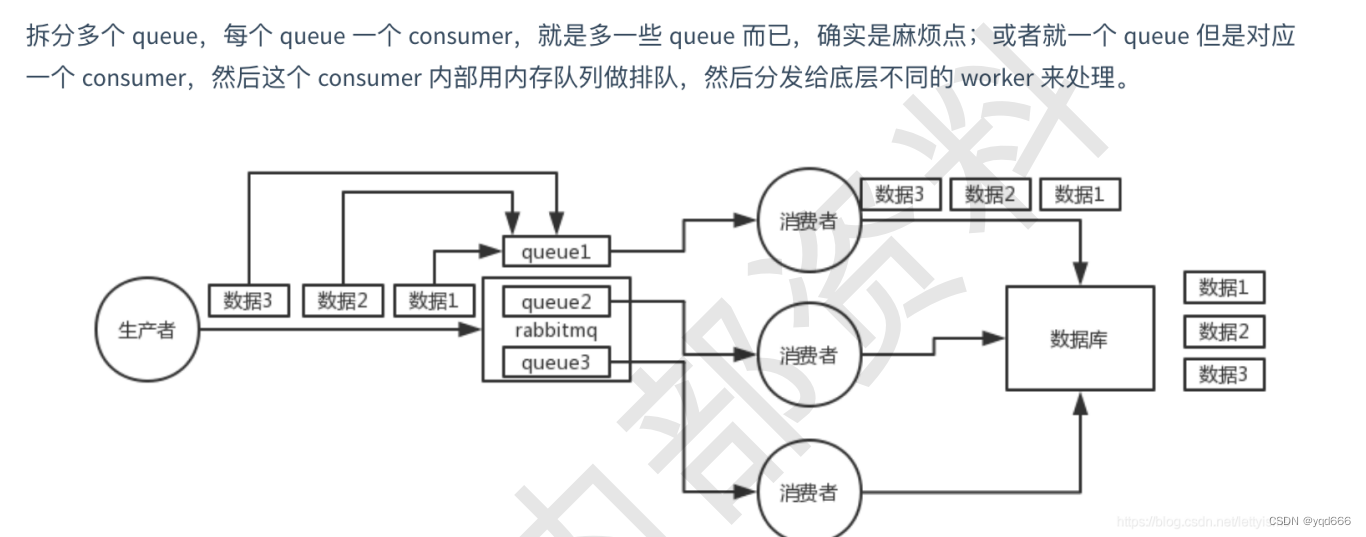Adjectives and Adjective Clauses
course certificate
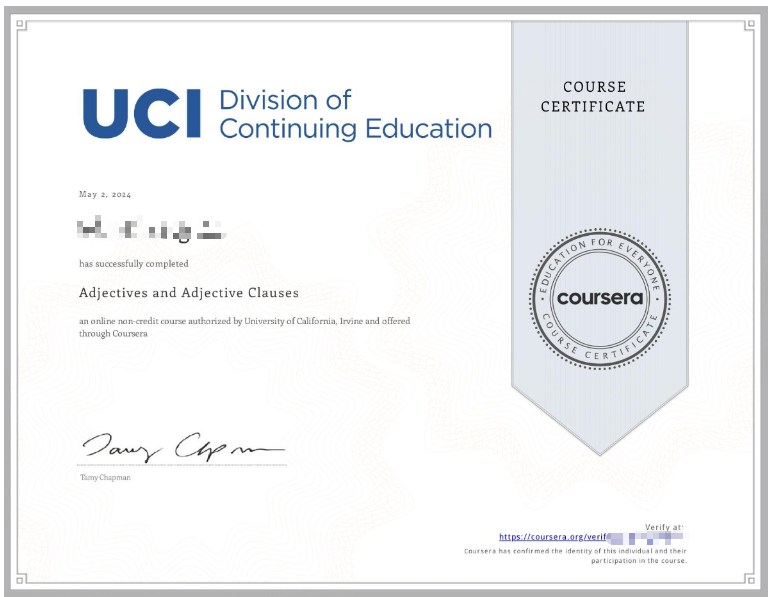
本文是 https://www.coursera.org/learn/adjective-clauses 这门课的学习笔记。

文章目录
- Adjectives and Adjective Clauses
- Week 01: Adjectives and Adjective Phrases
- Learning Objectives
- Adjectives Introduction Lecture
- Adjectives Practice Quiz
- Adjectives Practice
- Adjective Order Lecture
- Adjective Order Practice Quiz
- Participles Lecture
- Participles Practice Quiz
- Participles Practice
- Comparatives and Superlatives Lecture
- Comparatives and Superlatives Practice Quiz
- More Comparatives Lecture
- More Superlatives Lecture
- Comparatives and Superlatives Practice
- More Comparisons and Superlatives Practice Quiz
- Graded Assignment: Comparatives Assignment
- Graded Quiz
- Week 02: Adjective Clauses
- Learning Objectives
- Adjective Clauses Overview Lecture
- Adjective Clause Overview Practice Quiz
- Adjective Clause Practice
- Adjective Clauses with Subject Pronouns lecture
- Adjective Clauses with Subject Pronouns Practice Quiz
- Adjective Clauses with Subject Pronouns Handout
- Adjective Clauses with Object Pronouns Lecture
- Adjective Clauses with Object Pronouns Practice Quiz
- Adjective Clauses with Object Pronouns Handout
- Adjective Clauses with a Possessive Pronouns Lecture
- Adjective Clauses with a Possessive Pronoun Practice Quiz
- Graded Assignment: Adjective Clauses Assignment 1
- Graded Quiz
- Week 03: More Adjective Clauses
- Learning Objectives
- Adjective Clauses with Prepositions
- Adjective Clauses with Prepositions Practice Quiz
- Adjective Clauses with Prepositions Practice
- Adjective Clauses with "Where" Lecture
- Adjective Clauses with "Where" Practice Quiz
- Adjective Clauses with "Where" Practice
- Adjective Clauses with "When" Lecture
- Adjective Clauses with "When" Practice Quiz
- Adjective Clauses with "When" Practice
- Graded Assignment: Adjective Clauses Assignment 2
- Graded Quiz
- Week 04: Reduced Adjective Clauses and Appositives
- Learning Objectives
- Reduced Adjective Clauses lecture
- Reduced Adjective Clauses Practice Quiz
- Reduced Adjective Clauses Practice
- Appositives
- Appositives Practice Quiz
- Appositives Practice
- Graded Assignment: Reduced Adjective Clauses and Appositives Assignment
- Graded Quiz
- 后记
pajamas:美 [pəˈdʒæməz] 睡衣裤;宽长裤;睡衣
slim couch:细长沙发
petite:美 [pəˈtiːt] 个子小的;娇小的;小号的;
amused:愉快的,开心的
superlative:美 [suːˈpɜːrlətɪv] 美 [suːˈpɜːrlətɪv]
superlative adjectives:最高级形容词
family reunion: 家庭团聚
I’m wearing high-heel shoes : 穿高跟鞋
So who is the most talkative? 那么谁最健谈呢?
siblings:美 [ˈsɪblɪŋz] 兄弟姐妹;
possessive pronoun: 物主代词
belly:腹部
pronoun: 代词
preposition:介词
jellyfish:水母;海蜇
dung beetle:甲虫
stripe:美 [straɪp] 条纹;长条;线条
People who wear stripes should be careful about mixing too many stripe patterns 穿条纹衣服的人应该小心混合太多的条纹图案
appositive: 美 [əˈpɑːzətɪv] 同位语
Week 01: Adjectives and Adjective Phrases
In the first module, you will review what adjectives are and how to use them correctly in English. Then you’ll learn about adjective phrases. You’ll have plenty of chances to practice this material.
Learning Objectives
- explain what adjectives are
- use adjectives correctly in sentences
Adjectives Introduction Lecture
This lesson is about adjectives. You’ll learn what adjectives do and
how to identify them. Adjectives are big. Adjectives are small. Adjectives can be pretty. Adjectives can be gorgeous. They can turn the ordinary
into the extraordinary. Adjectives describe nouns and pronouns. Let’s look at some examples. A diligent student gets good grades. A happy mother is a good mother. I have awesome teachers. Here are the adjectives and
here are the nouns. The adjectives describe the nouns.
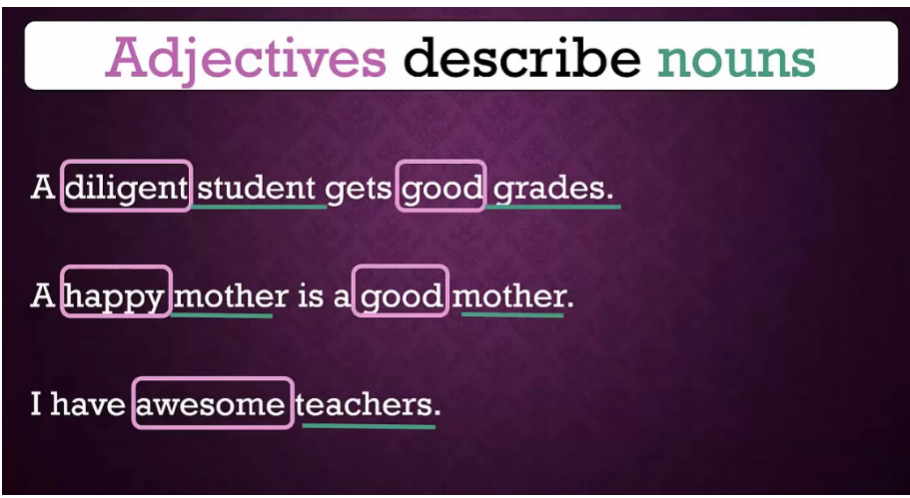
Adjectives can describe either singular or
plural nouns. Adjectives can also describe pronouns. For example, he is happy. They are colorful. He and they are pronouns. Happy and colorful are adjectives and
they describe the pronouns.
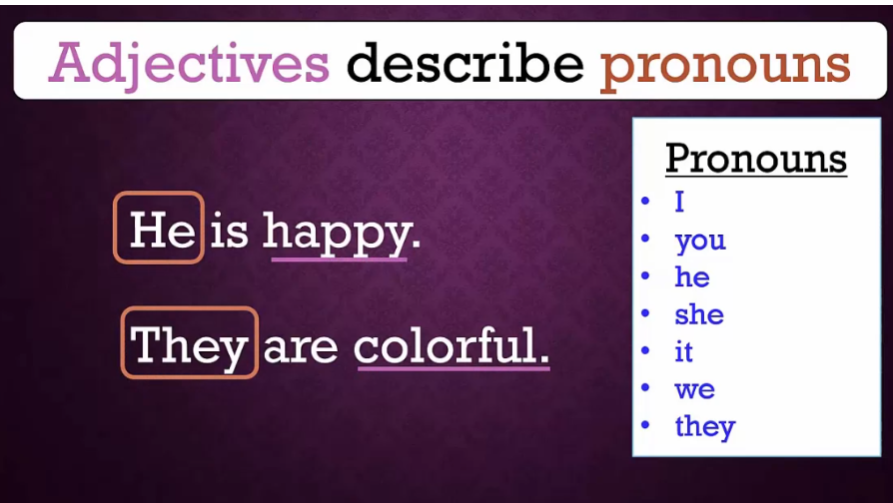
But how can you tell which
words are adjectives? One thing you can do is look for
common adjective endings. And we’ll talk about
those in just a minute. You can also look at
the sentence structure. Here are some common adjective endings. -al, like accidental,
personal, or regional. -ful, like beautiful,
colorful, and skillful. -ic, like historic, athletic, and basic. -ish, like selfish, foolish, and pinkish.
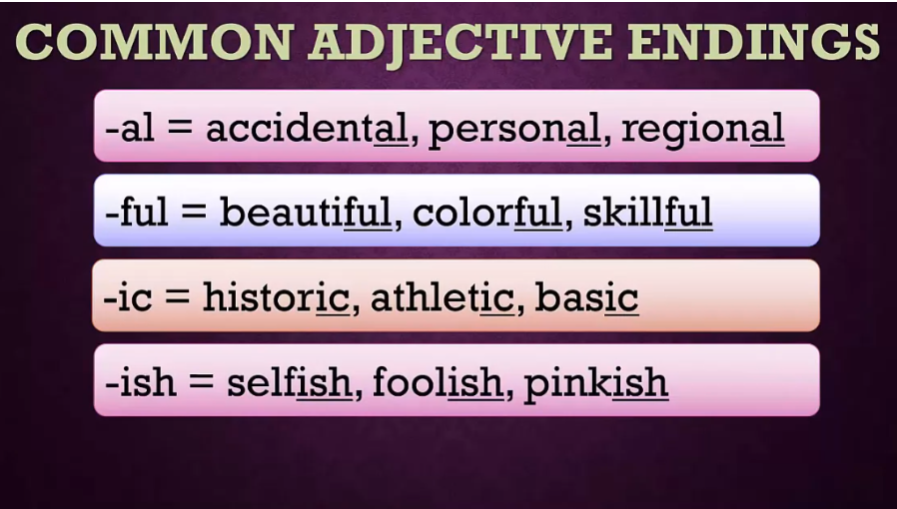
Here is one structure for
using adjectives. We have subject plus linking
verb plus adjective. And here are some common linking verbs. Be, become, seem, appear, look, feel, taste, smell and sound.
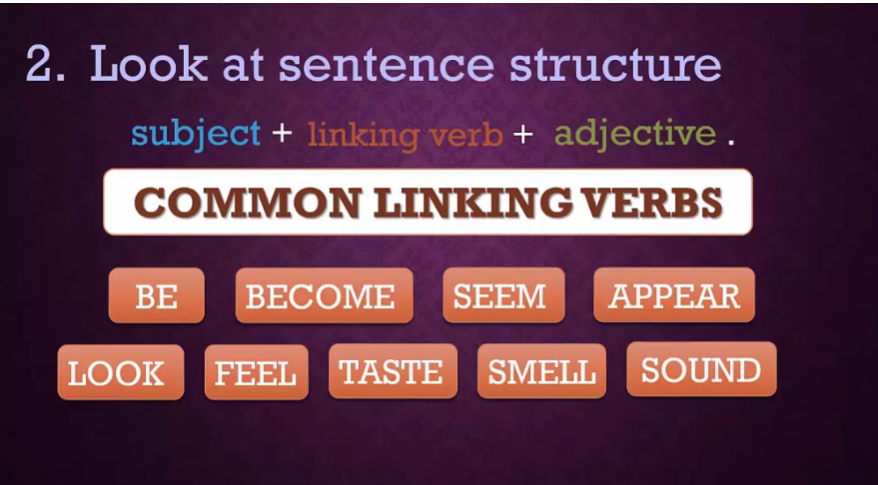
The linking verbs can be in any verb tense
such as present, past, perfect or future. The other structure in sentences
is to have adjective plus noun. For example, smart student,
happy mother, awesome teacher. You can also put articles in front
of them such as the, or a, or an. Remember that adjectives are descriptive. Adjectives are important. Adjectives are easy.
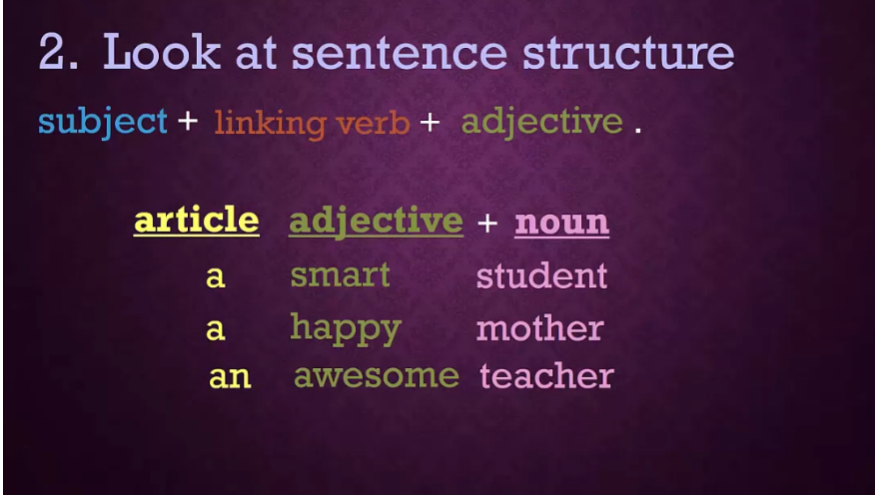
Adjectives Practice Quiz


Adjectives Practice
Practice
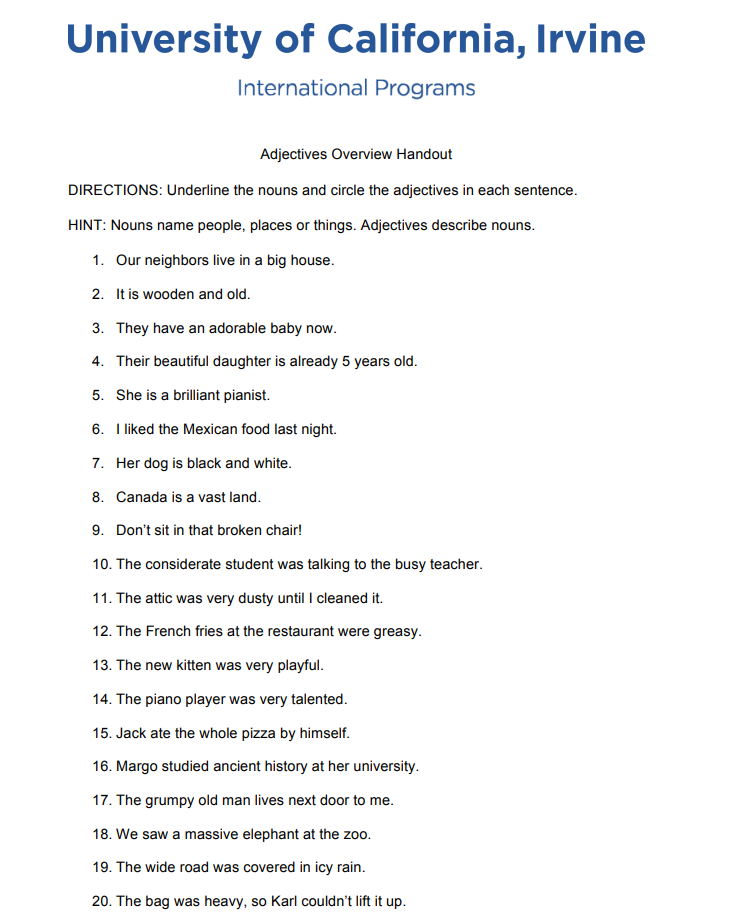
Answer

Adjective Order Lecture
Welcome, in this lesson you will learn how to put many adjectives
in the correct order. You already know that adjectives
describe nouns and pronouns. For example, the teacher is happy. Teacher is the noun. Happy is the adjective
that describes teacher. They are excited. They is the pronoun and excited is
the adjective that describes they. You could have many adjectives
to describe one noun. For example, here are some nouns and some
adjectives we could use to describe them. We can add more and more adjectives. But what order should
the adjectives go in? How do you know what order to use?

The good news is there is
an order to adjectives. First comes the number, then opinion, size, shape, condition, age, color, pattern, origin, material, and then purpose.
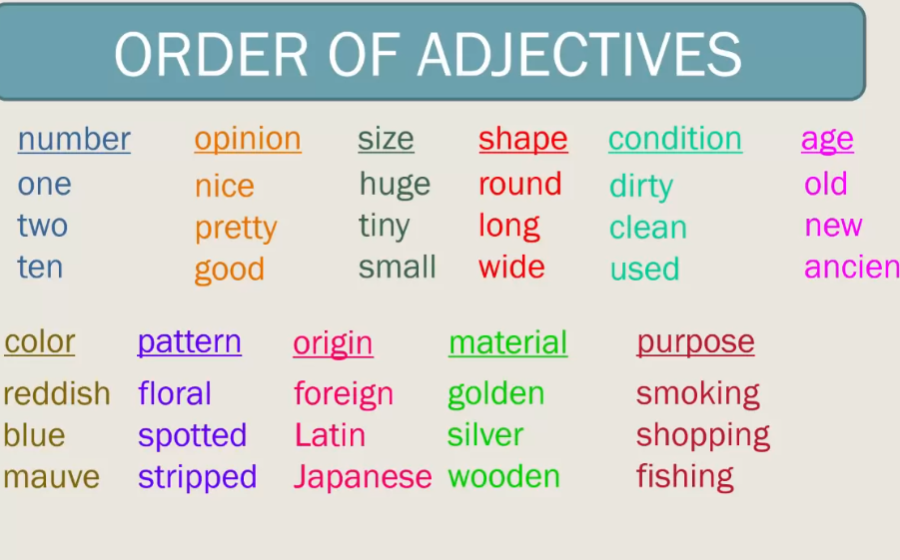
One way to remember this order,
is by using this sentence, now, on, small, slim, couches, a, cat, puts, on, magic, pajamas.

Now, on, small, slim, couches, a,
cat, puts, on, magic, pajamas.
Now on small slim couches a cat puts on magic pajamas. 现在,在纤细的小沙发上,一只猫穿上了神奇的睡衣。
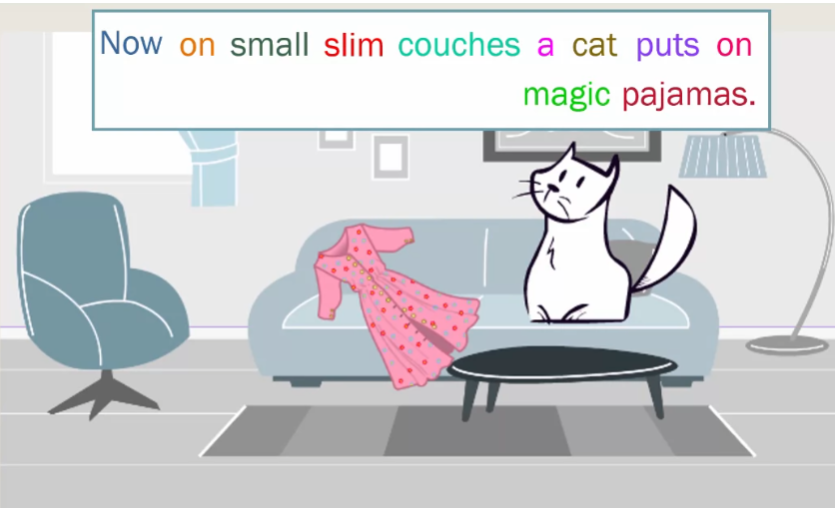

Now, let’s take a closer look. If we have the noun dresses, we could
use these adjectives to describe them. twenty, pretty, petite,
long, clean, new, red, lacy, French, silk, wedding, dresses.
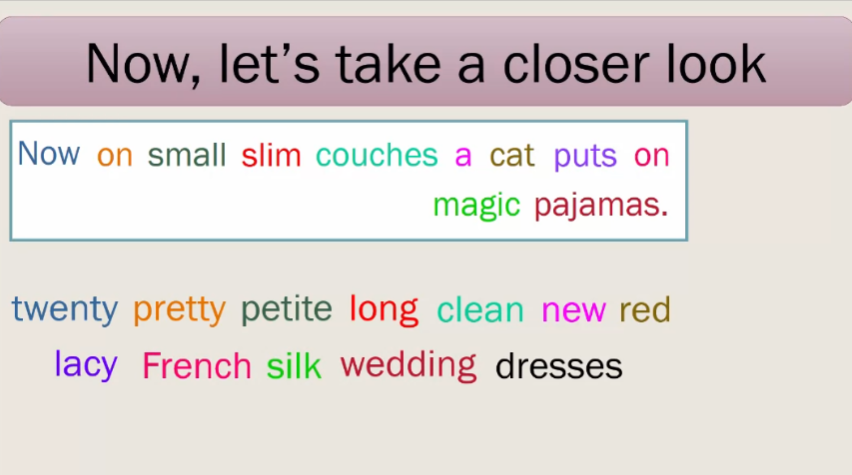
But usually we only use three to four
different types of adjectives for one noun. For example, for this woman,
we can describe her as pretty, slim, blond, Canadian.

Here’s a challenge for you. How many different types of adjectives
can you use to describe this dog? You may not be able to use all
the different types of adjectives. Here’s a possible answer. One, sweet, medium, strong, young, white, spotted, English, hunting dog.

In this lesson, you learned how to put
many adjectives in the correct order. Thanks for watching.
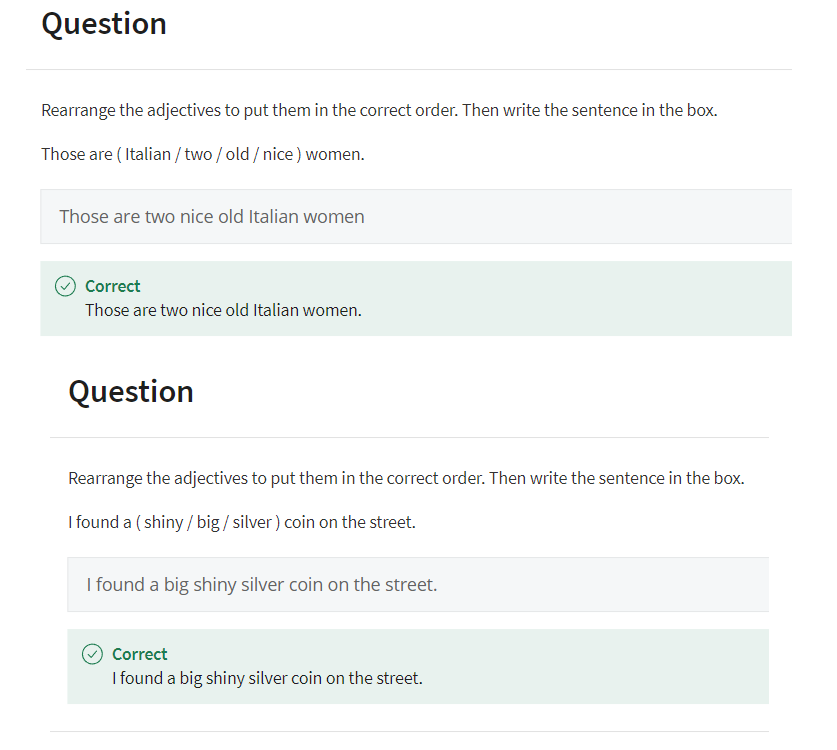
Adjective Order Practice Quiz

Susan bought a new brown spotted puppy.
We found two interesting used art books at the bookstore.
My grandfather has two black and white spotted Irish hunting dogs.
Participles Lecture
In this class your will learn
about participle adjectives. The difference in meaning between -ing and
-ed. Participle adjectives come from? You guessed it, participles! You have learned that the present
participle is formed by adding -ing. For example,
the present participle of look is looking. And the present participle
of dance is dancing. The past participle is
generally formed by adding -ed. Look becomes looked. And dance becomes danced.
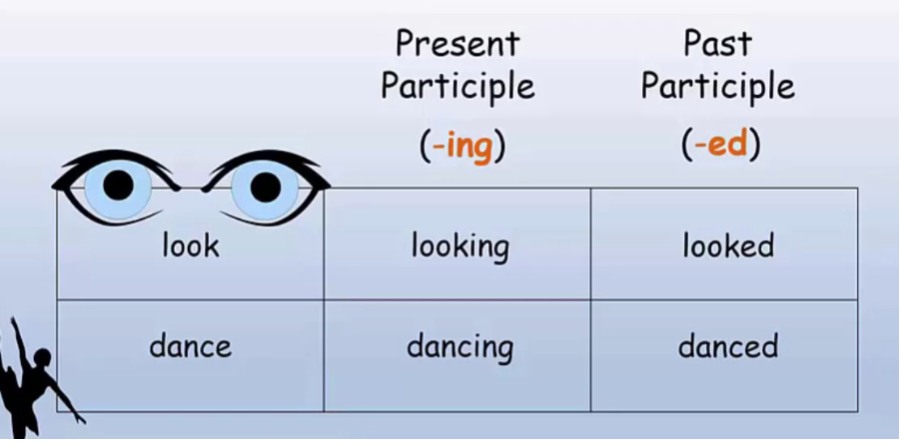
Present and
past participles are used in verb tenses. Some participles can also
function as adjectives. Look at these participle adjectives. Exciting, excited, amusing, amused, boring, bored, soothing, soothed. What do they have in common? They are feelings. When we use the past
participle as an adjective, we are talking about the feeling itself.

This feeling is inside you. It comes to you from outside. The present participle is
the cause of this feeling. Let’s say, money. When I see money, I am excited. The cause of this excitement is money. Money is exciting. When I have it, I am very excited
Let’s look at another example. They are laughing. They are amused. What’s causing this? The TV show must be funny. It is amusing. Outside to inside. They are amused. They are laughing. Both of these sentences have participles. How do you know when a participle is
a verb and when it’s an adjective? Well, try the “very” test. Very laughing. They are very laughing. Can you say that? No. So, laughing is being used here as a verb. Let’s look at the other one. Very amused. They are very amused. Can you say that? Yes. So, amused here is being
used as an adjective.
This boy is sad. It’s raining, so
he can’t play outside with his friends. He’s been stuck at home all day. Which sentence is correct? The child is boring,
or, the child is bored? If you say that, the child is boring, then you are saying that he
is not an interesting person. People don’t like talking and
listening to him. But that’s not true. He is an interesting
boy with many friends. The answer is, the child is bored. He is not causing this feeling. The poor weather is causing this feeling. The rain is boring.
Just like regular adjectives, participle adjectives do not need
to be at the end of a sentence. They can go in front of nouns. Here’s another way to say this,
he is a bored child. To him, this is boring weather. Fortunately, it can’t rain forever. Let’s not have a boring day. After doing some practice activities
with participle adjectives go out and enjoy yourself. Maybe you can go to the beach. Let the ocean air inside your soul. The ocean air is soothing. And you will be soothed.
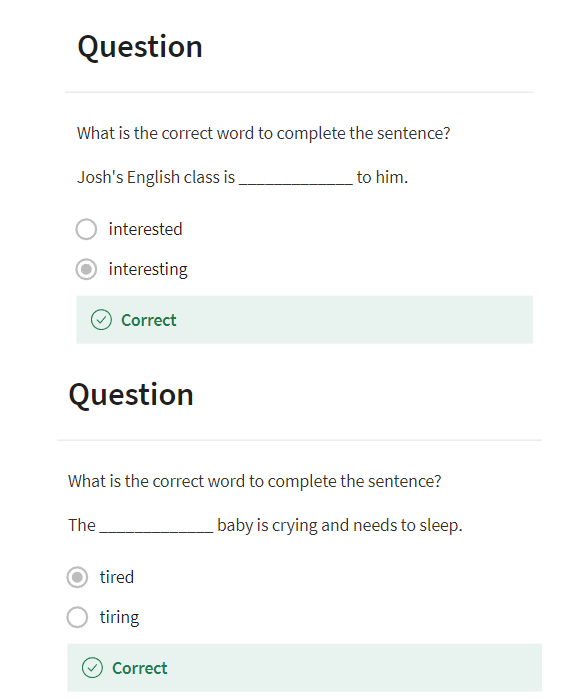
Participles Practice Quiz
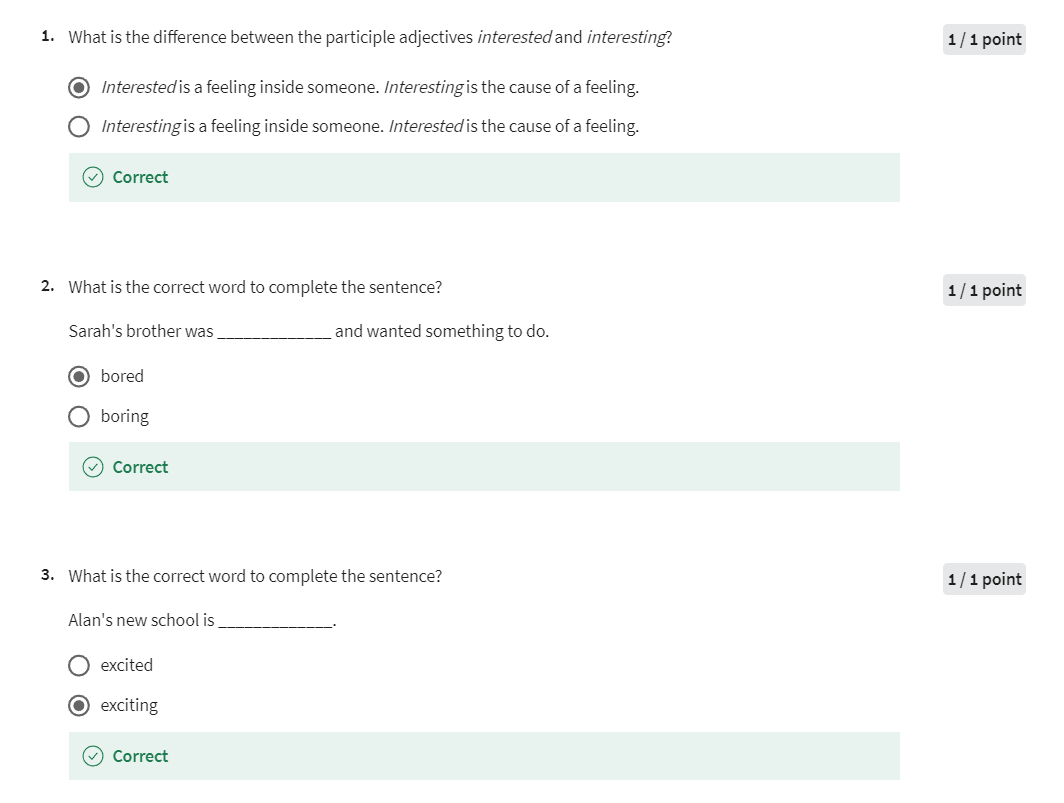
Participles Practice
Practice
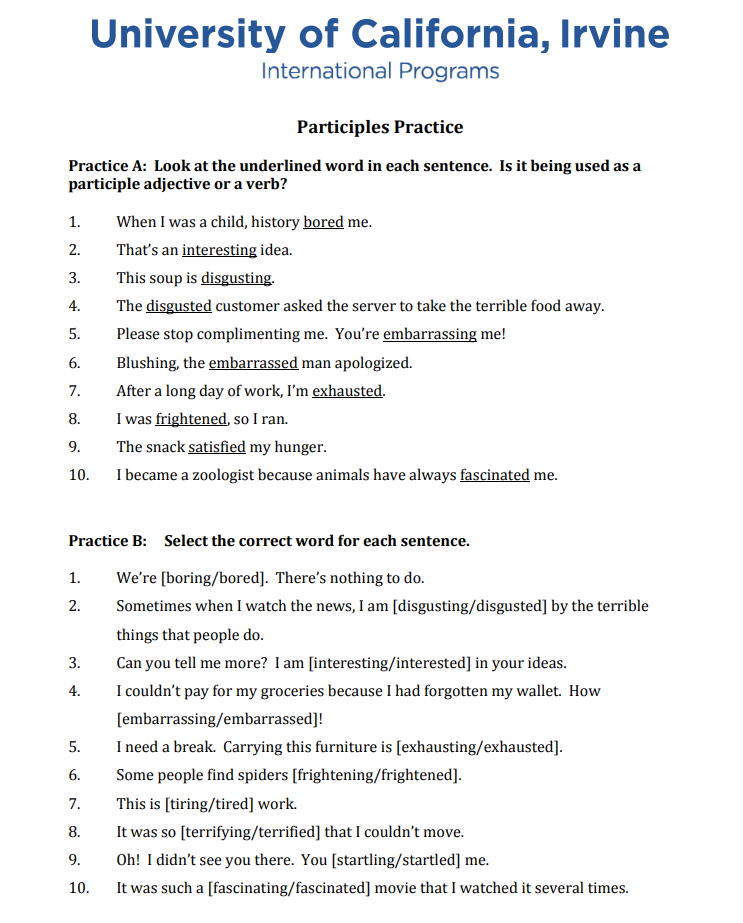
Answer
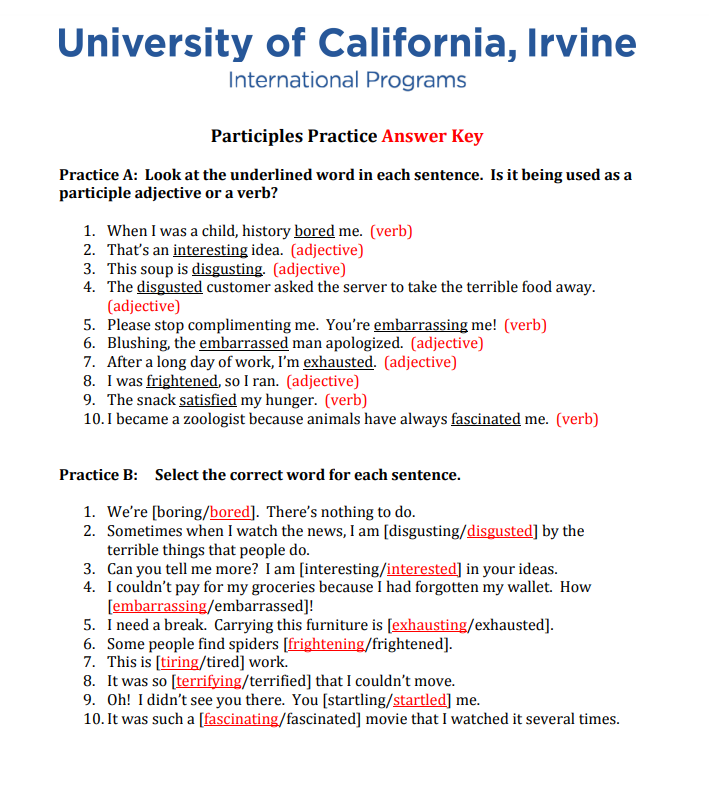
Comparatives and Superlatives Lecture
Hi, today we will do a quick review on
comparative and superlative adjectives. Let’s look at the comparative first. Imagine that I have to choose
between two universities, University A and University B. I chose some features that are important
to me when I choose a school. We have student population, tuition, distance from home,
and iBT TOEFL score minimum.
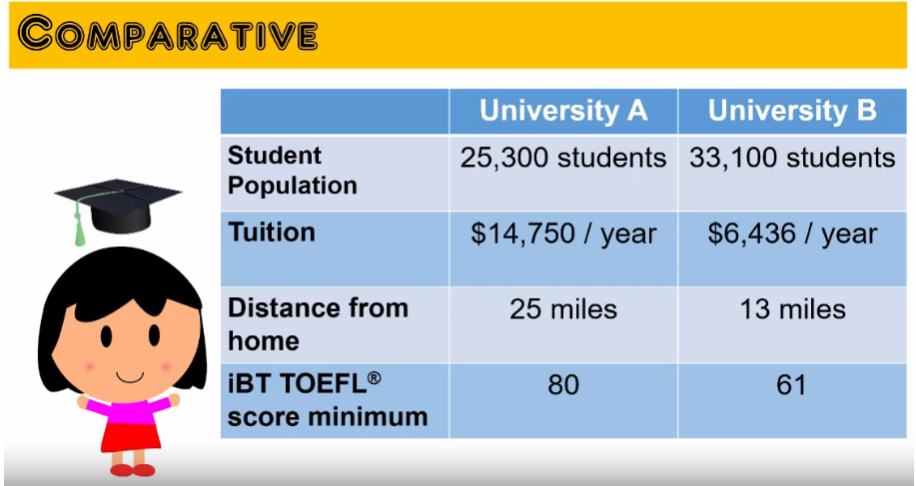
Hm, looking at this chart,
in terms of student population, A is smaller than B,
or B is bigger than A. I like a school with less students. So, so far, University A is better. Next, tuition,
how much it will cost every year. Wow, look at those prices. I cannot afford A. It is more expensive than B. In other words B is cheaper than A. It seems that B is better.

After this I will look at how far
these schools are from my home. I don’t like driving and
there is a lot of traffic where I live. Wow, it seems A is farther than B. I like that B is closer.
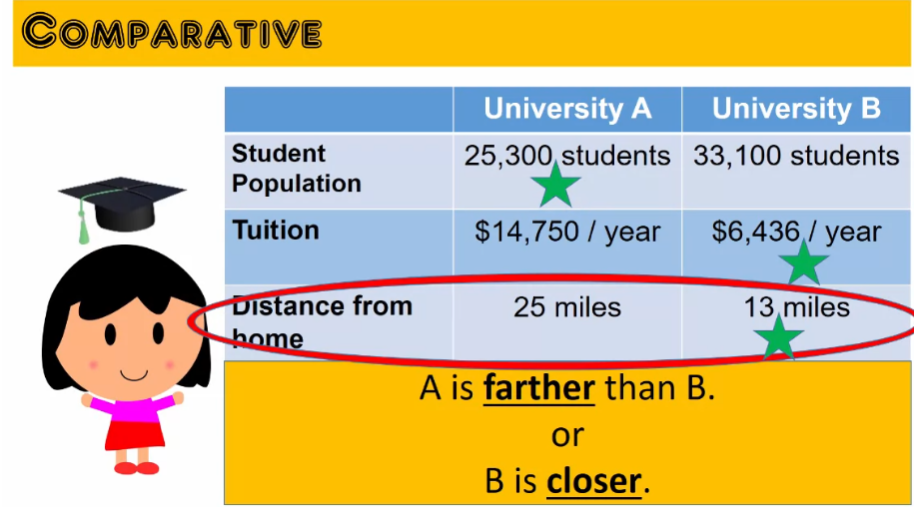
Lastly, I have to think
about my TOEFL score. I don’t have a high score. It seems that the TOEFL score
requirement for A is higher than B. Since B’s is requirement is lower,
maybe B will accept me. Overall, B seems like a better school for
me. Let’s review the comparative.
We use the comparative when we
compare two things or two people. In my case, I compared two schools. For adjectives with one syllable and some adjectives with two syllables,
you add an to the adjective. Big becomes bigger. Spicy becomes spicier. Some two syllable words are special. You would add more or
less to the adjective. So careful becomes more careful or
less careful. If there are three or more syllables, you would also add more or
less to the adjective. For example, interesting. It becomes more interesting or
less interesting.
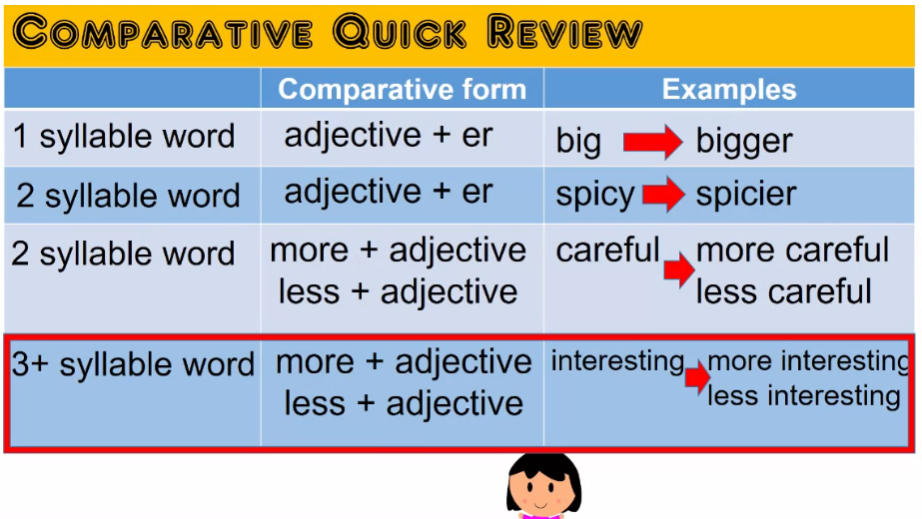
Finally, this is how you form
a basic sentence pattern. X, be verb comparative adjective than Y. I have provided two examples. University A is smaller than University B. University B is cheaper than University A.

Okay, some of you are thinking, well what happens when I want
to compare more than two things? Good question. Let’s add one more school to our chart,
University C. Hm, now that I look at C and
compare it to A and B, I can say that school C is the smallest
school with 6,400 students. But the tuition my gosh C is the most
expensive of the three universities For distance, A is still the farthest
school and B is the closest. Lastly, B still has the lowest
TOEFL score minimum. It seems that B is still the best for me.

Now you probably noticed that all the adjectives
change from to est. This is the superlative. It is used when we compare three or
more things. The rules for
superlatives are similar to comparatives.
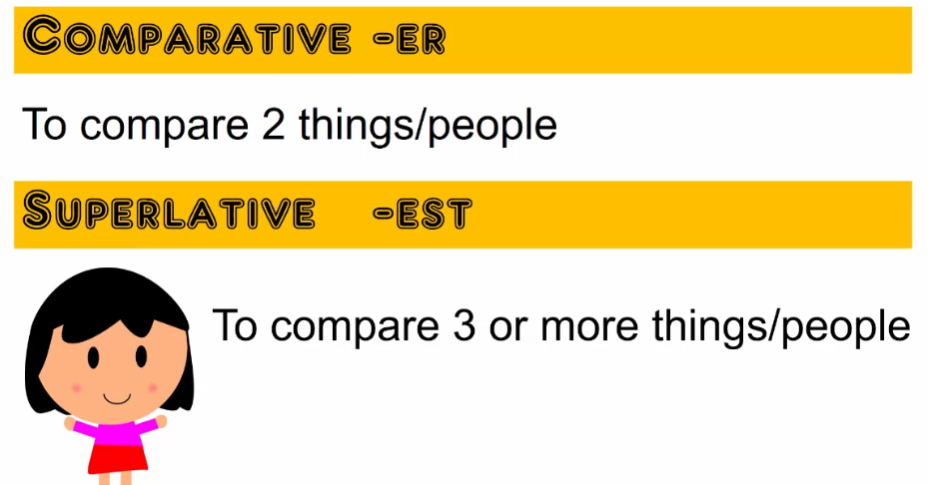
Let’s review this chart. For superlatives, if adjectives are one or two syllables,
you just add est to the end. For some two syllable adjectives or
three or more syllable adjectives you would use most plus the adjective or
least plus the adjective.
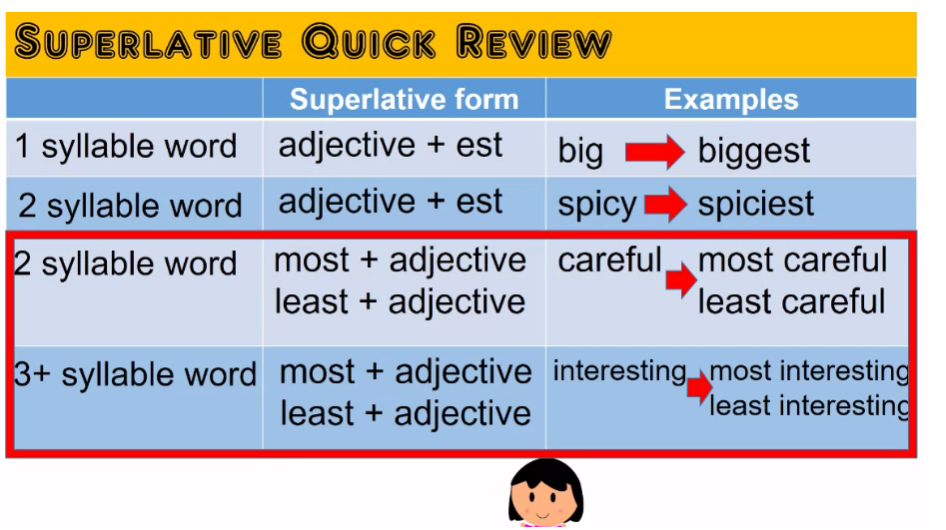
Finally when we want to make
a sentence with a superlative, we do not use then,
we would say X, be verb, the, superlative adjective. It is very important to use the definite
article the, before the superlative.
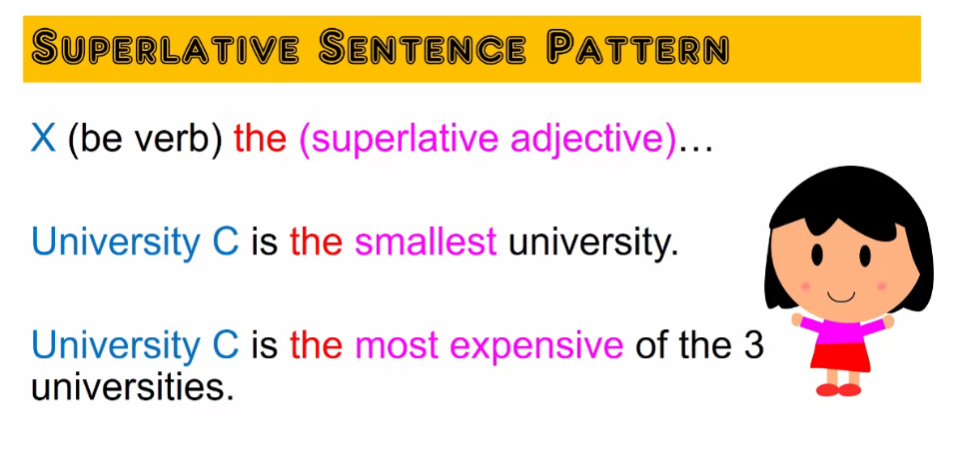
And there’s one more thing. Yes, there are such things
as irregular adjectives. Good and bad. Instead of adding est, more, or less,
good becomes better and best. Bad becomes worse and worst. This is why you heard me say
that B is better than A. When I compare two universities, but B is also still the best when
I compared three universities. One more example is far. The comparative becomes farther and
the superlative becomes farthest. I hope this review was
helpful in reminding you of the differences between comparative and
superlative adjectives.

Comparatives and Superlatives Practice Quiz


More Comparatives Lecture
This a continuation
lesson of comparatives. Listen to a dialogue between me and
my friend. Hey, your new apartment is nice. It’s definitely nicer
than your last place. >> Thanks,
I’m glad I found this place too. >> Is this your family? >> Yeah!
We took this last year at our family reunion. This is my mom, and my dad, my grandma,
my older brother, and my younger brother. >> Your younger brother is almost
as tall as your older brother! >> Yeah, sometimes people can’t tell
who is older and who is younger. And you, you’re as tall as your dad.
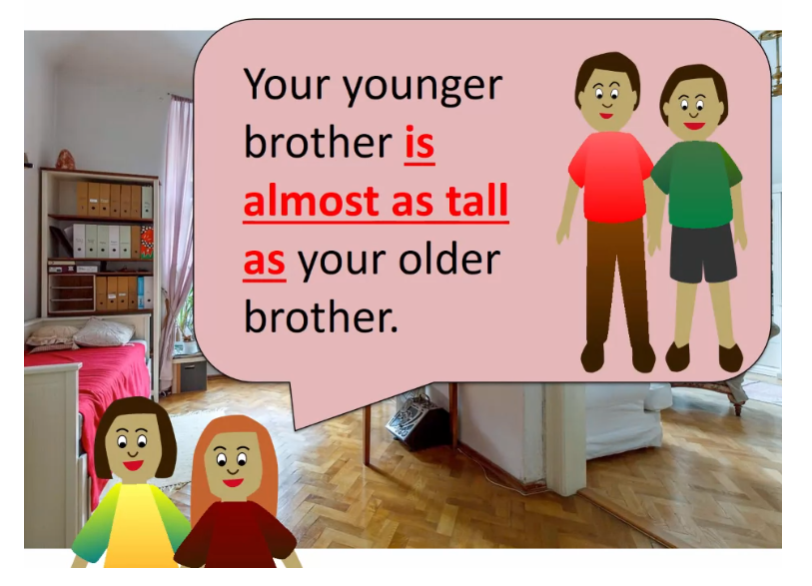
Well, no, this picture doesn’t show
it but I’m not as tall as my dad. He’s still taller than me. I’m wearing high-heel shoes
Aw, your grandma and
your mom look very similar. >> Yeah, everyone says the same thing. I think it’s the face shape. My mom’s face is just as
round as my grandma’s. >> [LAUGH] Yeah, it seems like it. So who is the most talkative? >> Hm, I think my older brother. My grandma thinks he is one of the most
talkative guys in the entire family. I think he just enjoys talking to people. Everyone thinks he’s very friendly.
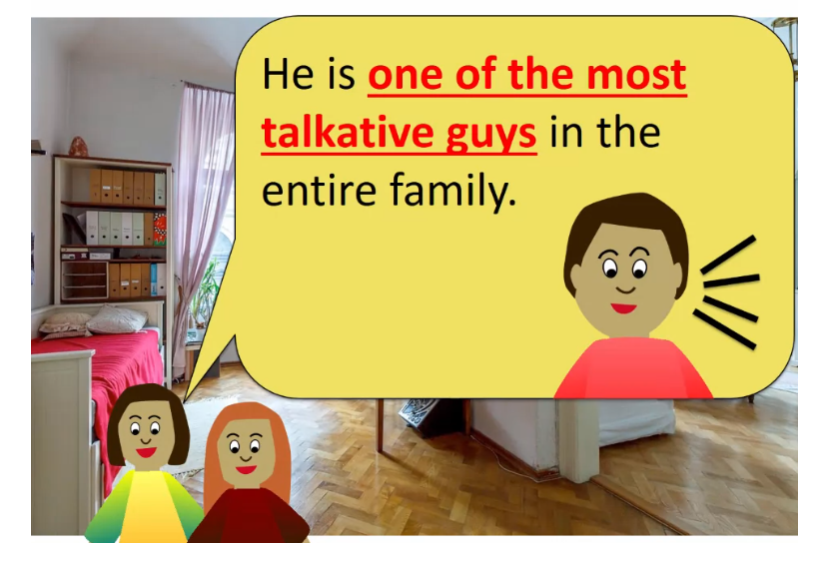
So, your younger brother is not nearly
as talkative as your older brother? >> No, no,
my younger brother is pretty quiet. >> Well,
does your older brother have a girlfriend? Personally I’ve never
seen a more handsome guy. [LAUGH]
I’m not sure about that.
I just had a conversation
about my family with my friend. You probably noticed that I used,
as, a lot. Let’s take a look at
the sentences using as. As phrases are used for
comparing two things. My friend said,
you are as tall as your dad. This is the same as saying that,
my dad and I are the same height. When you want to say that
two things are the same, you can use the sentence pattern, subj1 (be verb) as (adjective) as subj2.
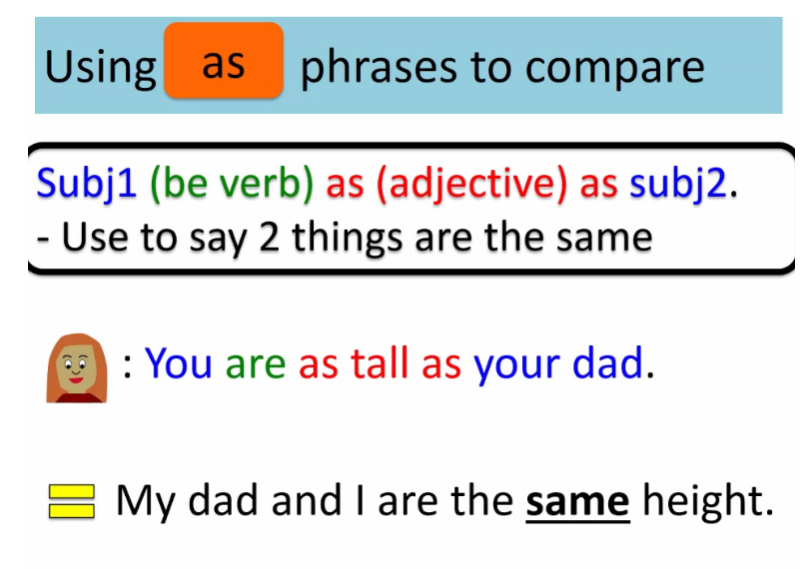
Let’s take a look at another sentence. My mom’s face is just as
round as my grandma’s. This is the same as saying that both
their faces are the same roundness. You noticed that I used, just. Just is common in conversation. It emphasizes that the two
things are exactly the same.
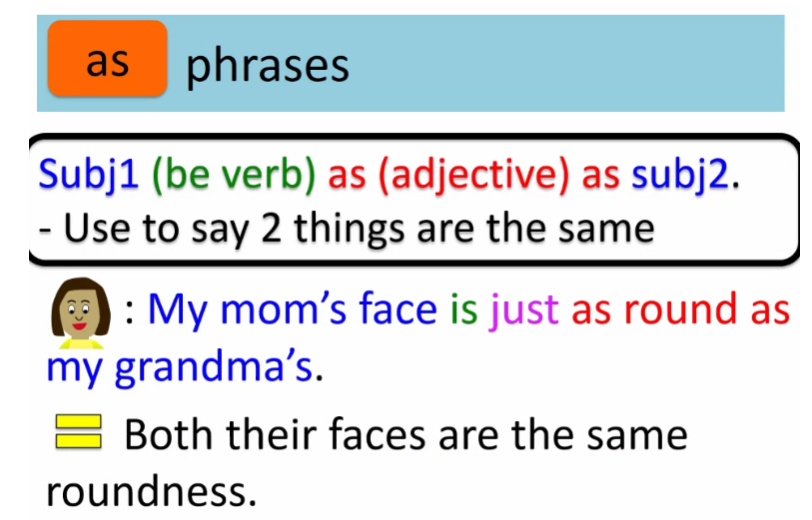
Next, my friend said, your younger brother
is almost as tall as your older brother. Now this sentence is a little different
compared to the previous sentences because it has the word almost. Almost means that they are close,
but not the same. The sentence basically means that my older
brother is taller than my younger brother, but they are close in height. Another word that means almost is nearly. That means that we can also
say your brother is nearly as tall as your older brother.
You can also use the negative,
not, with, as, not as. Look at this sample sentence. I am not as tall as my dad. In this sentence I am basically saying
that my dad and I are not the same height. My dad is taller than me. When you say, subject1 (be verb)
not as (adjective) as subject2, you are saying that subject2
is still more than subject1.
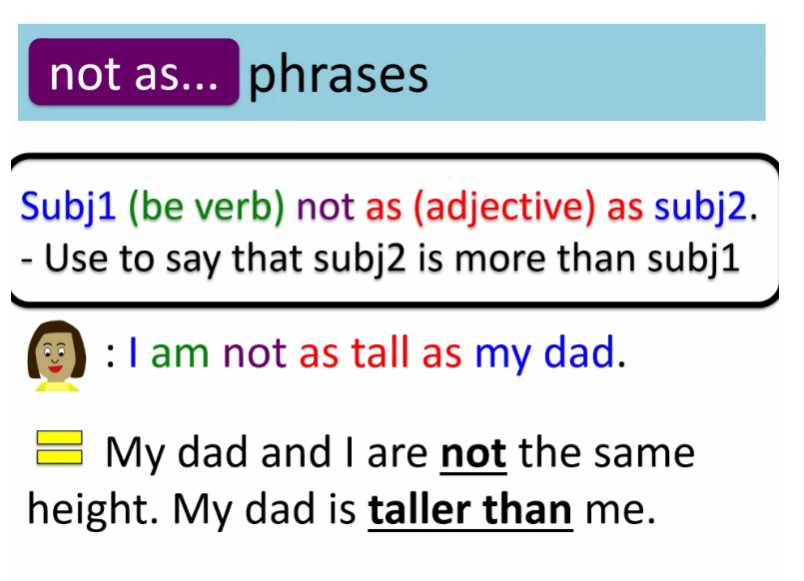
Here is another sentence
from the conversation. My younger brother is not nearly
as talkative as my older brother. In this sentence, because it is negative, we already know that my older brother is
more talkative than my younger brother. When we add the word nearly,
it doesn’t change the meaning. It’s just emphasizing
the negative in conversation. Maybe you are wondering,
can we use almost in negative sentences? The answer is, no. You cannot say, my younger brother is not
almost as talkative as my older brother. It doesn’t work. Instead, you can also use quite. It has the same meaning
as nearly in this case. My younger brother is not quite
as talkative as my older brother. For these as sentences,
they show comparison. But the way that you make
a sentence is different from using the e-r comparative adjective.
More Superlatives Lecture
Now we will continue to talk
about More Superlative Sentences. I will still use the dialogue from
More Comparative Sentences’ video lesson. Let’s look at the superlative-related
sentences from the dialogue. You probably notice that
I used the sentence He is one of the most talkative
guys in the entire family. The meaning of this sentence
is different from saying he is the most talkative guy
in the entire family. In the first sentence I am suggesting
that there are very talkative guys in my family, and he is one of them. The sentence pattern is subject,
(Be verb) one of the (superlative adjective) (plural noun). It is important to make this noun plural because my brother is not
the only talkative one. There are other talkative
people in my family, too.
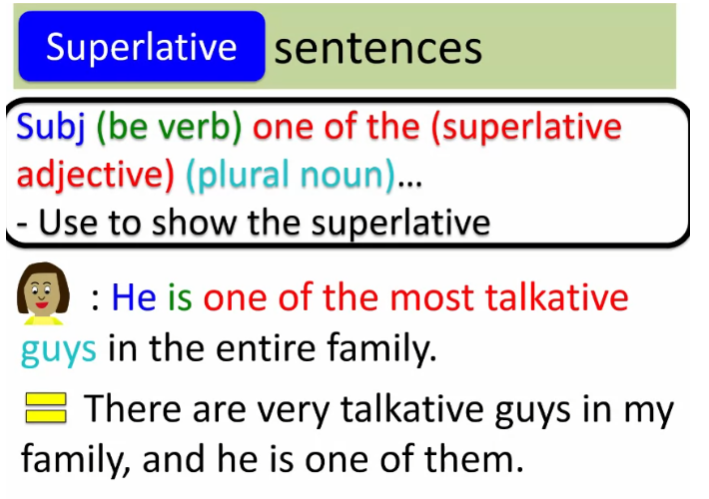
Let’s look at a couple more examples
that aren’t related to my conversation. There are many famous cities in the world:
Paris, London, Hong Kong, Dubai, etc. New York City is one of them, too. So we can say New York City is one of
the most famous cities in the world. Most famous is a superlative of famous,
and city becomes the plural cities. Another example, Helen is one of
the smartest people that I know. I know a lot of smart people,
and Helen is one of them. Smartest is a superlative for smart. And person becomes people for plural. I hope these examples help you
understand the sentence pattern.
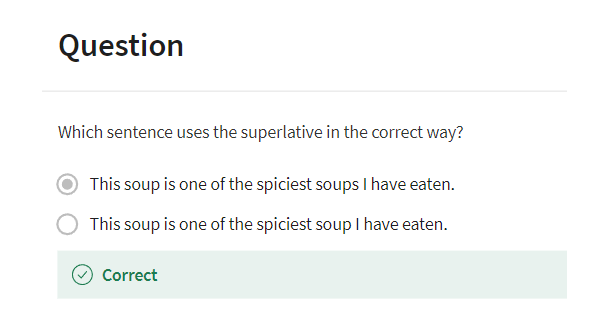
We have one last superlative sentence. This one is a little confusing,
so pay attention carefully. In the conversation, my friend said I
have never seen a more handsome guy. In this sentence,
you see more handsome, and you think it’s a comparative adjective. Handsome to more handsome. But then you see never, and
this is actually a change in the meaning. The meaning of this sentence
becomes a superlative. It is the same as saying he
is the most handsome guy. This sentence is more frequently
used in conversations. The sentence pattern is Subject,
present perfect, never, comparative adjective, noun.

Let me give you some more examples. She is taking a test and
it’s extremely hard. It’s possible to say she has
never taken a harder test. This means that in her opinion,
this is the hardest test. Notice the comparative harder and
the present perfect plus never. Has never taken. Another example, is a group of people
are eating very spicy noodles. It’s probably the spiciest
noodles that they’ve ever eaten because they have to drink a lot of water. I can say,
they have never eaten spicier noodles. Spicy becomes spicier, also I used present
perfect plus never, have never eaten.
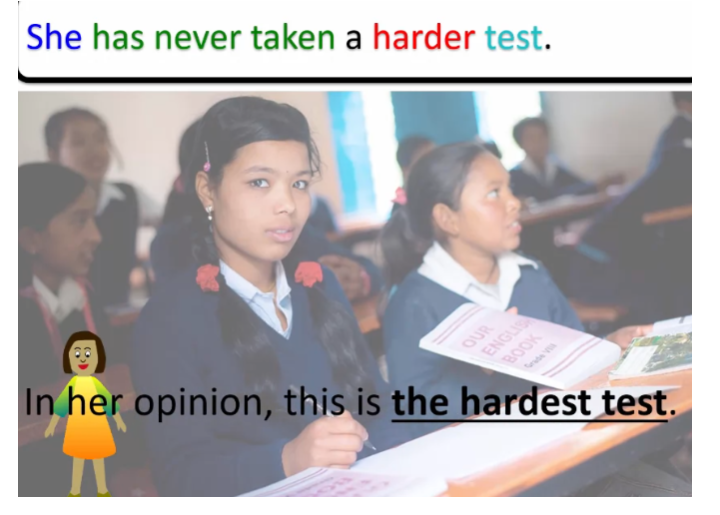
Comparatives and Superlatives Practice
Practice
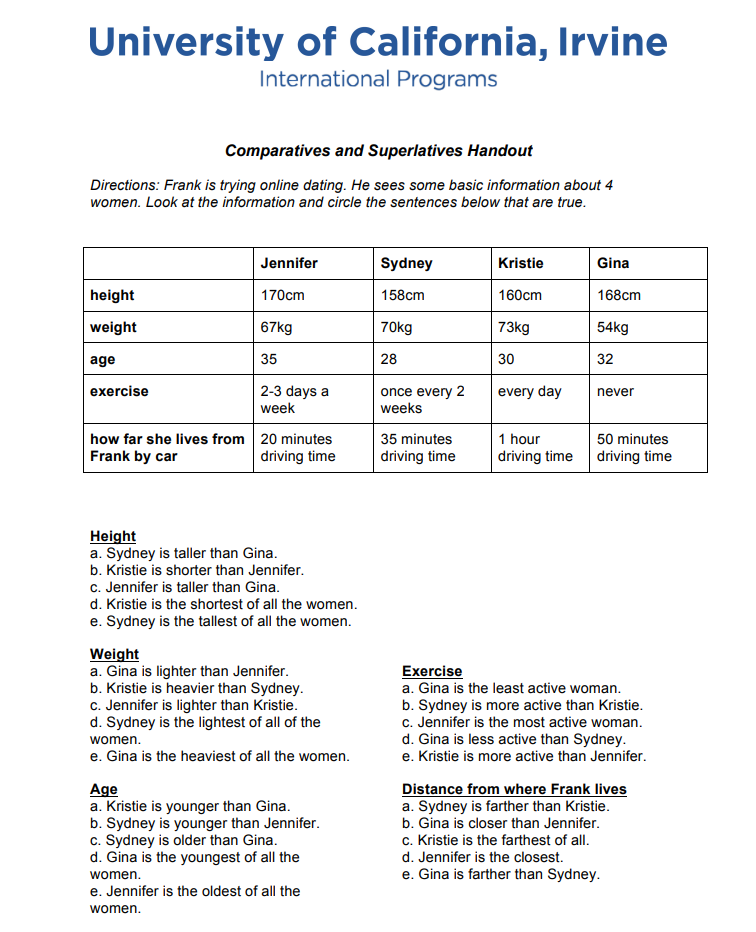
Answer
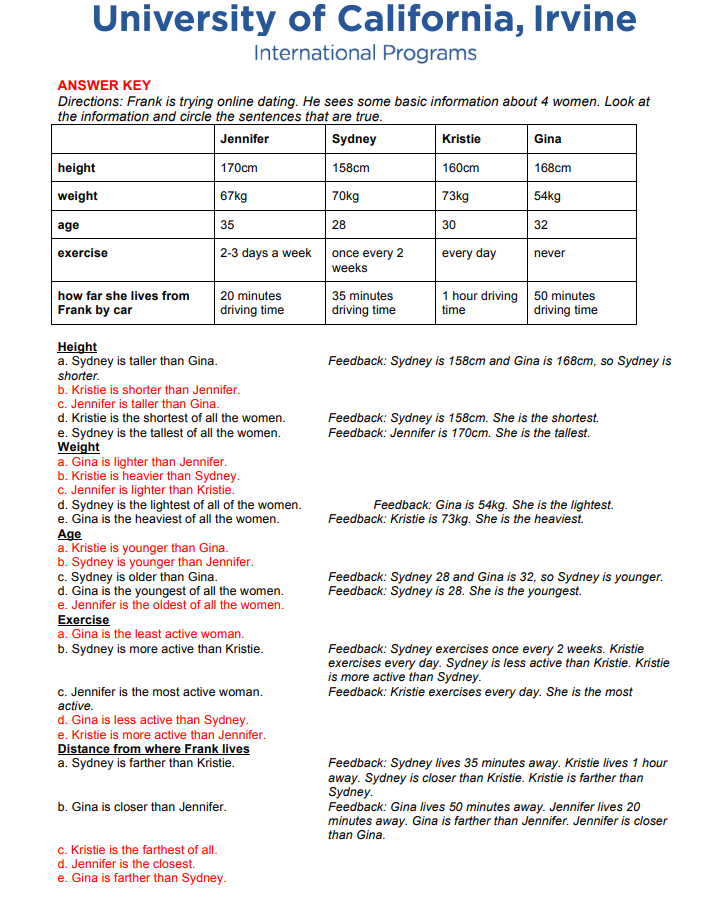
More Comparisons and Superlatives Practice Quiz
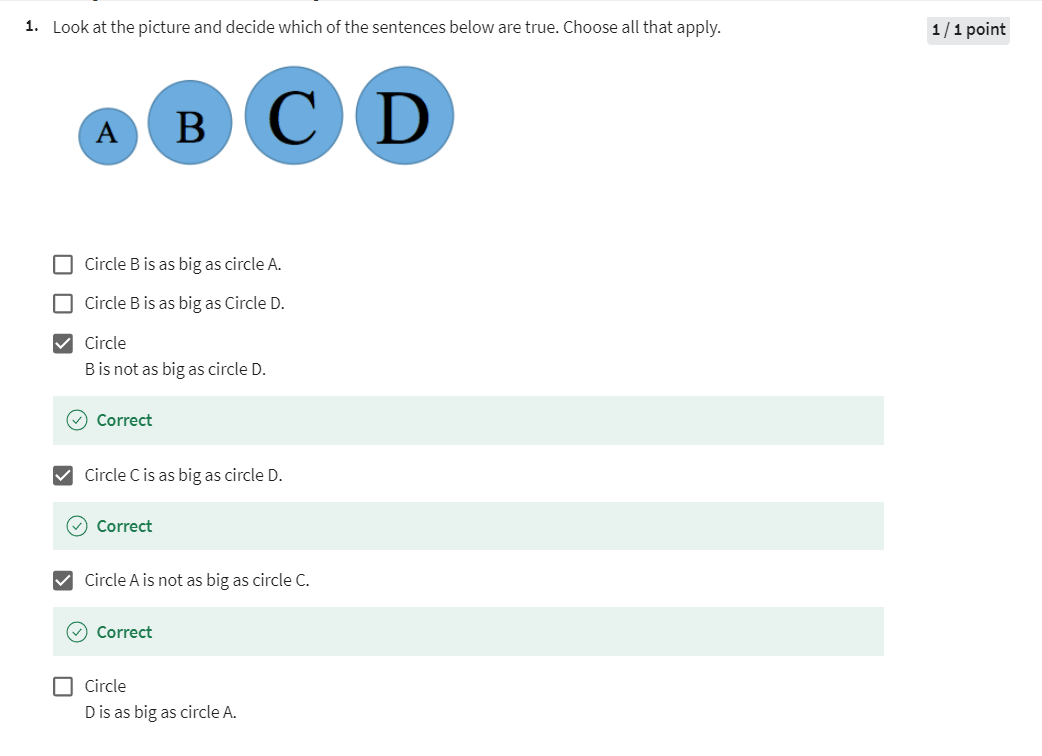
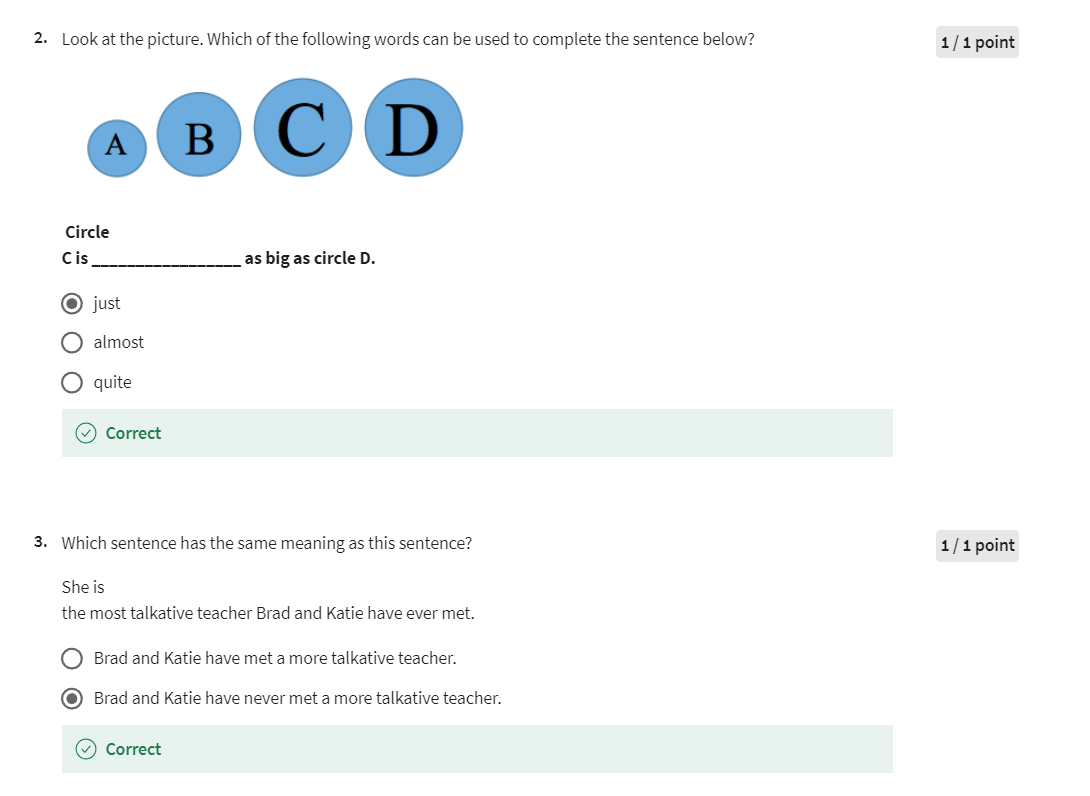
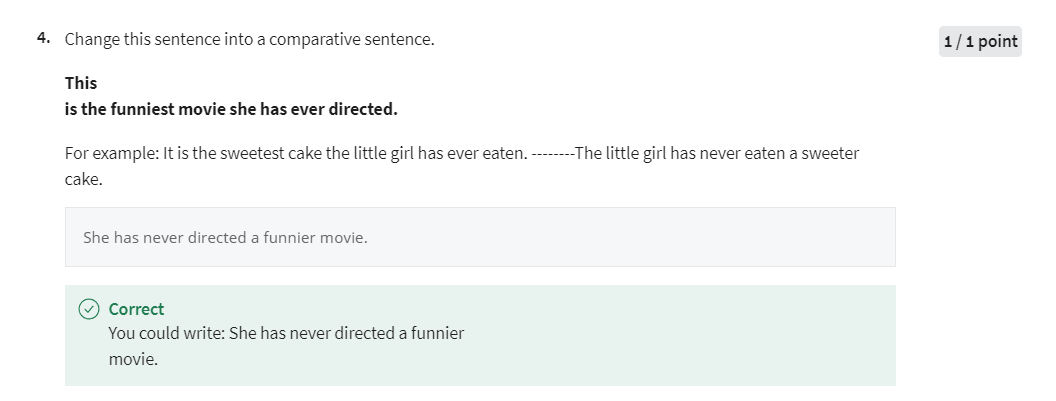
Graded Assignment: Comparatives Assignment
Choose a topic below and then choose two items to compare. (You can think of your own items to compare or choose one of the examples, but make sure you choose items that are different from each other, not similar.)
You will write a short paragraph comparing the two items you pick. Use at least 5 comparative adjectives and 2 superlative adjectives. You can use other adjectives too.
Topic 1: Sports
examples: Kobe Bryant vs. Steph Curry (NBA) / WWF vs. UFC / women’s soccer vs. men’s soccer
Topic 2: Movies
examples: drama vs. comedy / Batman vs. Superman / watching in a theater vs. watching at home
Topic 3: Shopping
examples: Louis Vuitton vs. Gucci / Honda vs. Toyota / online shopping vs. shopping malls
Sample Assignment:
Watching movies at home on TV is so much better than watching movies in a theater. One reason is that at home, it’s more convenient to take breaks while watching if you want to get something to eat or use the restroom. At the theater, it’s more stressful to go get a soda because you might miss the most important part of the movie. Another reason that home is better than theaters is that my home is quieter than the theater. At theaters, people always talk during the film, and it’s noisy. The biggest reason that I like watching movies at home is that I can fall asleep while watching and I don’t have to wake up and drive home. This makes watching movies at home easier than watching at a theater.
My try
Louis Vuitton vs. Gucci
Choosing between Louis Vuitton and Gucci is like picking between classic and trendy. Louis Vuitton’s stuff feels more timeless and classy, while Gucci’s designs are more bold and modern. Louis Vuitton’s famous logo is super recognizable and kinda shows off your status, but Gucci’s designs are often more eye-catching and colorful. Louis Vuitton tends to be pricier since it’s seen as more prestigious, while Gucci can be a bit more affordable for some items. Overall, if you’re into tradition and sophistication, go for Louis Vuitton. But if you like to stand out and be on-trend, Gucci might be more your style. Gucci’s creative director is widely regarded as the most innovative and influential figure in the fashion industry. Louis Vuitton’s flagship store in Paris is the most iconic destination for fashion enthusiasts, showcasing the brand’s rich heritage and timeless elegance.
Graded Quiz
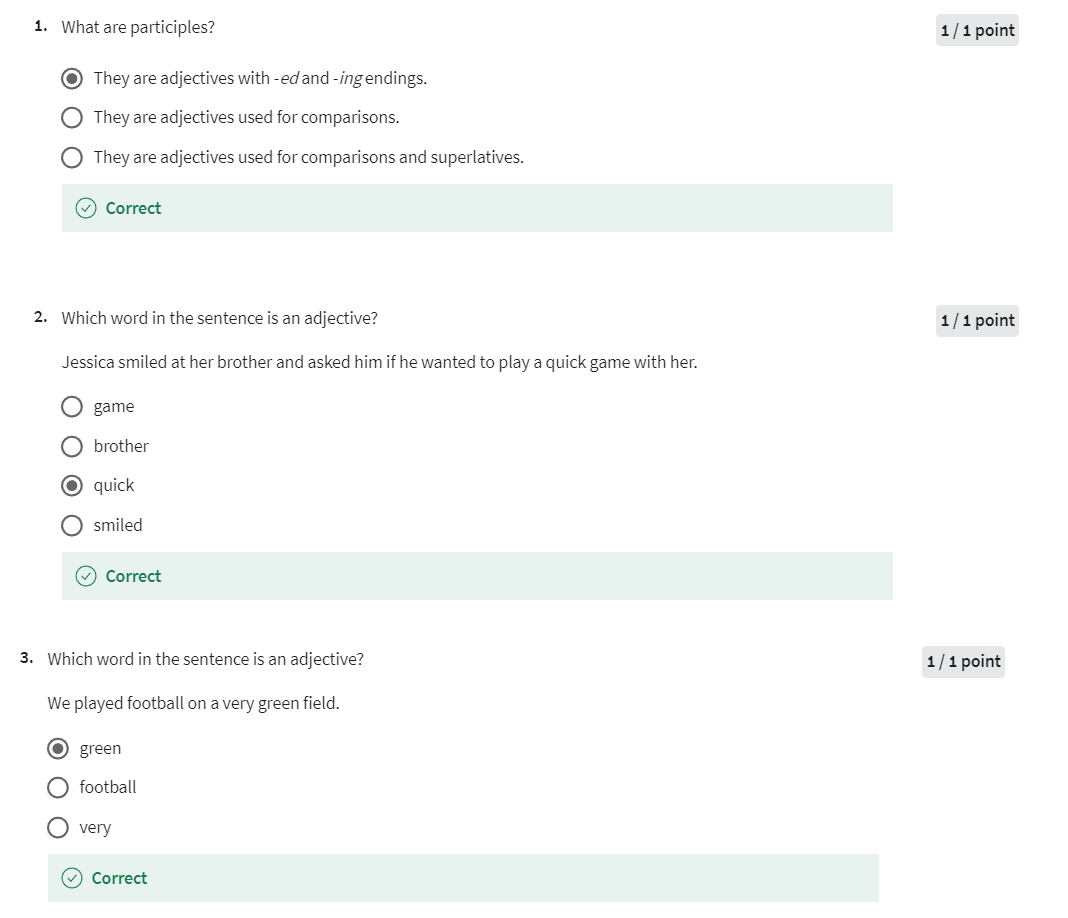
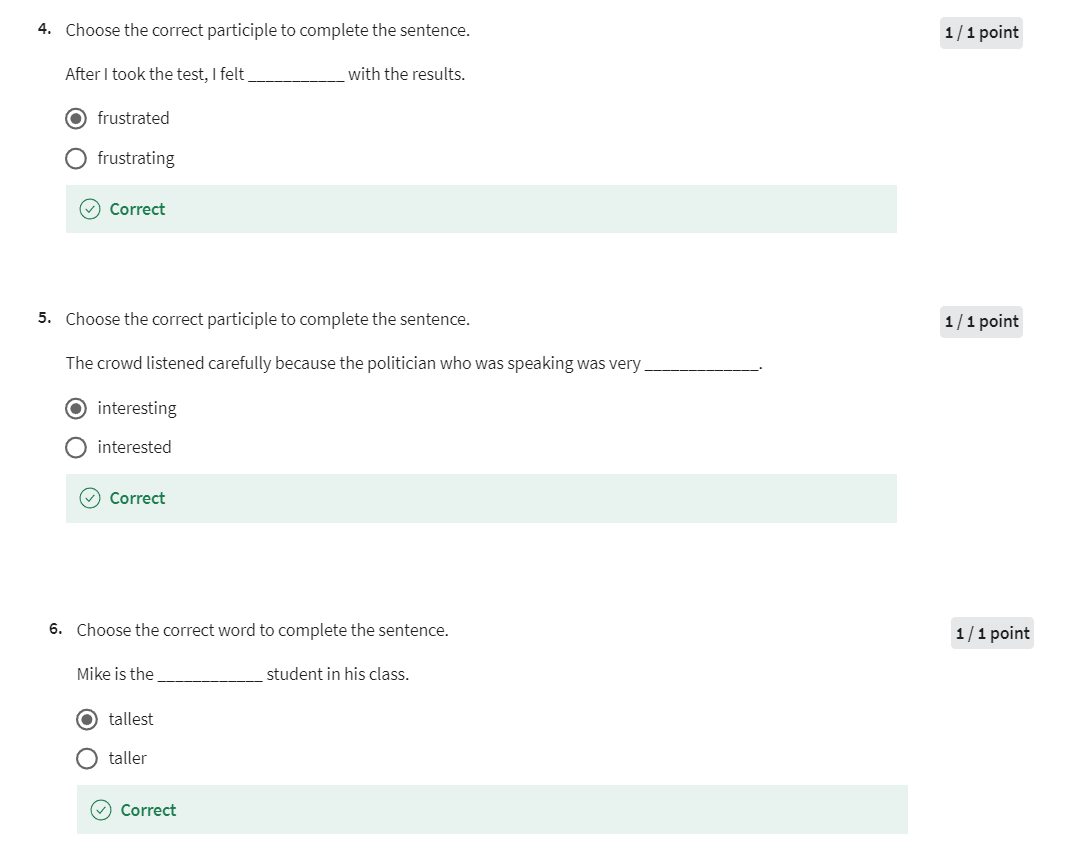
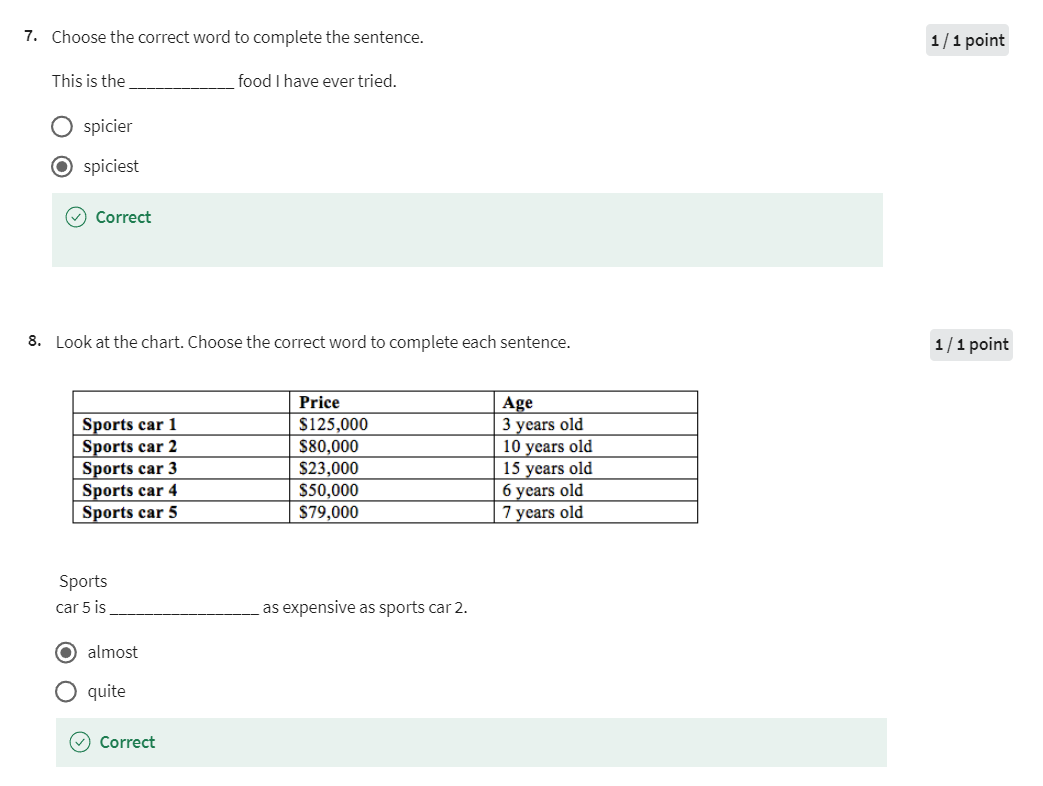
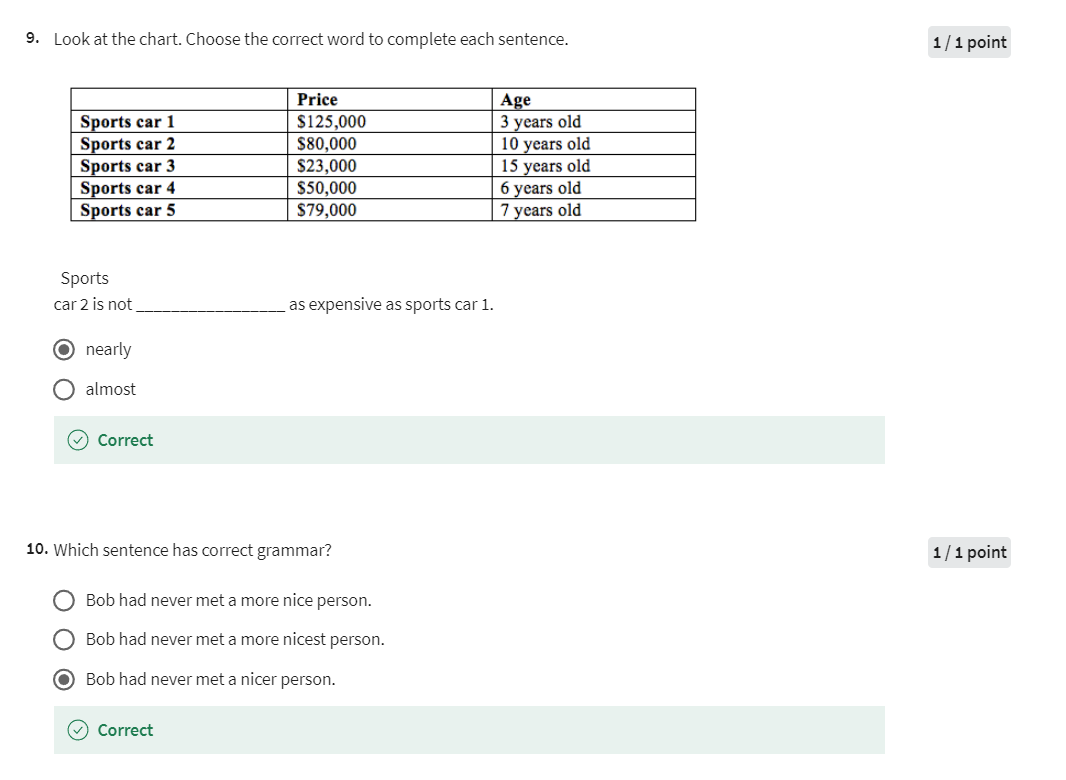
Week 02: Adjective Clauses
In this module, you will learn about adjective clauses. Like adjectives and adjective phrases, adjective clauses describe or modify nouns. You will learn what an adjective clause looks like and how to use them correctly to make your sentences more complex.
Learning Objectives
- identify some adjective clauses in sentences
- explain what adjective clauses are used for
Adjective Clauses Overview Lecture
Hi. For this lesson, I will give a short
overview about adjective clauses. But first,
let’s review what an adjective is. Adjectives are words that describe a noun. Imagine you need to move
to a new apartment. What kind of apartment do you want? A big apartment? A clean apartment? A quiet apartment? Big, clean, and
quiet all describe the noun apartment. They are adjectives. An adjective clause is
similar to an adjective. It also describes a noun but
it looks different. What kind of apartment do you want? Here is an example. I want to live an apartment
that has a big bathroom. That has a big bathroom is an adjective
clause, or we can think about roommates.
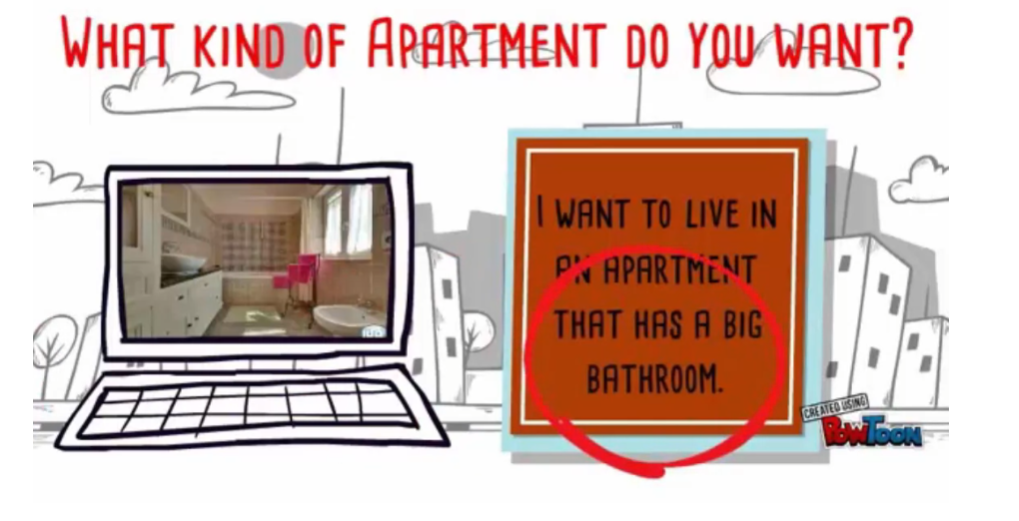
What kind of roommate do you want? I want a roommate who likes to cook. A roommate that pays rent
on time is also important. Who likes to cook and pays rent on time,
are adjective clauses.
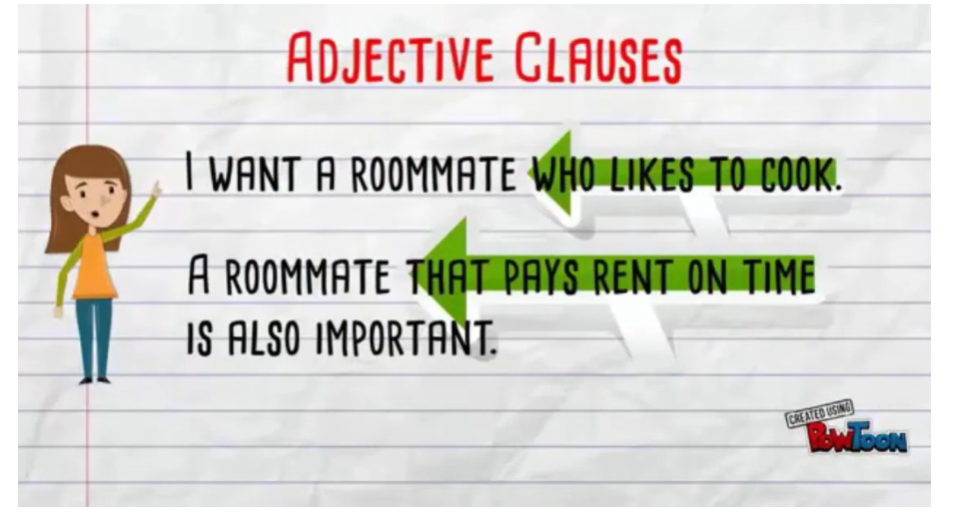
There are two important points. Number one. In adjective clauses there are special
pronouns that connect the main clause to the adjective clause, who,
whom, which, that, and whose. Number two,
adjective clauses also contain a verb. These are important points to
remember when making sentences with adjective clauses. You are ready to watch more videos
in adjective clauses now, enjoy.
Adjective Clause Overview Practice Quiz
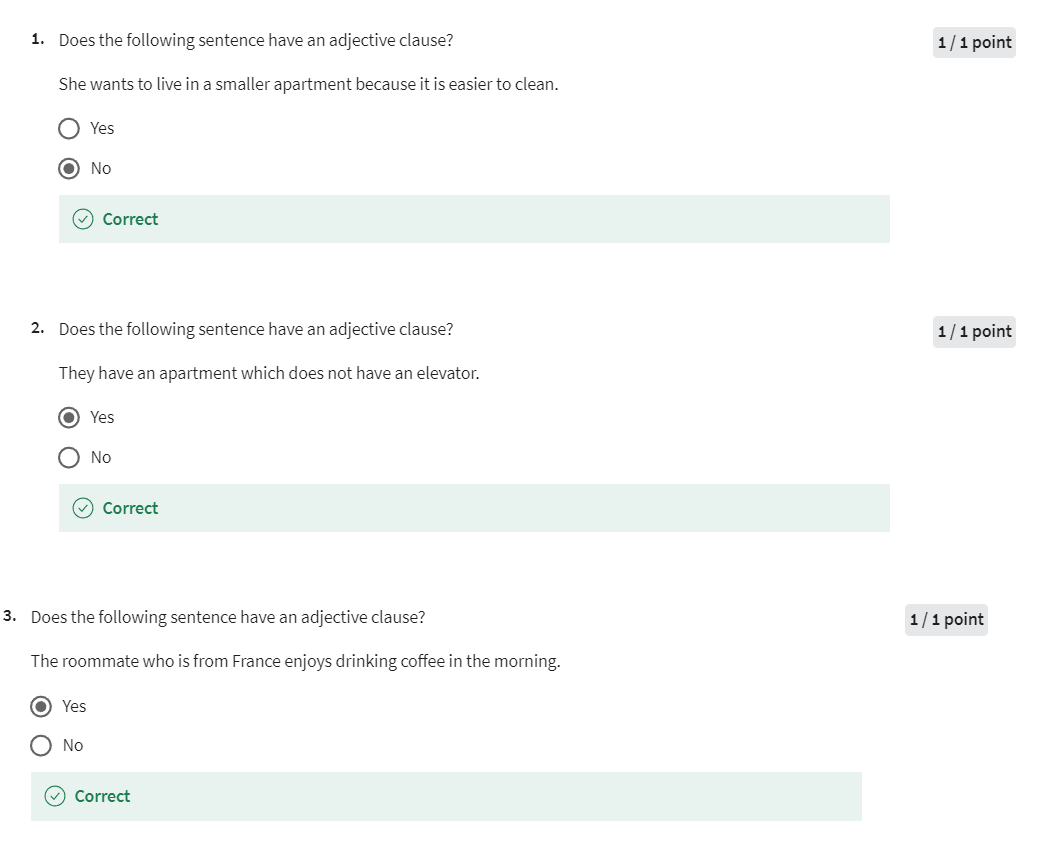

Adjective Clause Practice
Practice
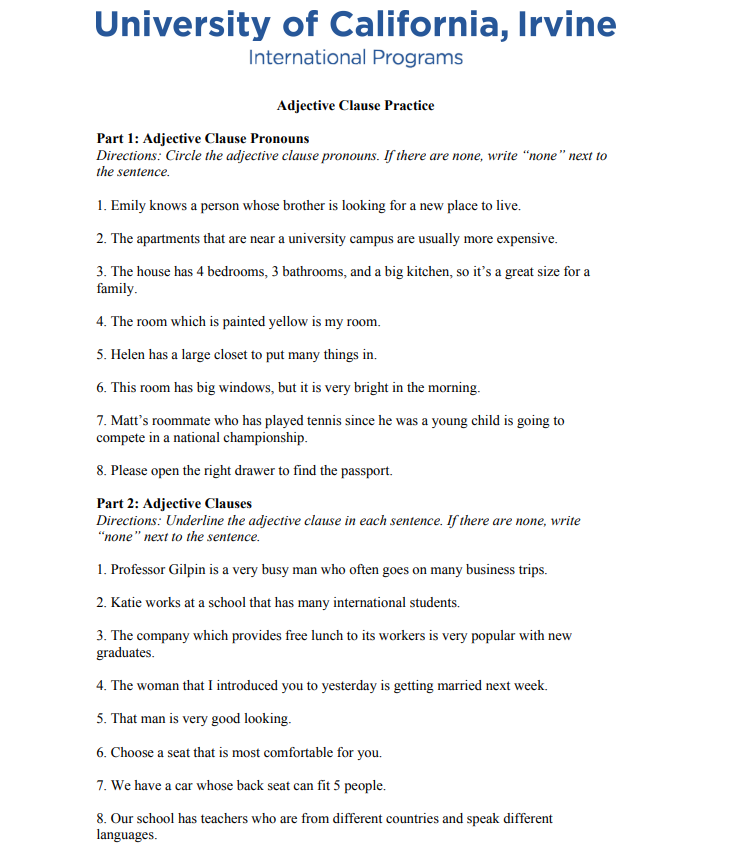
Answer
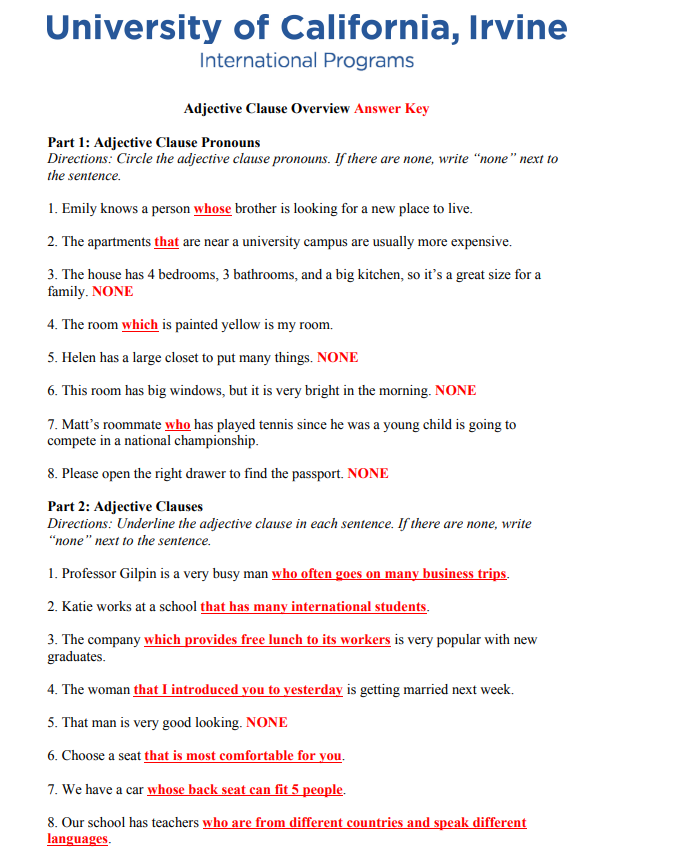
Adjective Clauses with Subject Pronouns lecture
Adjective clauses. Subject pronouns. These five people, who are sitting
next to me, are my siblings. That means my brothers and sisters. I’m the girl who has blonde hair. The man who is wearing a suit
lives in San Francisco. He’s Jodie.
The girl who is wearing a yellow dress is my sister,
Melisa. The guy who is sitting next to my
sister is my youngest brother, Alex. Spencer is my only
brother who has a beard. The man who is sitting
next to Alex is Jamie. I love my family.
Okay, let’s talk about adjective clauses. Adjective clauses are clauses
that describe a noun. Just like adjectives, we use them to talk about nouns. All of the nouns you see here are in red. They are being modified
by the adjective clauses. When we used adjective clauses,
we must have a subject and a verb. That’s what makes it a clause. In this case, the subject is a pronoun. In all of these examples
The subject pronoun is who? Notice that this verb is plural,
why is that?
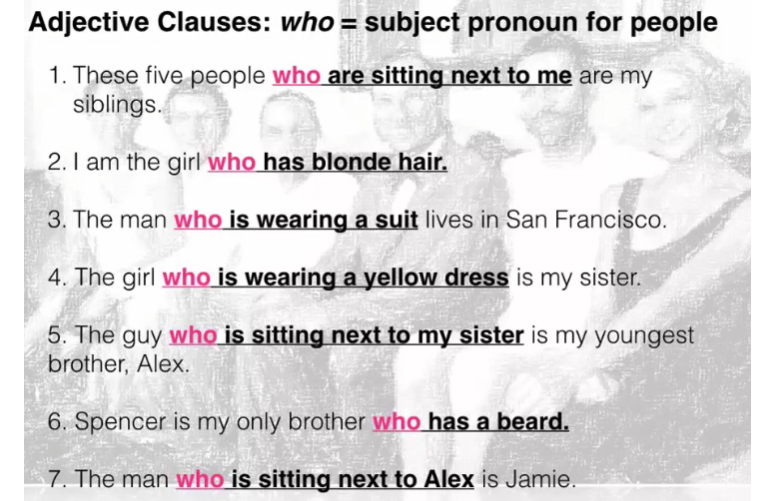
Well, let’s look at the noun that
the adjective clause is modifying, these five people is a plural noun. So we need to make sure we have
a plural verb in our adjective clause. The verb in the adjective clause must
agree with the noun that it’s modifying. Who is a subject pronoun that we use for
people. However, we can also use that for people.
I like to go on trips with my family, but we can’t always agree
where we want to stay. Jamie prefers a hotel that has a pool. I want to stay in a hotel
that is close to the ocean. Jodie and Spencer like hotels
which offer free breakfast. They really like to eat. We can also use Adjective Clauses
to describe things. Notice the pronouns in
these Adjective Clauses. We use that and which for subject pronouns that describe things. Do you remember that that can also be used as a subject pronoun
that describes a person? Notice here too that one
of these example sentences has a plural verb in the adjective clause.

It’s offer, because the adjective clause
is describing a plural noun, hotels. Again the verb in the adjective
clause must agree with the noun that it’s describing. The wise owl has a message for you. Be careful. You cannot take out the subject
pronouns in adjective clauses. It is wrong to say, the man is
wearing a suit lives in San Francisco. What’s missing? Yeah, we need a pronoun, who or that.
Okay, here’s some important things to
remember about adjective clauses with subject pronouns. We must not omit the pronoun. We have to have it. The pronouns we can use for
people are who and that. The pronouns we can use for
things are which and that. And the verb in the adjective clause
must agree with the noun that modifies. Now, you know about adjective
clauses with subject pronouns.
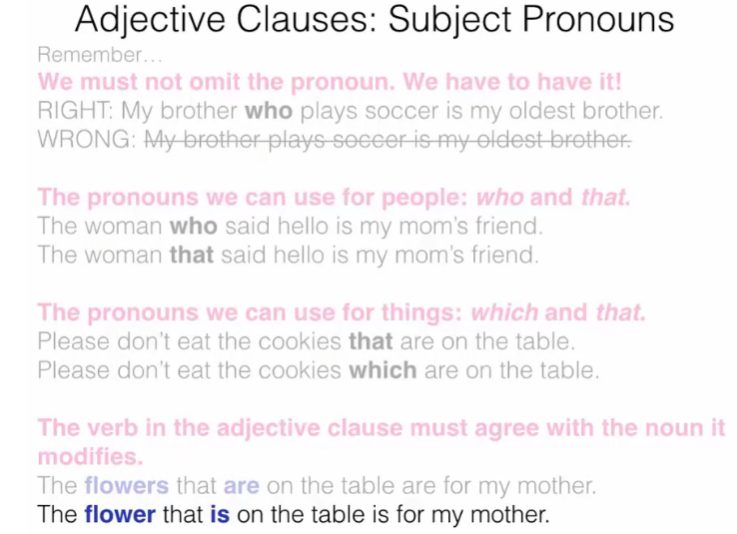
Adjective Clauses with Subject Pronouns Practice Quiz
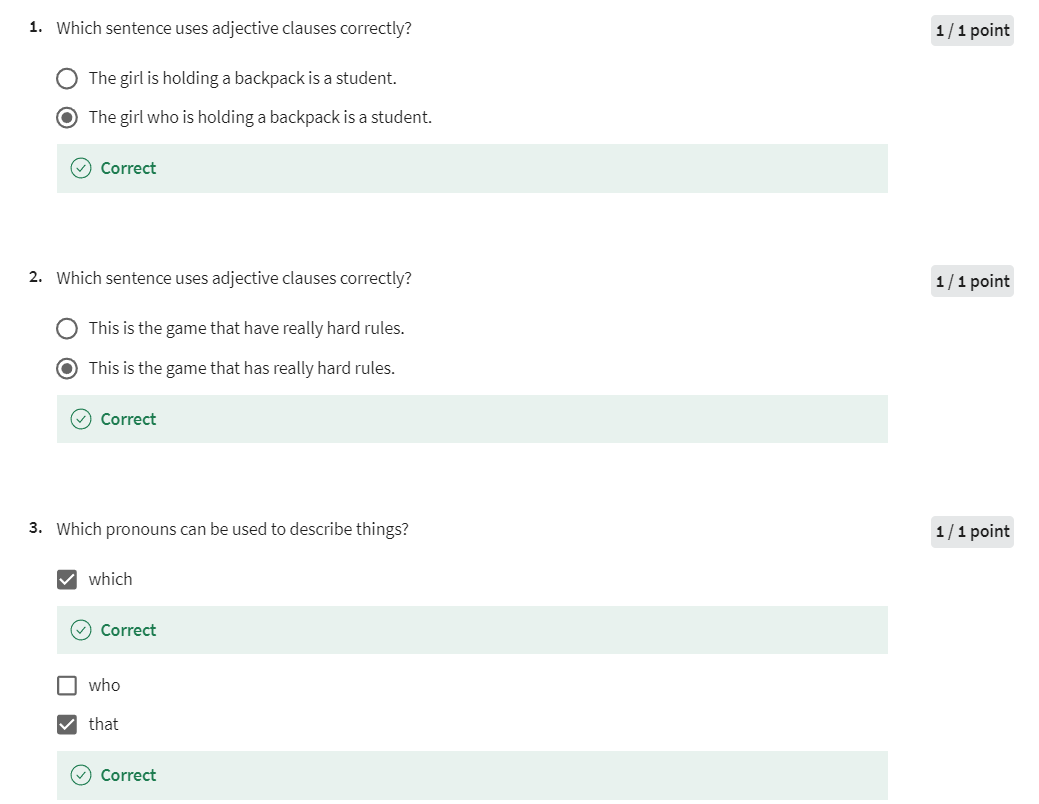
Adjective Clauses with Subject Pronouns Handout
Practice
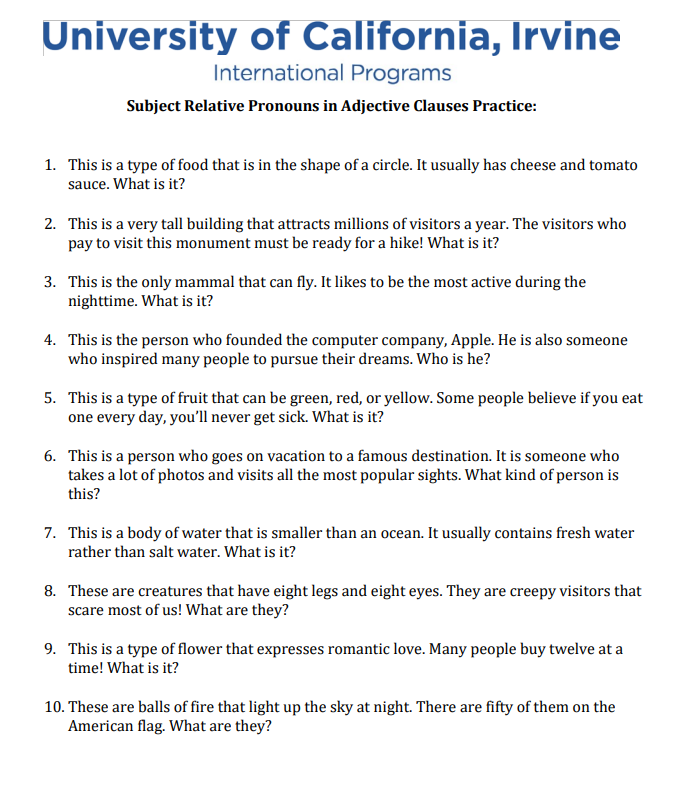
Key

Adjective Clauses with Object Pronouns Lecture
Why I’m her detective Wonk? >> Well, I’m investigating a kidnapping. A very important person is missing you were last seen near Judy’s office,
what were you doing there Emily? >> I didn’t go inside Judy’s office. I walked past her office
to the coffee machine. Did you see anyone else there? >> Yes, I saw a woman. The woman was wearing a purple dress. >> Purple. Are you sure? >> Yes, the woman who I saw
was wearing a purple dress.
In this crime story, you will hear many
adjective clauses with object pronouns. For people, we have four options,
who, whom, that, and nothing. Let’s start at the beginning. The main parts of a sentence
are the subject, verb, and object. To identify them, it might be easiest
to find the verb phrase first. Emily saw a woman. What is the verb? Saw. Everything after the verb phrase
is loosely called the object. In this case, it’s a woman. For people as an object of an adjective
clause, we have these four options. What do we know about this woman? Well, she was wearing a purple dress. We can combine these two ideas together. We replace the object,
a woman, with a pronoun. The woman who Emily saw was
wearing a purple dress. The whom Emily saw was
wearing a purple dress. The woman that Emily saw
was wearing a purple dress. The woman that Emily saw
was wearing a purple dress.
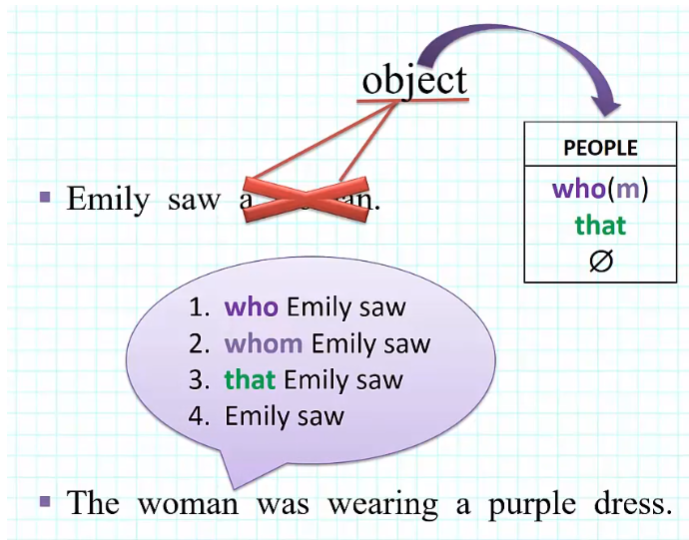
Of these four options,
whom is the most formal. It is more commonly used in academic and professional writing,
not often used in casual conversation.
Note: You just heard that whom is formal and is not used much in conversation. You should also know that who is informal when it is used as an object. You should not use who as an object when you are doing academic writing, which is more formal than speaking.
Let’s take a look at
the new sentence structure. What is the main verb phrase? The main verb phrase is, was wearing. Remember, an adjective clause
is a dependent clause, it is attached to the original noun,
like an arm to your body. In this case,
the original noun is the woman. The subject of this sentence
becomes the woman that Emily saw, the main verb is was wearing, and
the main object is a purple dress. >> She had a purse. The purse was big. The purse that she had was very big. Tell me more about it. >> She was carrying an orange purse. It looked heavy. >> Are you sure? >> Yes, the orange purse,
which she was carrying, looked heavy.
For things, we only have three options,
which, that, and nothing. Again, the main parts of a sentence
are the subject, verb, and object. The woman had an orange purse. The verb is had. The object is an orange purse. For things as the object of an adjective
clause, we have these three options. What else do we know
about this orange purse? The orange purse looked heavy. Let’s combine these two sentences
together by replacing the object, an orange purse with a pronoun. The orange purse which
she had looked heavy. The orange purse that
she had looked heavy. The orange purse she had looked heavy.
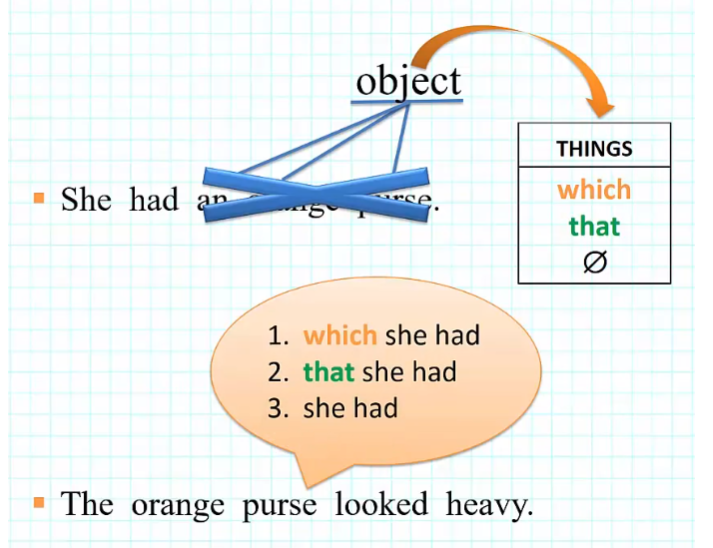
Of these three options,
which is the most formal? It is more often used in
writing than in conversation. Look at the sentence structure. What is the main verb? Looked is the main verb. Had is a dependent verb
that is attached to she, which is attached to the original noun,
the orange purse. The subject is now the orange purse
that she had, the main verb is looked, and the object is heavy.
So, the purse she was carrying
was orange and heavy. Is that correct? >> Yes. >> Liar. No woman in a purple dress
would carry an orange purse. I need to hear the truth. Tell me the truth. Tell me the truth that I need to hear. >> All right. All right. I took cheerleader Peter. I kidnapped cheerleader Peter. I love him too. I kidnapped the man I loved. >> I knew it. I knew it.
Let’s review. Detective Wong said I
need to hear the truth. Tell me the truth. The truth is a thing, an abstract idea. Using the second sentence
as a main clause, Detective Wong turned the first
sentence into an adjective clause. For a thing,
what are the three ways to do this? Tell me the truth which I need to hear. Tell me the truth that I need to hear. Tell me the truth I need to hear. Emily confessed, I love the man,
Cheerleader Peter. I kidnapped him. Emily put this adjective
clause into this main clause. For a person,
what are the four ways to do this? I kidnapped the man who I love. I kidnapped the man whom I love. I kidnapped the man that I love. I kidnapped the man I love. >> Thank you so much for your good work. >> You’re welcome. >> I missed you, cheerleader Peter. I missed you cheering me on as I work. Are you happy to be back?
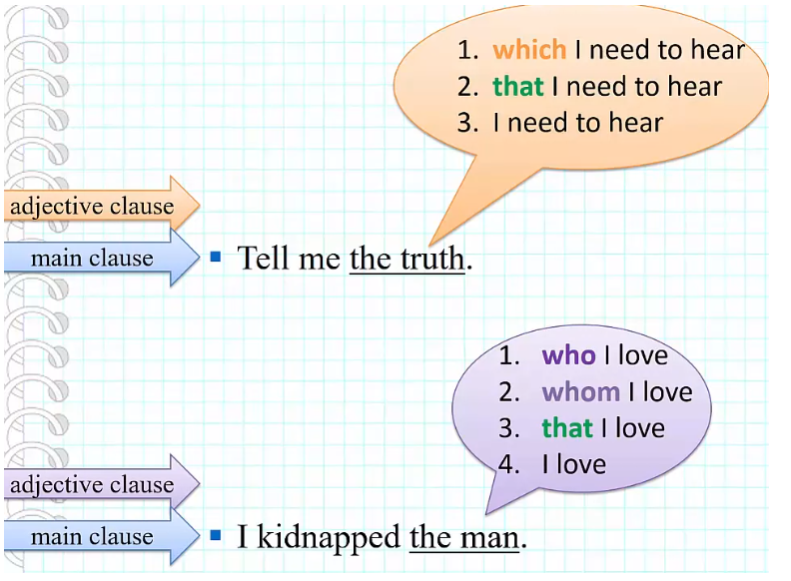
Adjective Clauses with Object Pronouns Practice Quiz
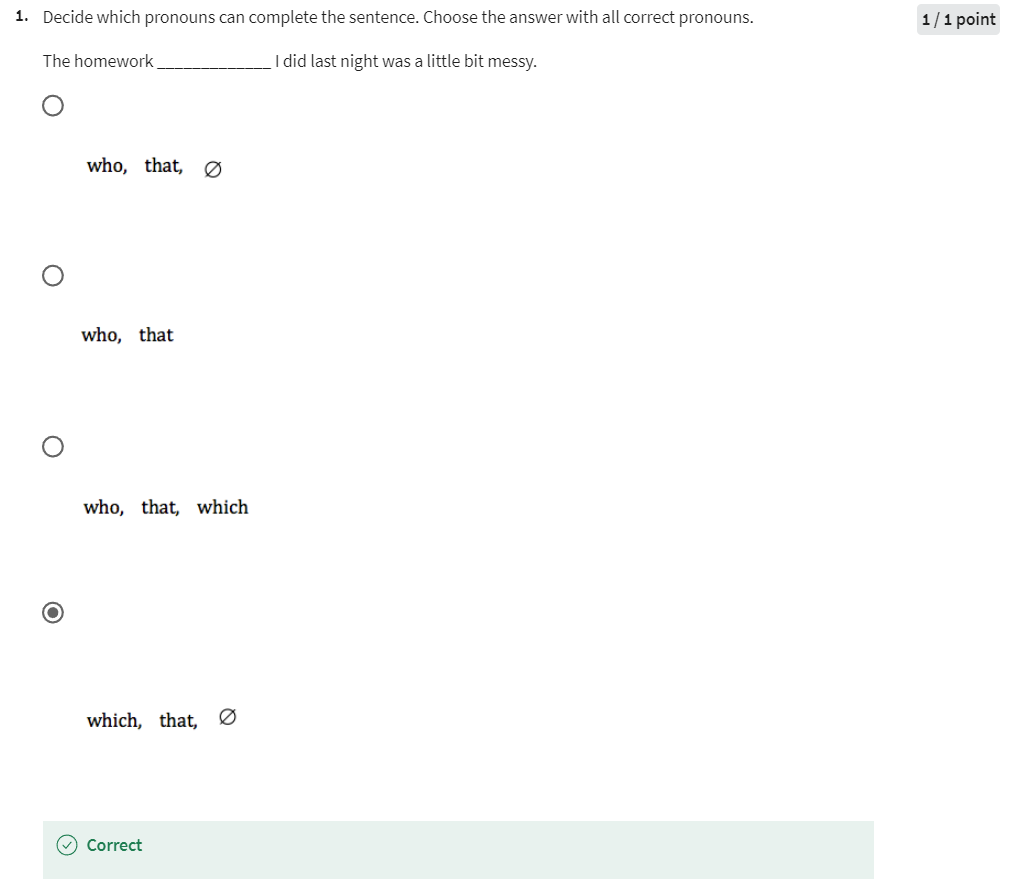
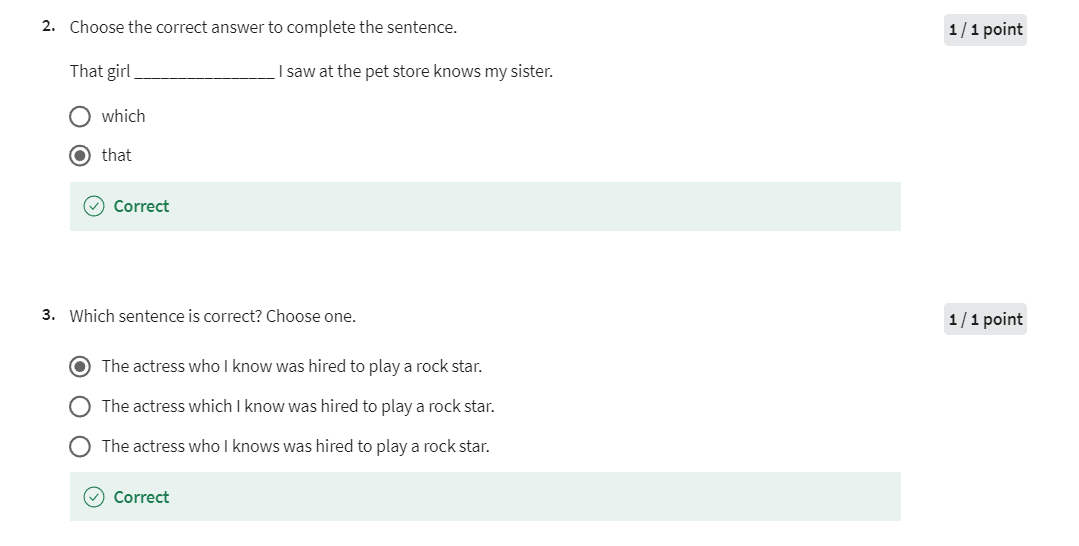
Adjective Clauses with Object Pronouns Handout
Practice
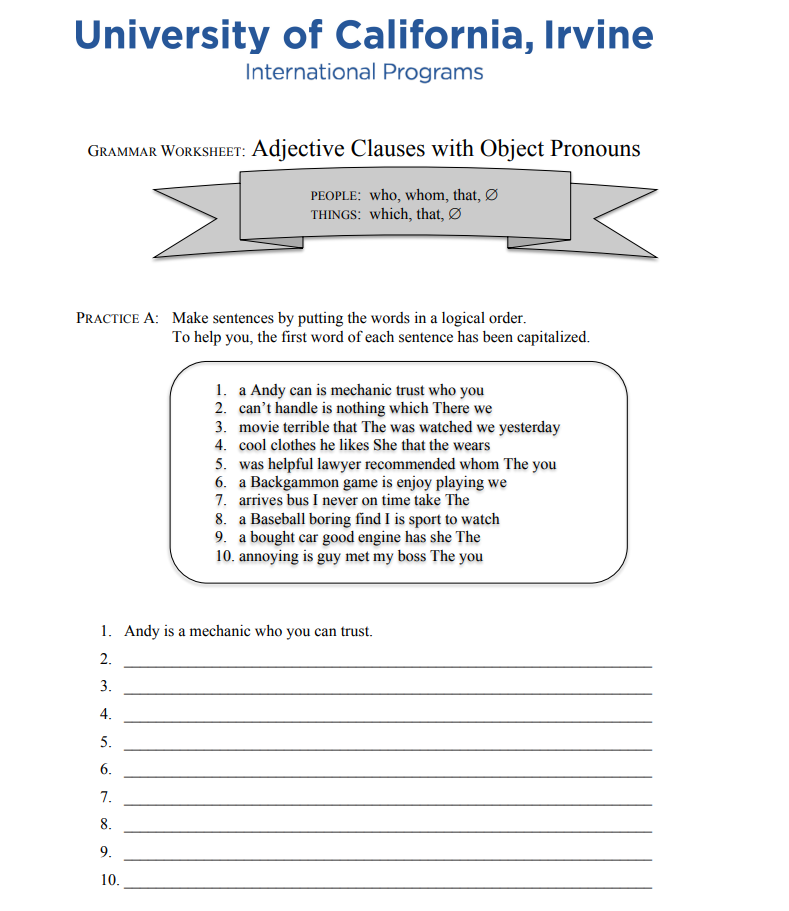
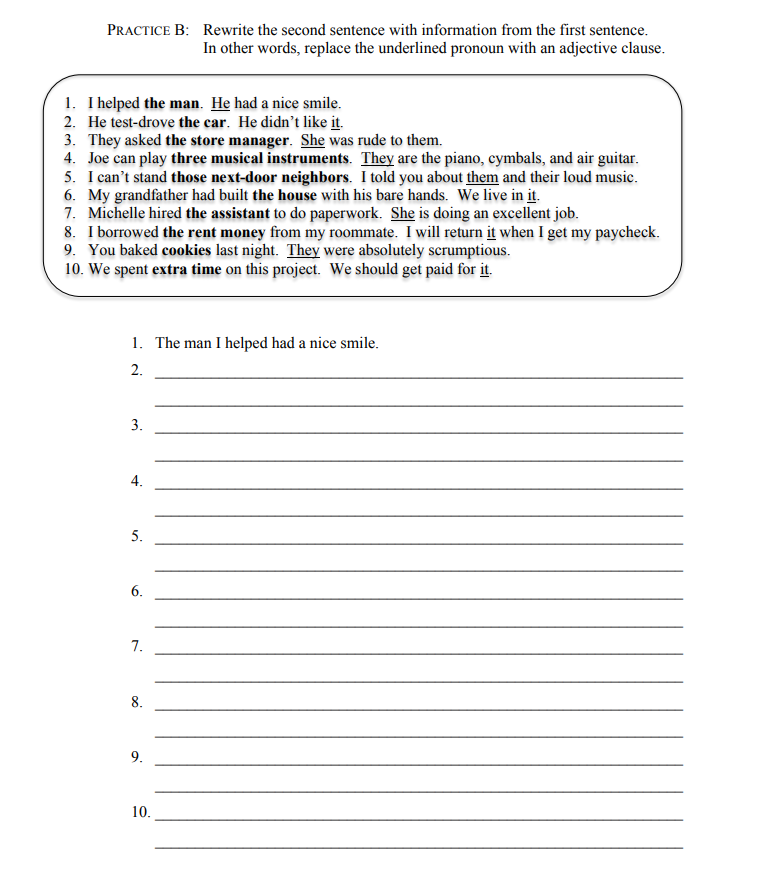
Key
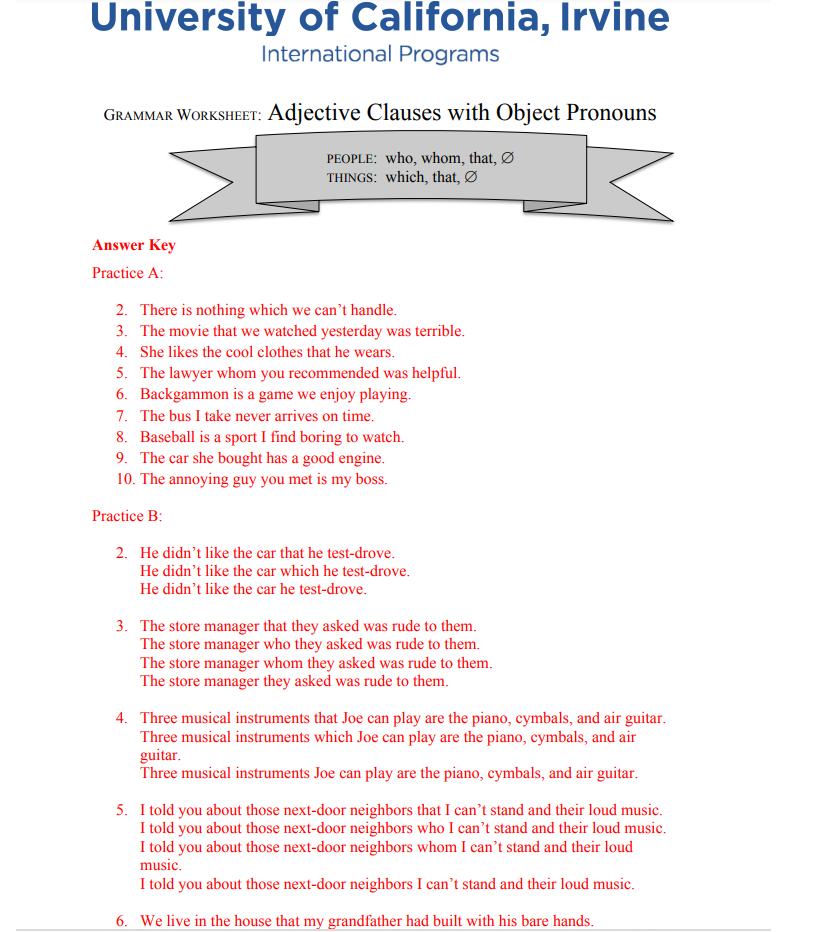
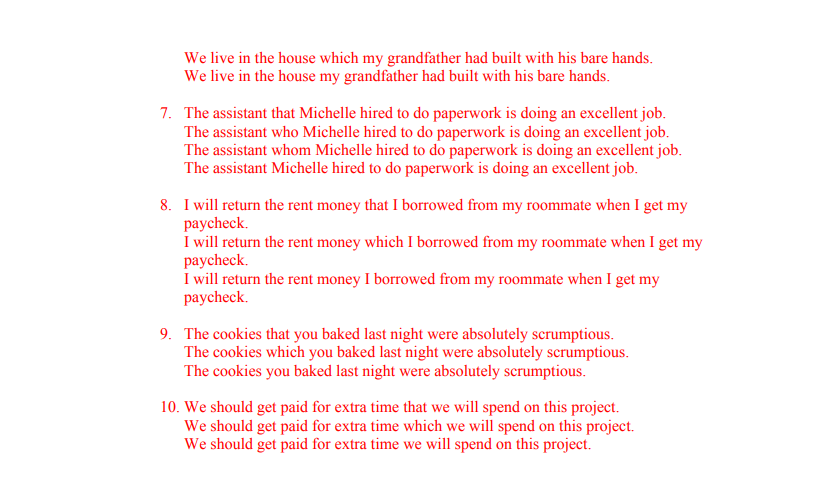
Adjective Clauses with a Possessive Pronouns Lecture
Using Whose in Adjective Clauses. Do you know who this girl is? I’ll give you some hints. This is a photo of a girl
whose eyes could not see. This is a photo of a girl
whose ears could not hear. This is a photo of a girl whose teacher
taught her to read, write, and even speak. And this is a photo of a girl whose
name is famous all over the world. Do you know who this girl is? Right, it’s Helen Keller. Now notice, all of the sentences
begin with the same name clause. This is a photo of a girl, followed by
adjective clauses that are underlined. Now, all of these adjective
clauses begin with the same word, whose, which is a possessive pronoun.
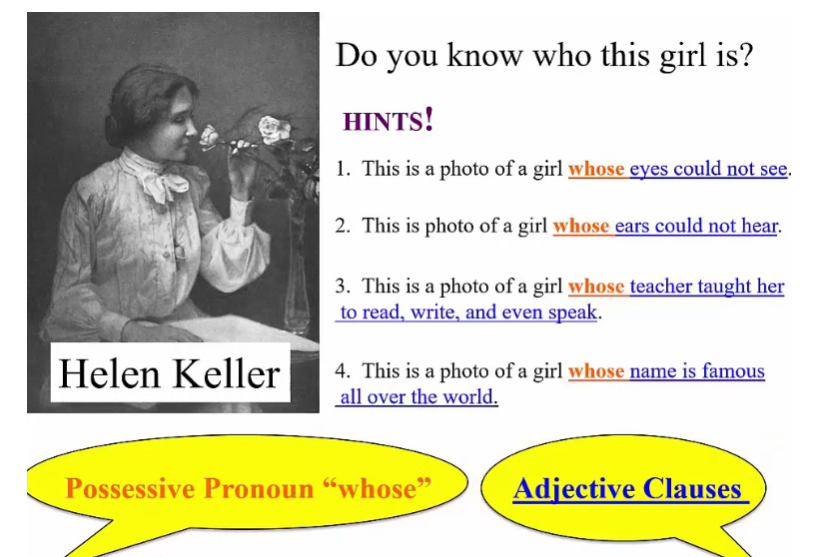
Let’s talk a little bit more
about possessive pronouns. The most common ones are my,
your, her, his, and its, our, and their, which are all
words that represent nouns and that show ownership or relationship. For instance, my hair is messy today. My hair, shows ownership. Mrs. McGee is their teacher. Their teacher, shows relationship.
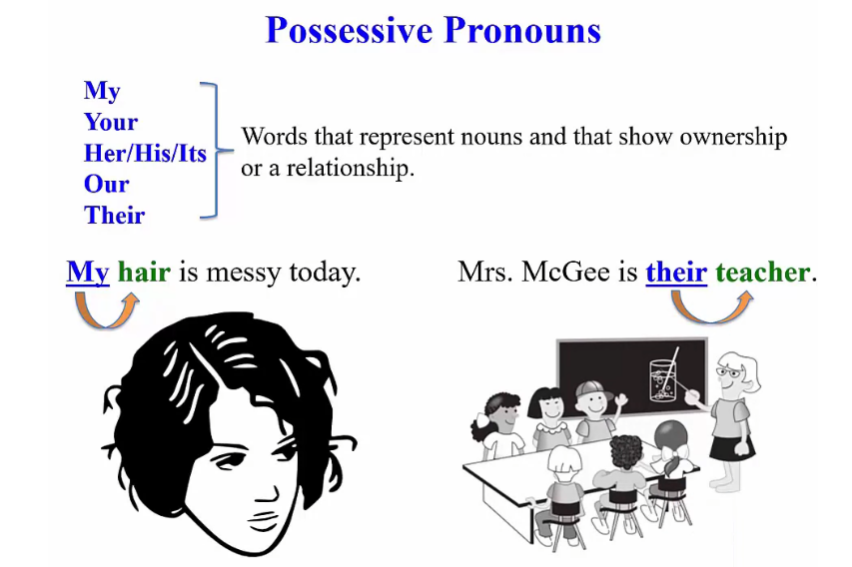
Now, let’s talk about
a different possessive pronoun, one which we use with adjective clauses,
whose. Take a look at this photo. I want to say that I met this man and that there were certain features
about him that were unique. I met a man whose mustache is very long. What else could we say? I met a man whose voice is very deep. Hm, what about this photo? I want to say I saw a dog
with certain features. I saw a dog whose ears are very big. I saw a dog whose legs are short. Do you see a pattern? After whose add the noun. In these examples, we see whose mustache,
whose voice, whose ears, and whose legs, followed by the main
verb and the adjective clause.
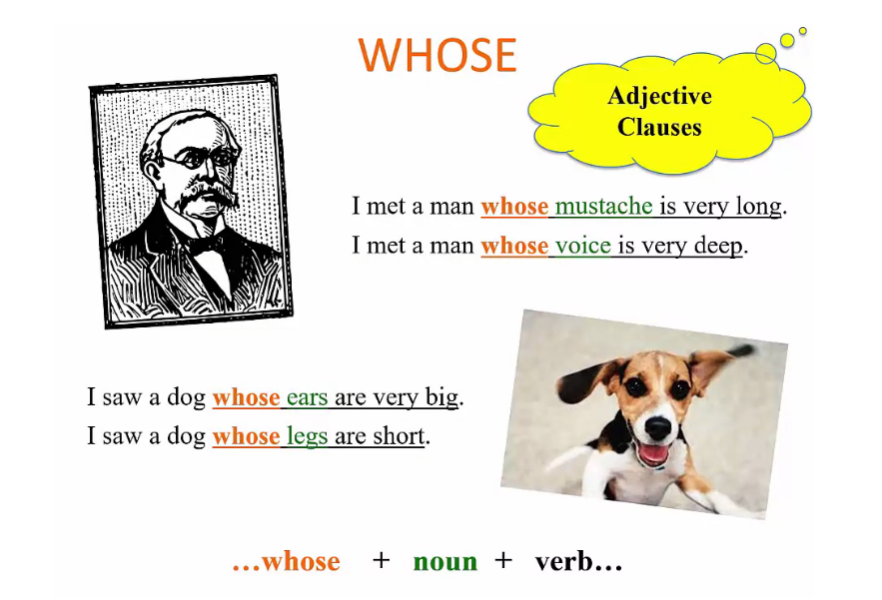
Great. So we know whose represents a noun. In adjective clauses, whose can represent either the subject or
the object of the main clause. This is a photo of a girl
whose eyes could not see. Whose represents girl. I met a man whose mustache is very long. Whose represents man. And I saw a dog whose ears are very big. Whose represents dog. Now, in all three of these sentences, do you think that whose represents the
subject or the object of the main clause? Good job. It’s the object.
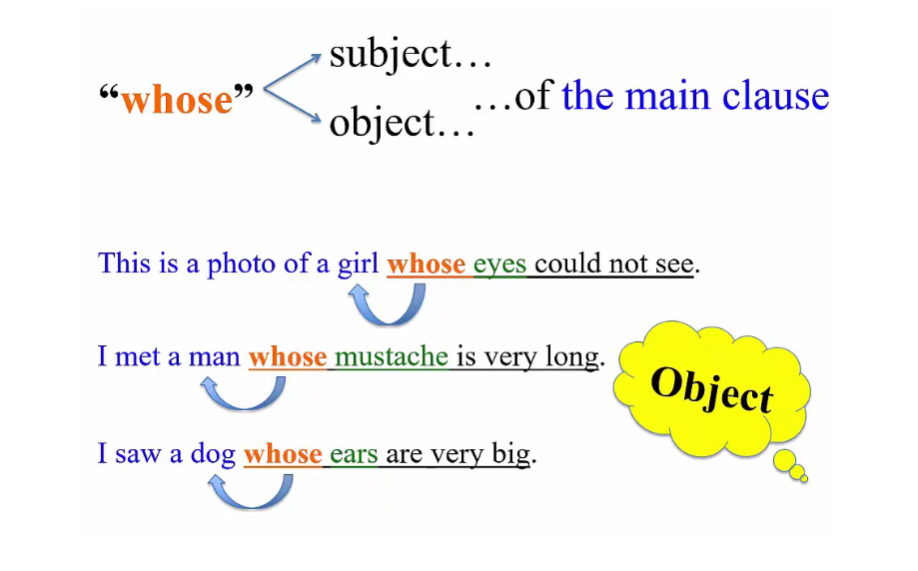
But what about the subject? Take a look at this clause. The boy is the youngest. This is going to be our main clause, and notice that the boy is
the subject of the clause. We could say, the boy whose
shirt is red is the youngest, and whose represents the boy,
the subject of the main clause. Here’s another example. The girl is the fastest. The girl whose hair is
black is the fastest. Whose represents girl,
the subject of the main clause.
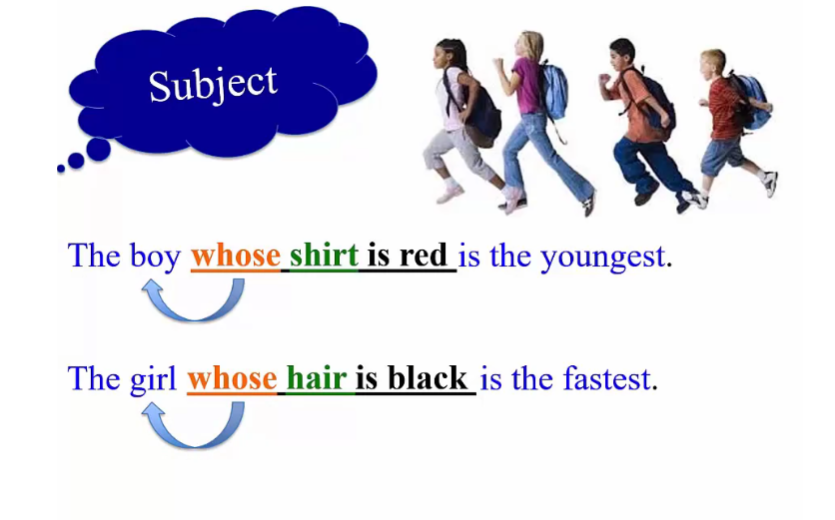
Great. Now, be careful,
because the possessive pronoun, whose, is not the same as who’s,
which is a contraction of who is. See if you can fill in the blanks
with the correct whose. Number one, the lady blank holding
her belly is eight months pregnant. Number two, the lady blank belly is
very round is eight months pregnant. Did you figure it out? Number one, the lady who’s, or who is, holding her belly is
eight months pregnant. Number two, the lady whose belly is
very round is eight months pregnant. Well, I want to thank you for watching. We’ll see you next time.
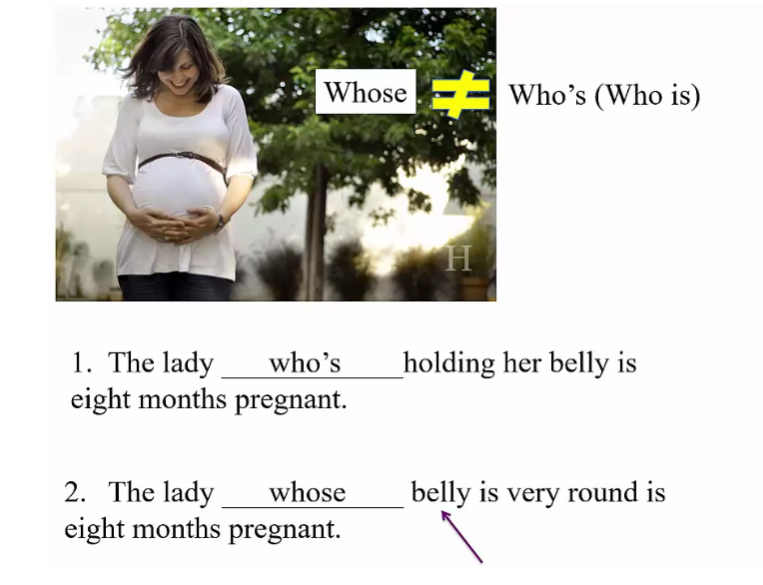
Adjective Clauses with a Possessive Pronoun Practice Quiz
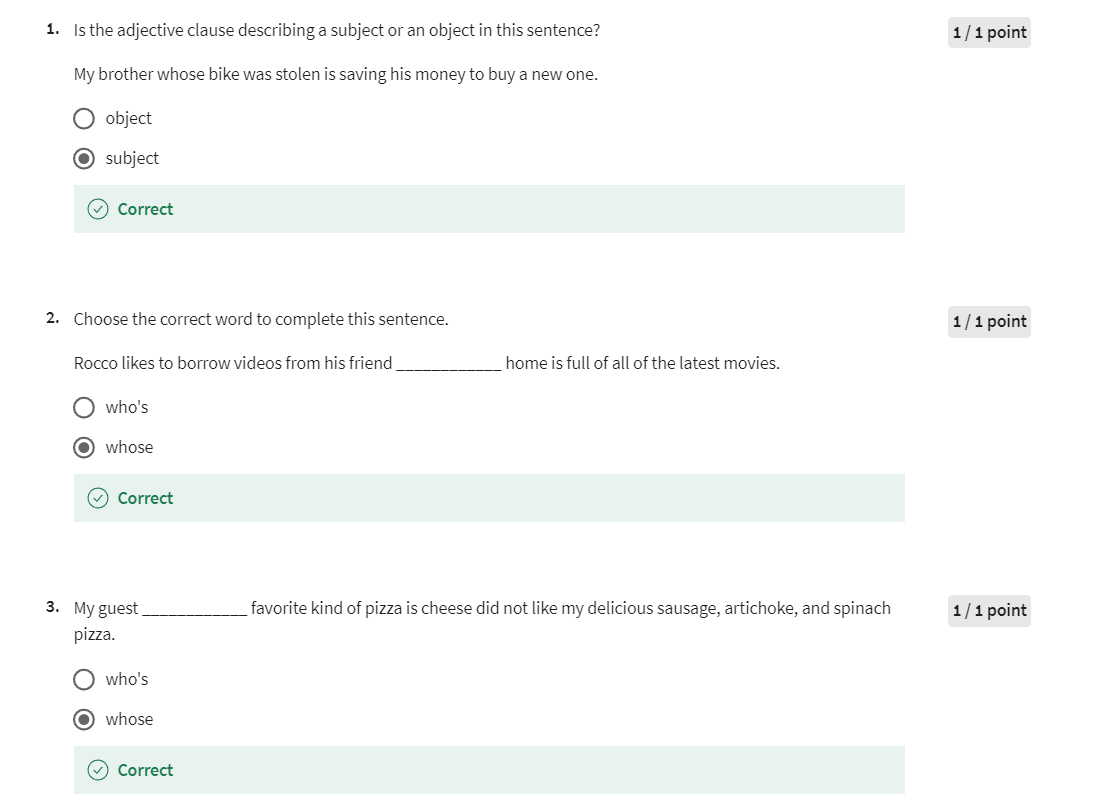
Graded Assignment: Adjective Clauses Assignment 1
Write 4 sentences with adjective clauses that have subject pronouns and 4 sentences that have object pronouns. Then write 2 sentences that have adjective clauses with the possessive pronoun. Make sure your sentences have correct word order and subject-verb agreement. Try to make your 10 sentences interesting.
Example of a sentence with an adjective clause with a subject pronoun:
This is the sandwich that tastes like pizza.
Example of a sentence with an adjective clause with an object pronoun:
You are a person who I like spending a lot of time with.
Example of a sentence with an adjective clause with a possessive pronoun:
My roommate is the guy whose boss called him lazy and messy.
My Try
Adjective clauses with subject pronouns:
- She is the girl who always arrives early to class, impressing everyone with her punctuality.
- They are the students who participate actively in group discussions, making the learning experience more engaging for everyone.
- He is the coach who never gives up on his players, motivating them to strive for excellence both on and off the field.
- We are the friends who share everything together, from secrets to laughter, creating unforgettable memories.
Adjective clauses with object pronouns:
- I have a dog that I rescued from the shelter, and she has brought so much joy into my life.
- He bought a car that his parents helped him pay for, and now he enjoys the freedom of having his own transportation.
- She received a gift that her grandmother knitted for her, and she treasures it dearly.
- They attended a concert that their favorite band performed at, and the experience was absolutely unforgettable.
Adjective clauses with possessive pronouns:
- Her brother is the musician whose songs have been listened to millions of times on streaming platforms.
- My cousin is the artist whose paintings were displayed in a gallery downtown last month.
Graded Quiz
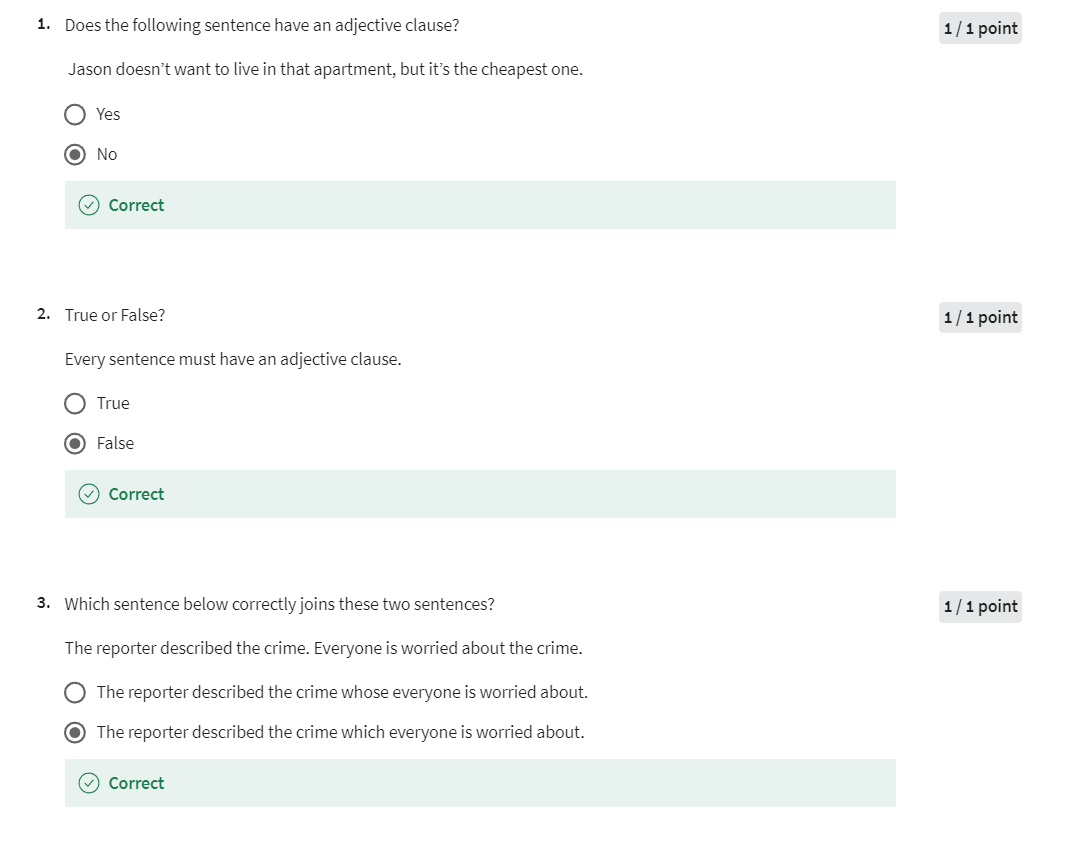
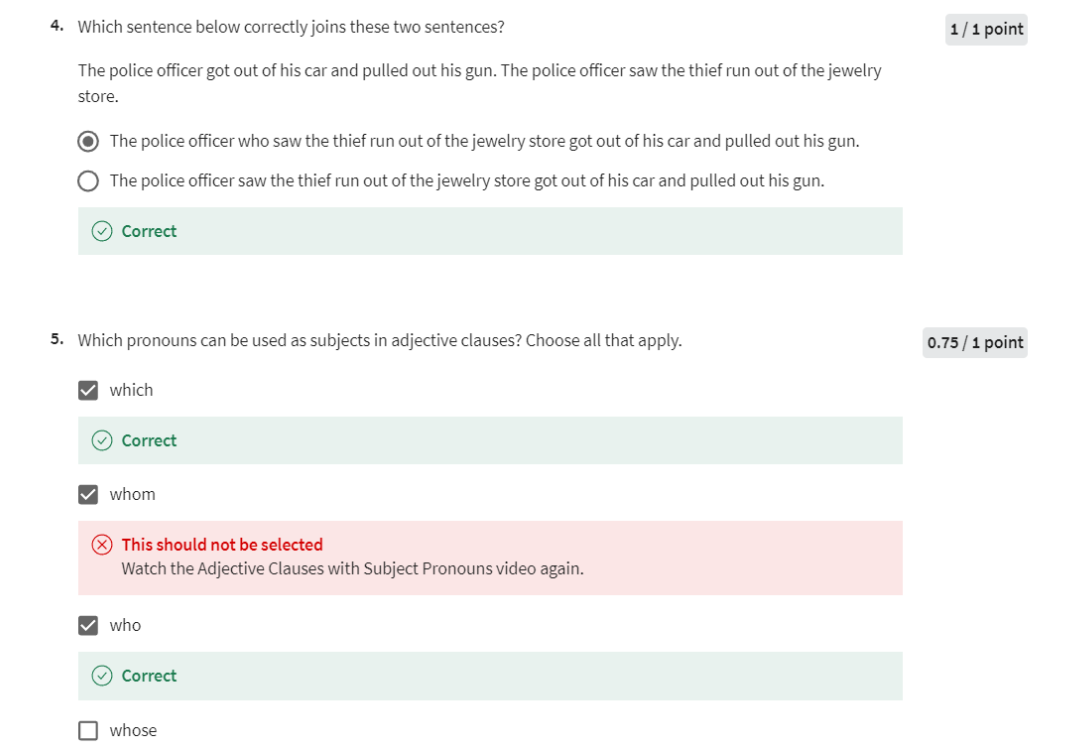
第五题,不应该选whom
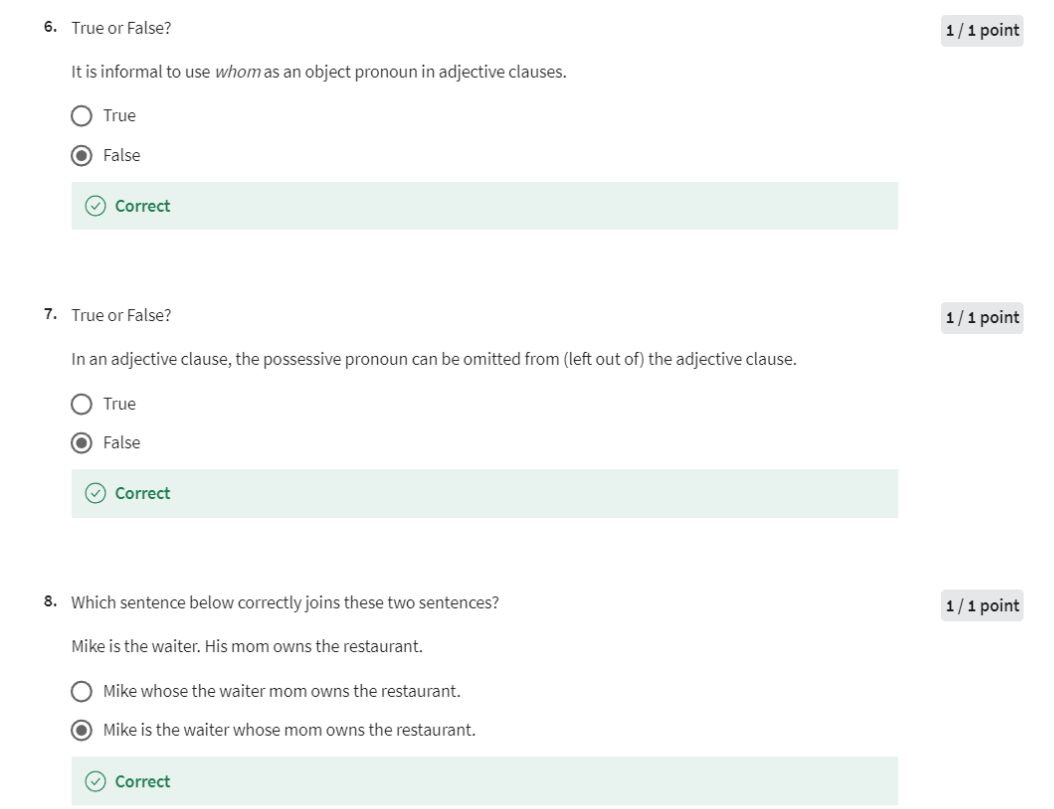
Week 03: More Adjective Clauses
Now, you’ll learn about some other common types of adjective clauses. Keep in mind what you already know as it will help you learn these new structures.
Learning Objectives
- use prepositions correctly in adjective clauses
- identify several different ways to express the same meaning with prepositions in adjective clauses
Adjective Clauses with Prepositions
Which one of the following
sentences is wrong? That is the teacher to
whom I spoke yesterday. That is the teacher whom
I spoke to yesterday. That is the teacher who
I spoke to yesterday. That is the teacher to
that I spoke yesterday. That is the teach that
I spoke to yesterday. That is the teacher I spoke to yesterday. The answer is number 4 is wrong.
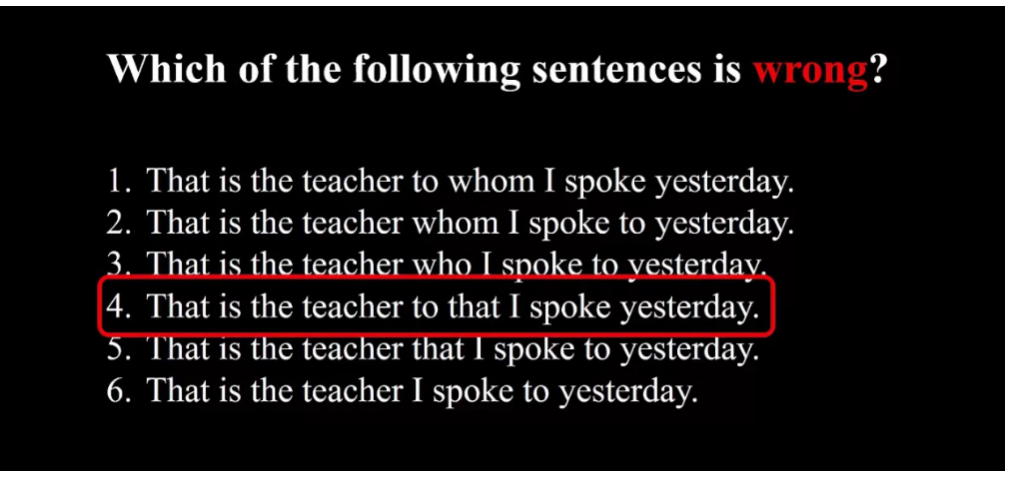
In this lesson, you will learn
how to correctly make sentences using adjective clauses with prepositions. With each of the sentences from before,
there are two parts. The main clause in blue, and
the adjective clause in red. When we look closely at the clauses
we can see two sentences. That is the teacher and
I spoke yesterday to her. Where the red sentence tells us
more about the first sentence. In the first part, teacher and
her mean the same thing. And to is the preposition. Now, to put the sentences
as one adjective clause sentence to her needs to
move right after teacher. Then we need to replace her with
an adjective clause pronoun such as whom. We can also move the preposition to. After the verb spoke. Instead of whom,
we can also use the informal who. We can even replace who with that. We can leave out the adjective
clause pronoun completely.

So we have that is the teacher
I spoke to yesterday. When we talk about people and
adjective clauses, we can use whom, who, that, or nothing. But if you want the preposition right
after the noun being described, for example here the teacher,
then the only choice we have is whom.

Here is another example with
the main clause in blue and the adjective clause in red. Here is the email about which I told you. Here is the email which I told you about. Here is the email that I told you about. Here is the email I told you about.
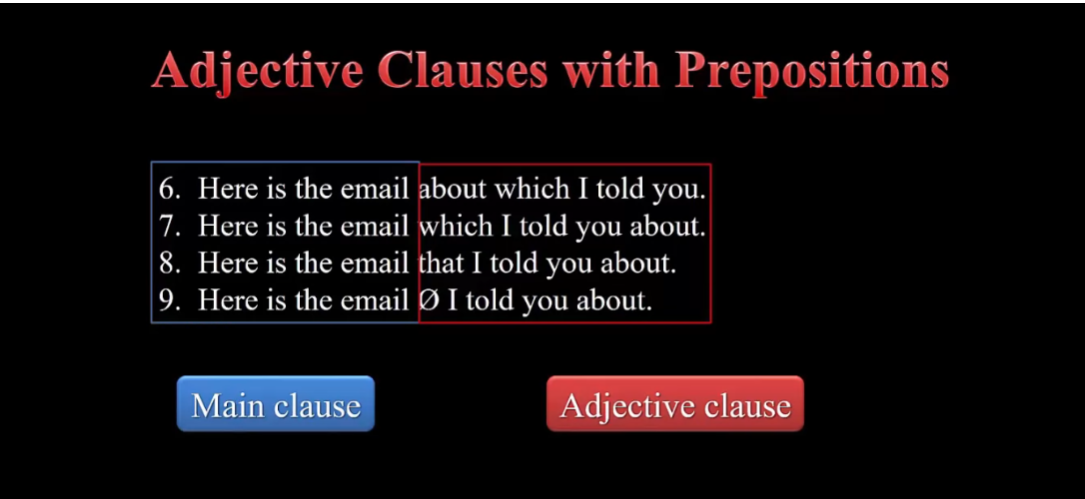
Again, when we look at the clauses
more closely we can see two sentences. Here is the email, and
I told you about it. Where the red sentence tells us
more about the first sentence. In the first part email is the same as it. And about is the preposition. The adjective clause sentence tells us
more about the email in the main clause. As in the last example, we need to move the preposition
close to the noun we are describing. But, this time we replace it with which. Or we can move about the end
of the adjective clause. We can change which to that. Or even take it out completely. Now when we describe
things instead of people, we have to use which, that, or nothing. But after the preposition,
we must use which only.
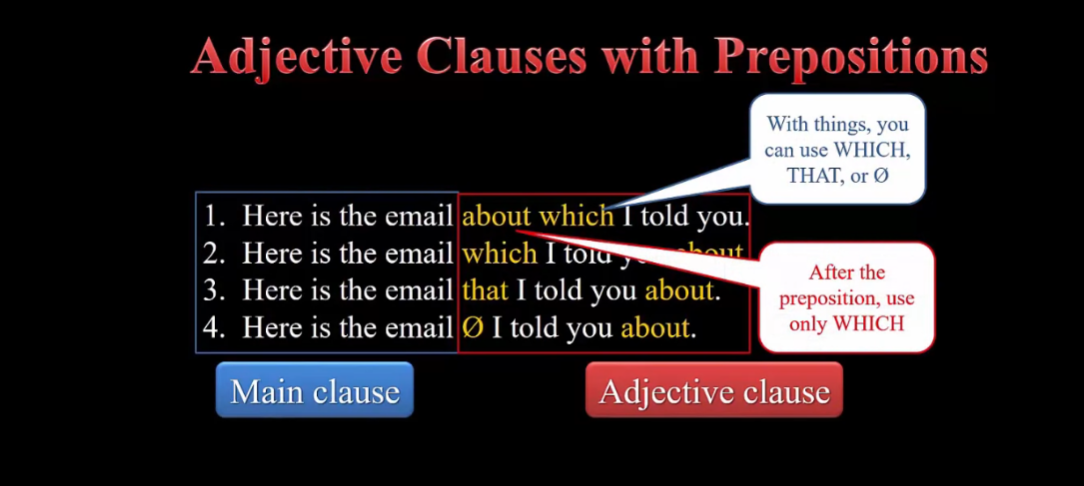
Let’s look at another example. I called the man to whom I sent the email. I called the man whom I sent the email to. I called the man who I sent the email to. I called the man that I sent the email to. I called the man I sent the email to. But in reality, the most common written
form of the sentence is the one with that. But in speaking, the most common
form is the one without a pronoun. In this lesson,
you learned how to correctly make sentences with adjective
clauses with prepositions. Thanks for listening.
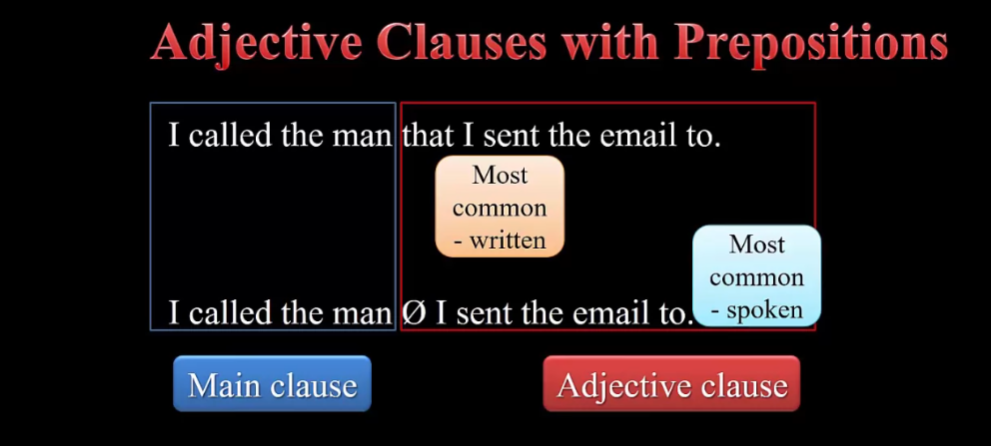
Adjective Clauses with Prepositions Practice Quiz
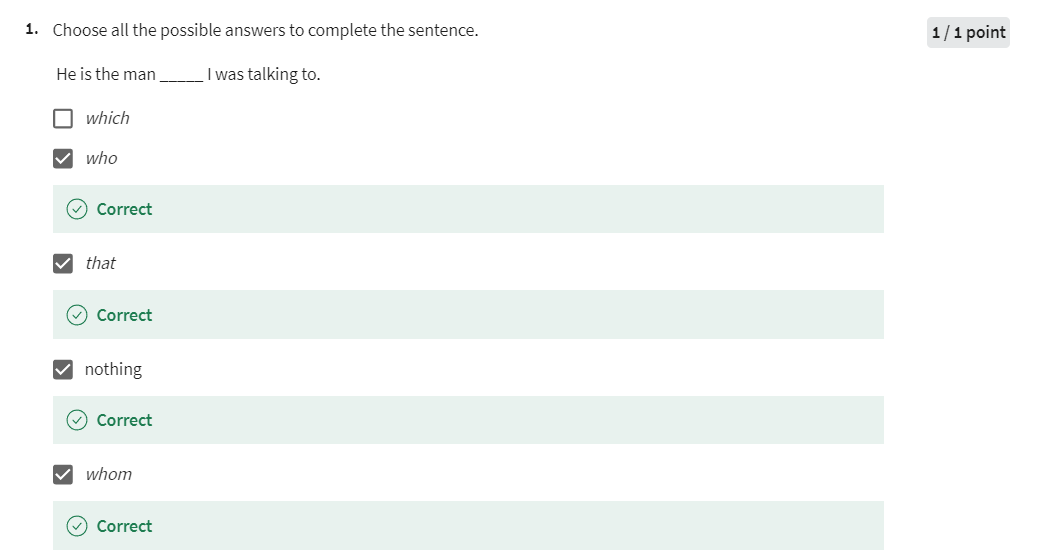
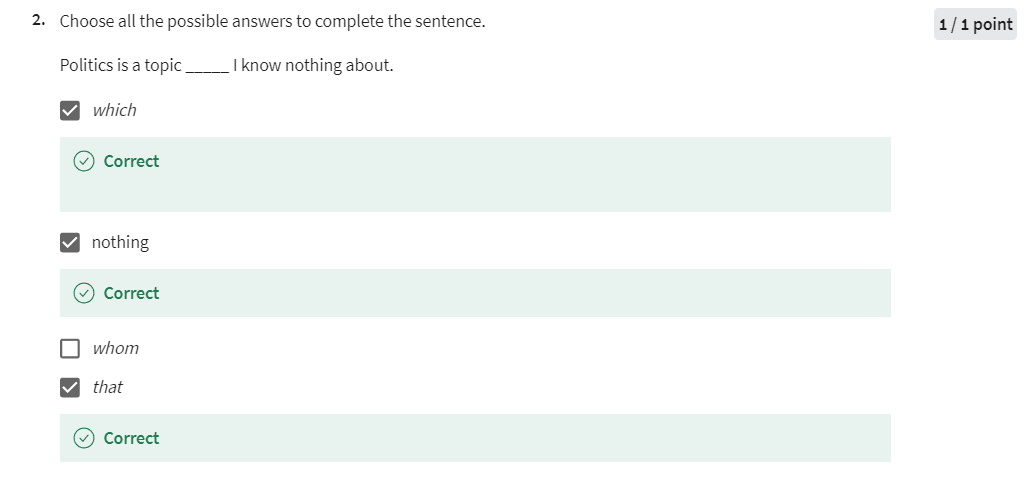

Adjective Clauses with Prepositions Practice
Practice
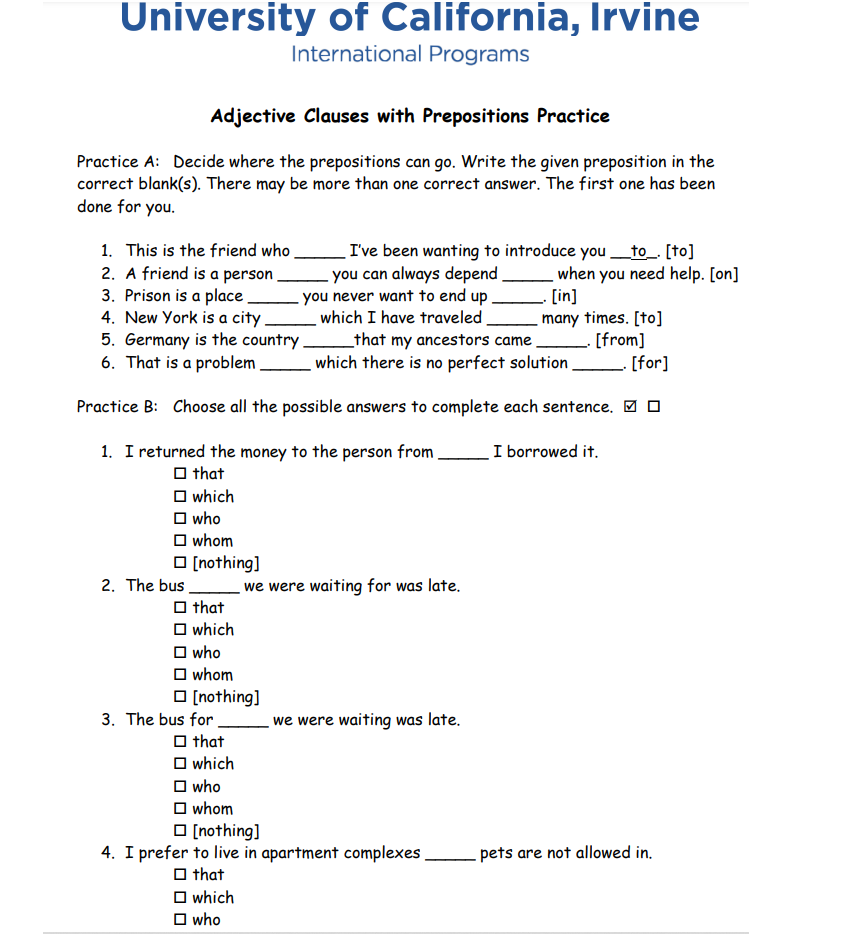
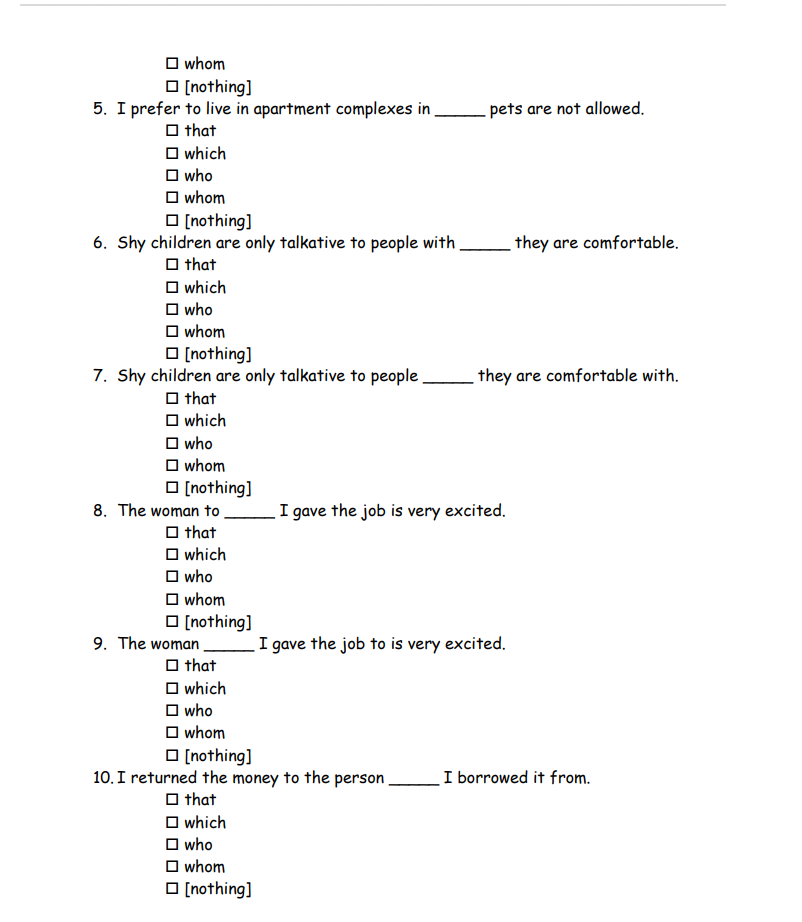
Key
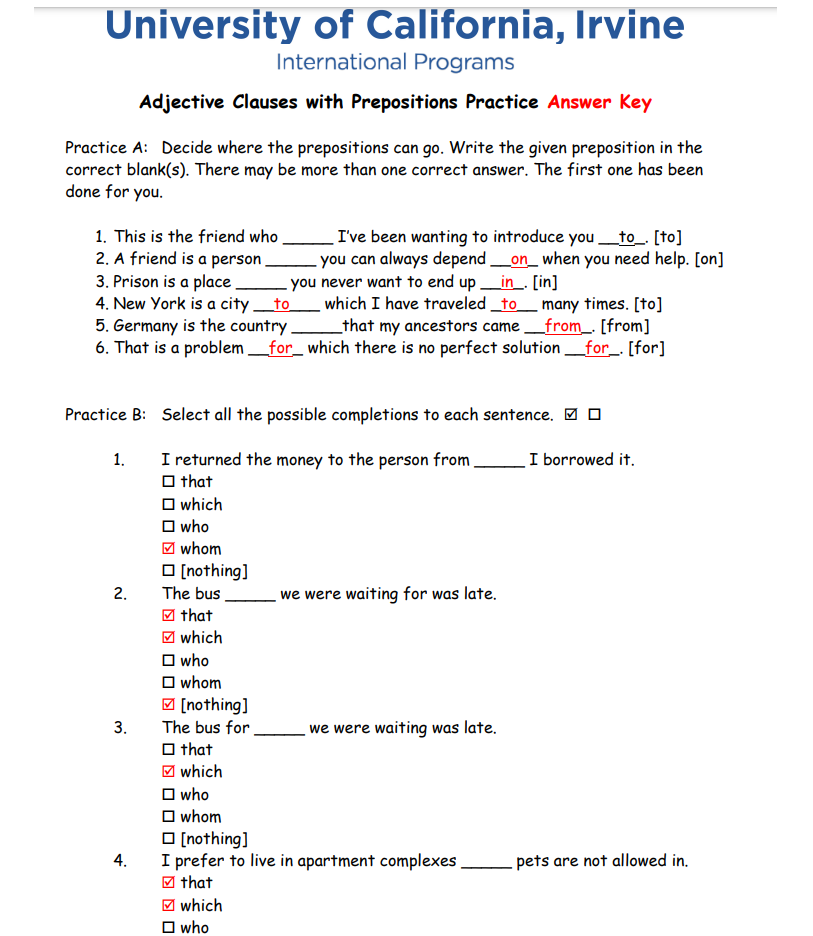

Adjective Clauses with “Where” Lecture
Using where in adjective clauses. Let’s begin with a quick
review of adjective clauses. Now adjective clauses are clauses, so
they’re made of a subject and verb. They start with a relative pronouns like,
who, whom, which, that and whose. But what do adjective clauses do? They modify, or in other words,
describe nouns. Now here’s some example sentences with
adjective clauses in parenthesis. 1, The students (who arrived late)
sat in the back of the room. 2, Michael is the person (whom
you have spoken to on the phone). 3, No one bought any of the computers
(that weren’t on sale).
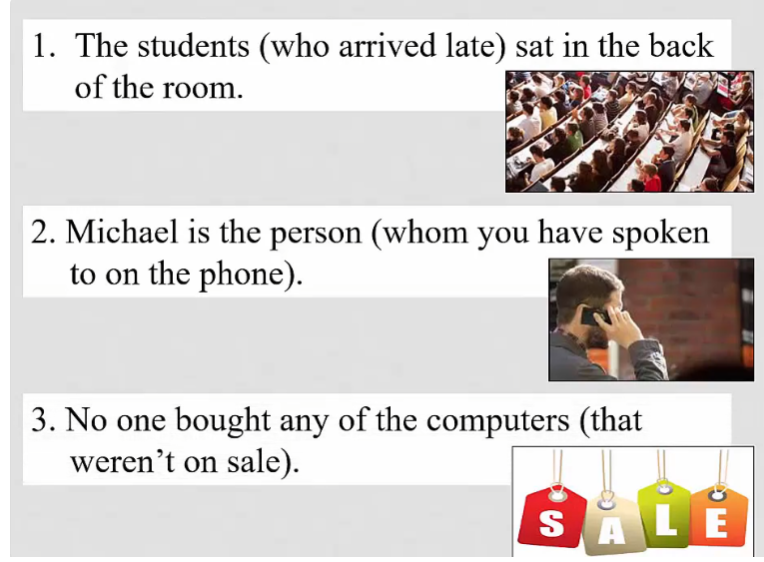
4, The garden is full of flowers
(which only bloom in the spring). And 5, I congratulated the mother (whose child
won first place in the spelling contest).

In blue, you can see the relative pronouns
that you’ve already learned how to use, who, whom, that, which and whose. In red, you can see the nouns
that they modify, students, person, computers, flowers, and mother. Now you already know that who, whom, that and
whose are used to modify people while which, that and
whose are used to modify things. But what about where? It’s used to modify location, or places like cities, parks, rooms, even space, or places on the Internet. Now let’s talk about different
places in California using some of my own photographs. The place where I took this picture
is called Joshua Tree National Park. It is a huge, beautiful park
in San Bernardino, California. They have lots of trees that look like
this, and they are called Joshua trees.
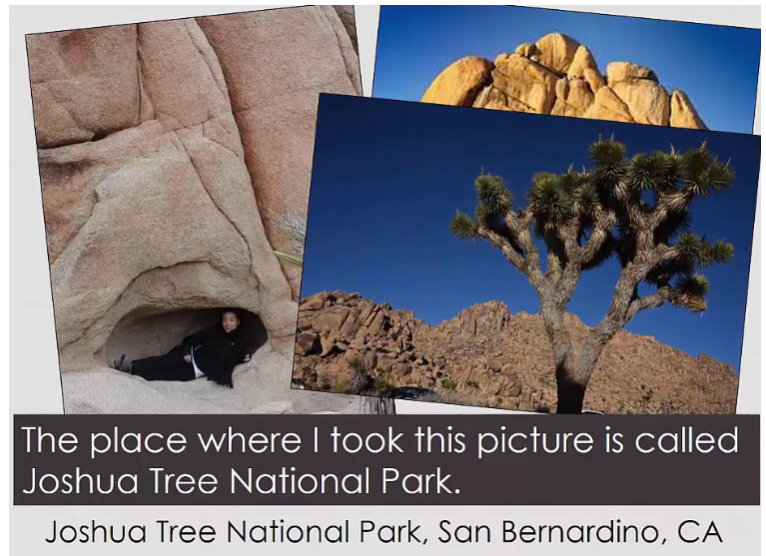
These photos were taken in
a forest where you can find red trees called Manzanita trees. They are in Santa Barbara, California.

There is an aquarium in Monterey where you
can see many different types of jellyfish.

In San Diego, there is a museum where you can take
a photo with a gigantic dung beetle. They also have lots of cool dinosaurs.
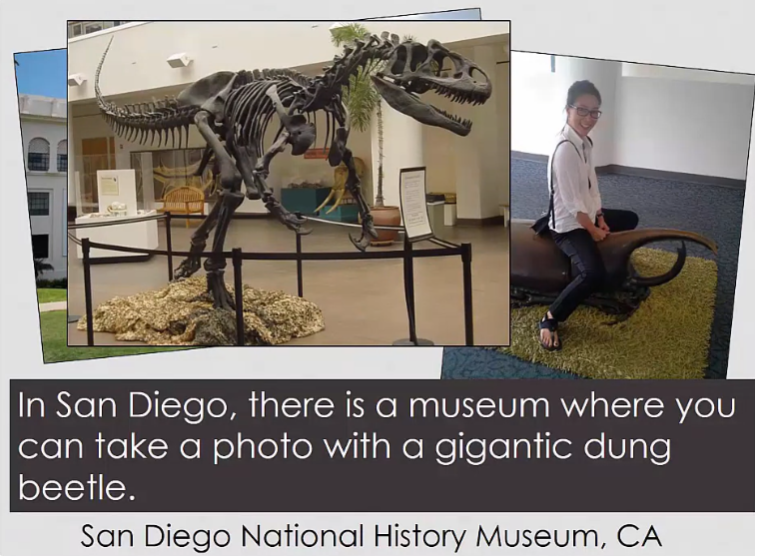
The museum where I saw a Pablo Picasso
sculpture is called LACMA, The Los Angeles Contemporary Museum
of Art. Don’t you think the sculpture
looks a lot like a rooster?
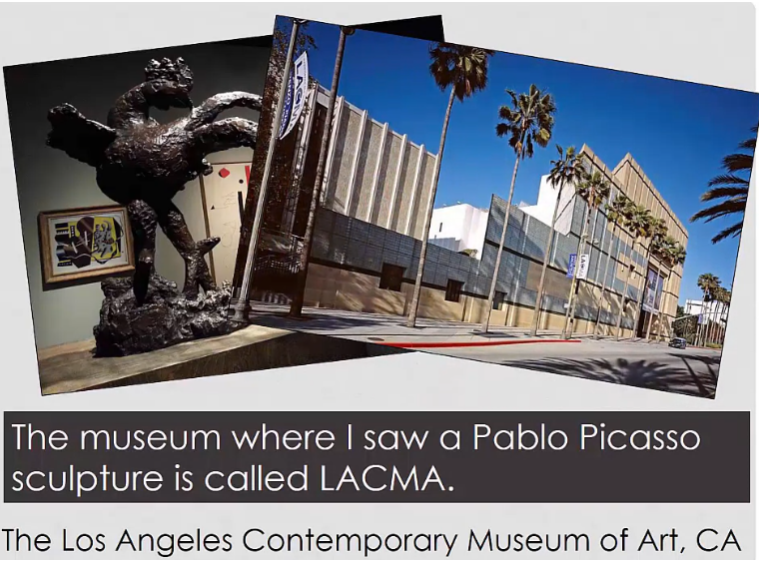
Now let’s take a look
at the first sentence. The place where I took this picture
is called Joshua Tree National Park. Do you see where the adjective part is? It’s right here,
where I took this picture. Now this adjective cause
modifies the word place. Where is the pronoun,
I is the subject, and took is a verb, which follows a structure where
the pronoun plus the subject and verb. What about this sentence? These photos were taken in a forest
where you can find red trees. Here’s the adjective clause and forest
is the location word that it modifies. Now let’s look at three more sentences. I’d like for you think about where
the adjective clauses are and which words they modify. There is an aquarium in Monterey where you
can see many different types of jellyfish. Do you see the adjective clause? Here it is, and
it modifies aquarium in Monterey. Next, in San Diego, there is a museum where you can take
a picture with a gigantic dung beetle. Here’s the adjective clause and
it modifies museum. And last we have, the museum where I saw
a Pablo Picasso sculpture is called LACMA. Here’s the adjective clause, and
it modifies the word museum.

I’d like to take a closer
look at the last sentence. The museum where I saw a Pablo Picasso
sculpture is called LACMA. Now the adjective clause,
where I saw a Pablo Picasso sculpture, can be written in several different ways,
using several different pronouns. Here, using where,
there is no preposition. But let’s take a second to think
about what this sentence is saying. The adjective clause is saying, I saw
a Pablo Picasso sculpture in a museum and the rest of the sentence is saying,
the museum is called LACMA. Do you see a preposition
in the first sentence? That’s right, in is a preposition. Now let’s use in, in order to express the original
sentence in several different ways. The museum in which I saw a Picasso
sculpture is called LACMA. The museum which I saw a Picasso
sculpture in is called LACMA. The museum that I saw a Picasso
sculpture in is called LACMA. The museum I saw a Picasso
sculpture in is called LACMA. Notice that this last sentence does not
have a pronoun which is totally fine. All of these sentences
express the same idea as the museum where I saw a Picasso
sculpture, is called LACMA.
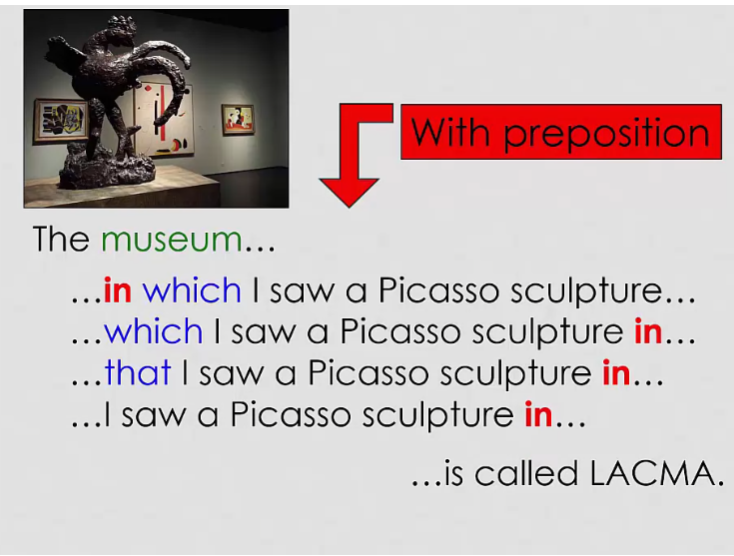
Now, I’d like to give you another
example using this photo. Here, I am at a cafe where I’m learning
to play chess for the first time. Notice anything strange? Yeah, the game pieces were really big. The cafe where I learned to play
chess had very large game boards. Now let’s think about the several
different ways that I can express the same idea. I can say the cafe at which I learned to
play chess had very large game boards. Or the cafe which I learned to play
chess at had very large game boards, or the cafe that I learned to play
chess at had very large game boards. And finally, the cafe I learned to play
chess at had very large game boards.
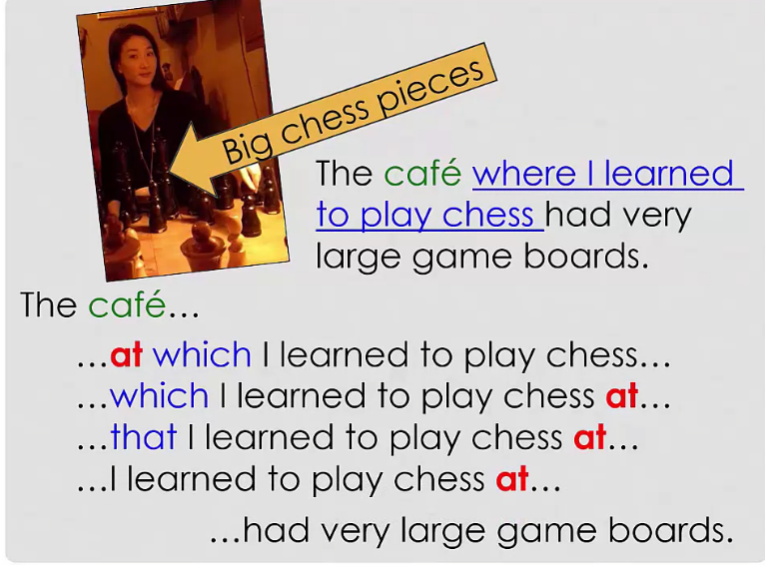
Now you have a lot of choices here, but I do want to point out that
the most common forms would be using where, and
also not using a pronoun at all. For instance, I can end this lesson
by saying I hope you enjoyed hearing about some of the places
where I’ve been around California. Or I hope you enjoyed hearing about
some of the places I’ve been to around California. Either way,
I hope you enjoyed this lesson. I hope you feel more comfortable
now expressing your thoughts about places using where in adjective clauses.
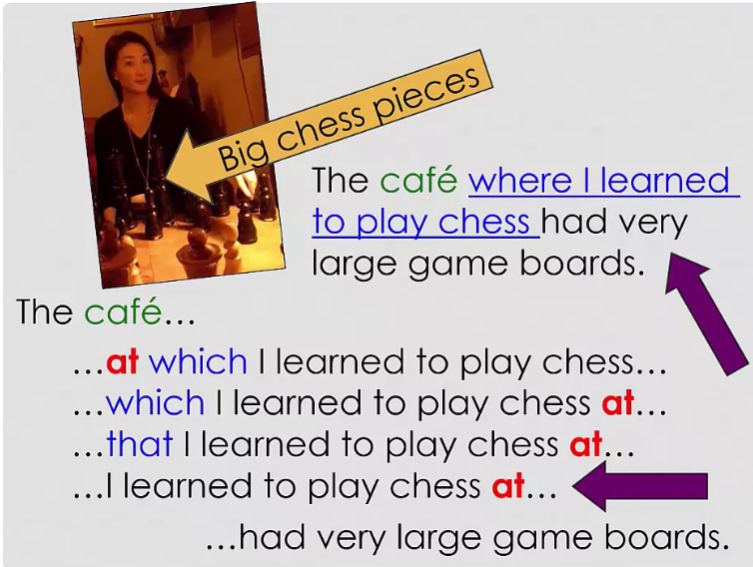

Adjective Clauses with “Where” Practice Quiz

Adjective Clauses with “Where” Practice
Adjective Clauses with “Where” Handout
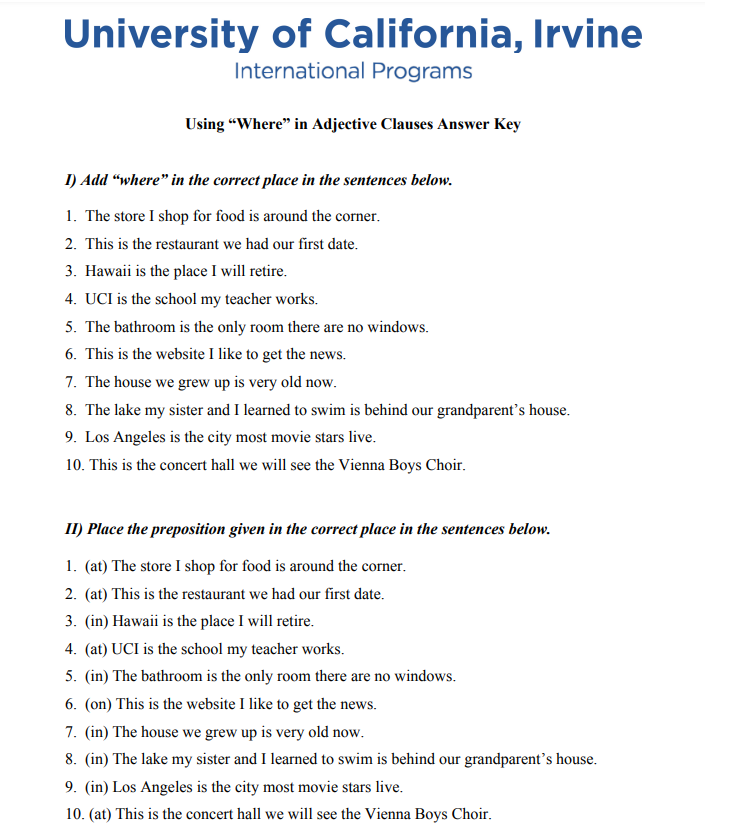
Adjective Clauses with “Where” Handout Answer Key
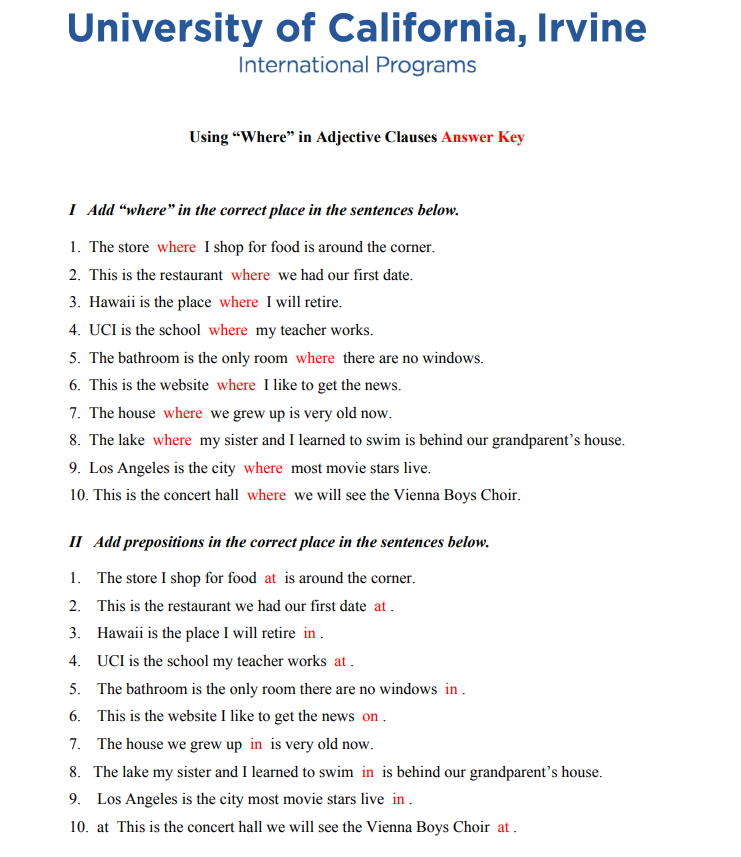
Adjective Clauses with “When” Lecture
Using when in adjective clauses. The type of adjective cost you will
be learning is how to use when plus the subject and verb. Now what type of nouns do
you think when modifies? Well, time words. Some examples of nouns
of time include time, season, morning, period, moment, anniversary,
year, month and day. But of course there are many
other words that refer to time.
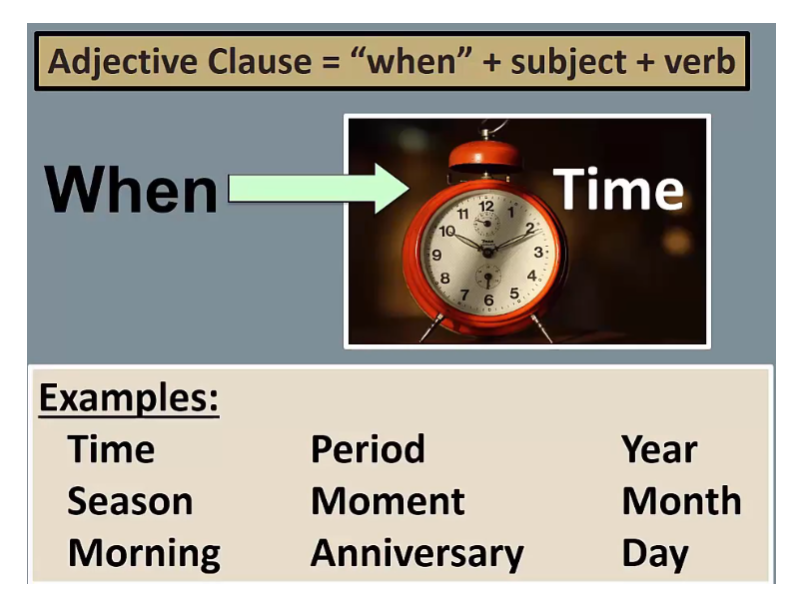
Now, take a look at
these different images, which time period do
these images represent? The 1940s, the 1950s, or the 1960s? The correct answer is the 1950s. So let’s talk about the history. Now one thing that I can
say about the 1950s, is that the 1950s was a time when
many great products were introduced, such as a color TV, Lego toy,
car seatbelt and remote control. Now I think we can all agree
that these are pretty great.

Now I bet 1955, was a very exciting
time for both children and adults because 1955 is the year
when Disneyland opened.

Also the 1950s was a period in history
when some very important things happened. For example, DNA was discovered,
also NASA was founded. And the polio vaccine was discovered
saving hundreds and thousands of children.

Now let’s learn a little more
about each of these events. Pay close attention to the use of when
to form adjective clauses about time. The year when Cambridge
scientists Watson and Crick discovered the chemical
structure of DNA is 1953. Since then we have learned so much about all living things
thanks to these scientists. October 1, 1958, is the date when NASA became operational to
begin space explorations. Since then our understanding of our place
in the universe has never been the same. The date when Dr.
Jonas Salk announced the effectiveness of the polio vaccine on
the radio is March 26, 1953. Thanks to Dr. Salk there are almost no
known cases of polio now in the US.
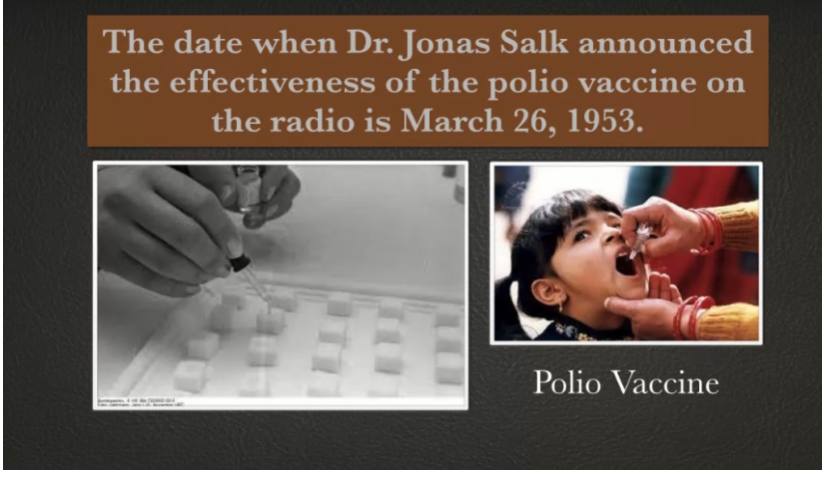
Take a look at these sentences. Where is the adjective clause? I’ve highlighted for you where
the adjective clause begins and ends. Let’s take a look. The year when Cambridge
scientists Watson and Crick discovered the chemical
structure of DNA is 1953. October 1,
1958 is the day when NASA became operational to begin space explorations. The date when Dr.
Jonas Salk announced the effectiveness of the polio vaccine on
the radio is March 26, 1953.
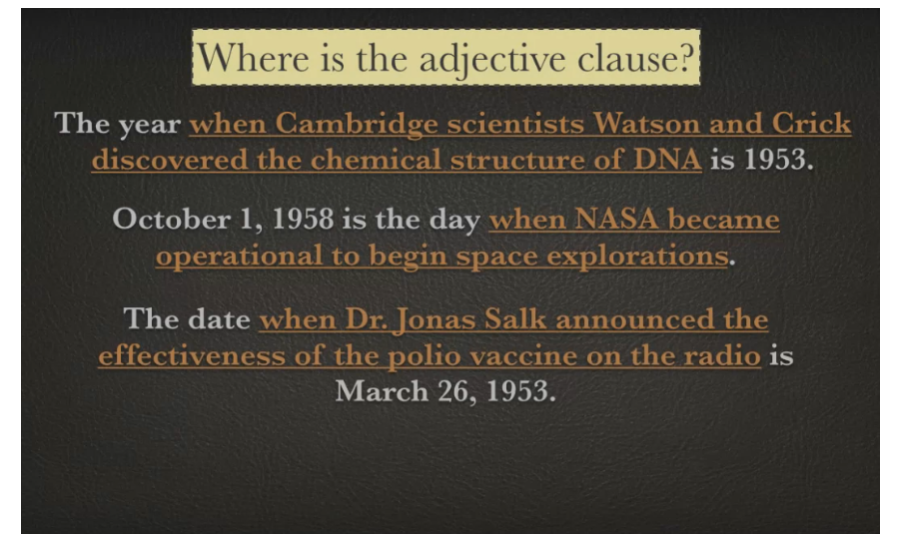
Now do you remember what I
said about these images? The 1950s was a time when many
great products were introduced. Now let’s talk about the adjective
clause in this sentence. We have when, the pronoun,
plus many great products, the subject, and were introduced, the verb and
this adjective clause modifies time. Now the sentence is basically saying, the 1950s was a time many great
products were introduced in that time. There are several different ways
that you can express the same idea. The 1950s was a time in which many
great products were introduced. Notice that with which, you should use a
preposition, the appropriate preposition. The 1950s was a time that many
great products were introduced. And the 1950s was a time many
great products were introduced, using no pronoun. Using when and
no pronoun are the most common forms.
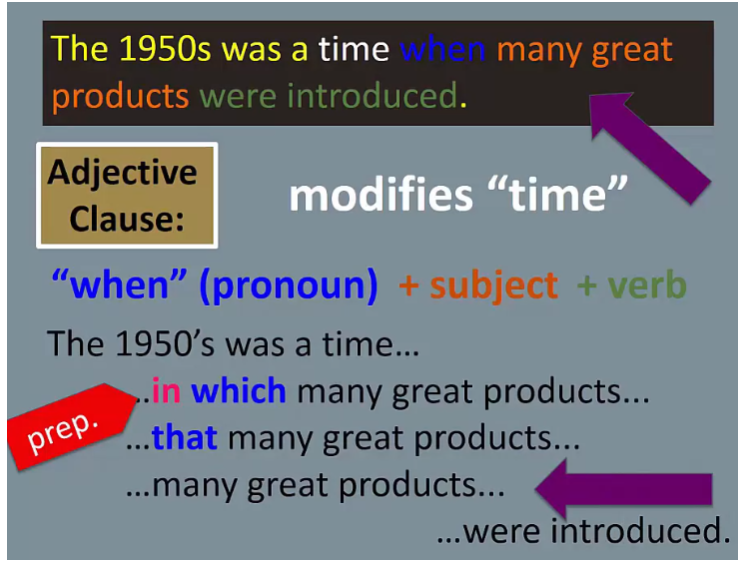
Let’s take a look at another example. Let’s combine these two ideas. 1955 is the year. Disneyland opened in that year. Do you remember how to
complete this sentence? 1955 is the year when Disneyland opened. Here’s some other ways that
you can say the same thing. 1955 is the year in
which Disneyland opened. Hmm, we can also say, 1955 is
the year that Disneyland opened, or you can simply say,
1955 is the year Disneyland opened.

Let me test your memory one more time. Combine these two ideas,
the 1950s was a period in history. Some very important things
happened in that time. Well the answer is,
the 1950s was a period in history when some very
important things happened. Well done. Well I hope you had fun
going back in time with me. And I hope that you are more comfortable
using, when in adjective clauses. Thanks for watching!
Adjective Clauses with “When” Practice Quiz

Adjective Clauses with “When” Practice
Practice

Key
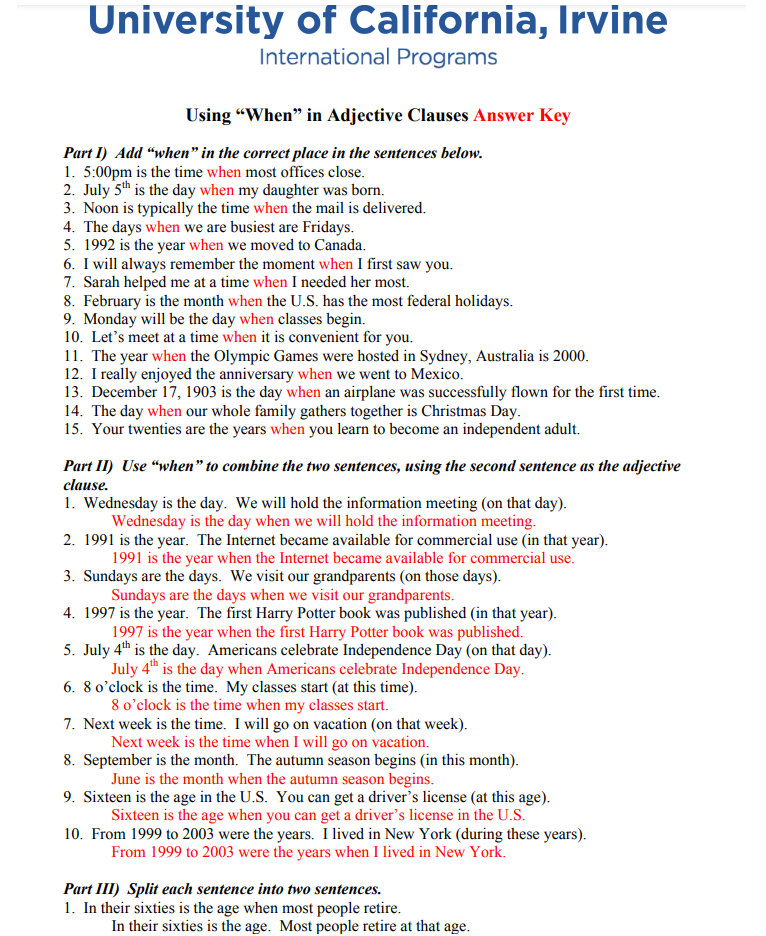

Graded Assignment: Adjective Clauses Assignment 2
Write 3 sentences with adjective clauses that have prepositions, 3 sentences with adjective clauses that have “where,” and 3 sentences with adjective clauses that have “when.” Make sure your sentences use correct grammar. Try to make your 9 sentences interesting.
Example of a sentence with an adjective clause that has a preposition:
That blue BMW is the car I want to ride in.
Example of a sentence with an adjective clause that has “where”:
We took our vacation at a resort where we could go zip lining.
Example of a sentence with an adjective clause that has “when”:
I get nervous when I think about the time when I almost crashed my car.
My try
Adjective clauses with prepositions:
- This is the boy I talk to.
- Here is the computer about which I told you.
- Artificial Intelligence is a topic I know nothing about.
Adjective clauses with “where”:
- We visited a historic castle where knights once lived and battled for their kingdom.
- They rented a cabin in the mountains where they could escape the hustle and bustle of city life and enjoy nature.
- He found a job at a company where opportunities for growth and advancement are abundant.
Adjective clauses with “when”:
- She cherishes the moment when she first met her best friend, who has been by her side through thick and thin.
- We reminisce about the summer when we traveled across Europe, exploring famous landmarks and experiencing different cultures.
- He always feels nostalgic when he listens to the song that played at his high school prom, bringing back memories of youth and innocence.
Graded Quiz


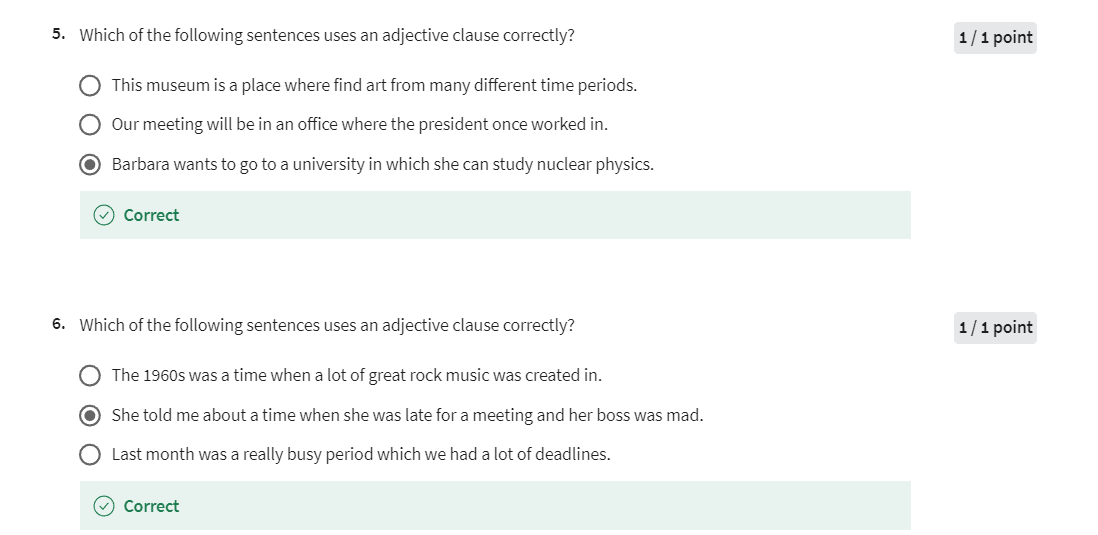
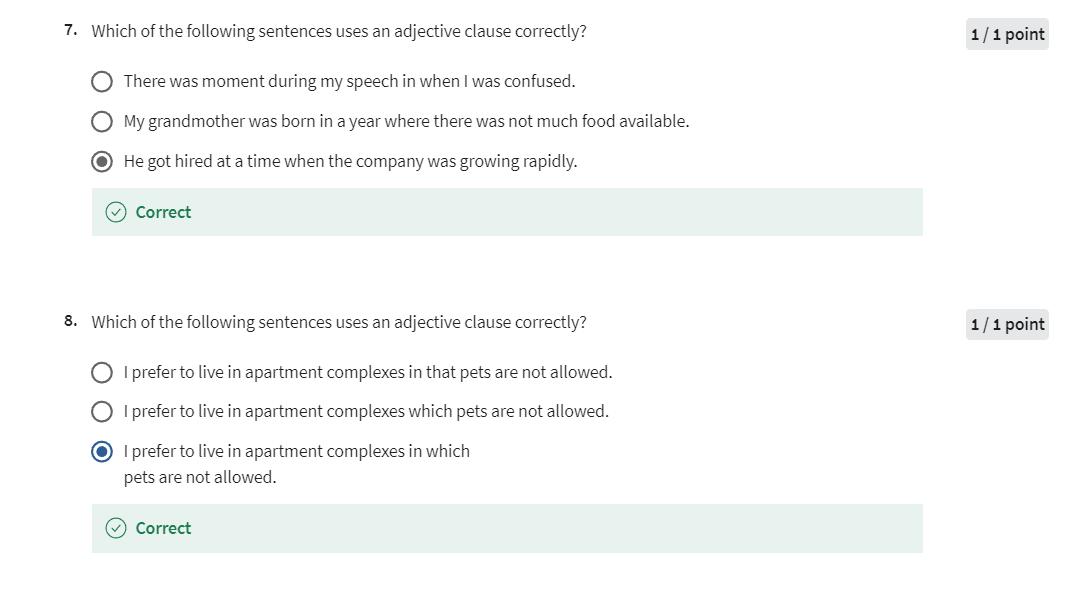
Week 04: Reduced Adjective Clauses and Appositives
In this last module, you will learn a different way to use adjective clauses. It is different but very common and, therefore, important.
Learning Objectives
- determine when it is possible to reduce adjective clauses
- reduce adjective clauses correctly
Reduced Adjective Clauses lecture
A lesson on reducing adjective clauses. Before you watch this video, make sure
you have already reviewed the lessons on adjective clauses as subjects and
as objects. Listen to a conversation
about a picture that I took. Hey, cool picture. >> Thanks. I like to take pictures of people
who aren’t looking at the camera. >> Did you talk to them after? >> Yeah. I sat down to chat with them for
a little bit. The boy who is sitting in
the middle is 11 years old. The girl who is standing next to
him is his seven year old cousin. The man who is on the left is a stranger,
the cartoon t-shirt which is worn by the boy, is pretty popular on these
days, my brother also likes that cartoon. >> I’ve never seen it before. I actually thought that
the man’s outfit was funnier. He had so many different types of stripes,
his hat, sweater, and inside shirt
You’re right. People who wear stripes should be careful
about mixing too many stripe patterns. By the way, why there’s so
many pedestrian barriers? >> On that day,
police were setting up for a marathon. The road that was blocked by the barriers
was part of the finish line.
After listening to the conversation, you
probably noticed many adjective clauses. Did you know that when native English
speakers use some adjective clauses, they naturally reduce them
because they can save time. We call them adjective phrases. Let me explain the difference between an
adjective clause and an adjective phrase. A phrase is shorter than a clause. An adjective clause has an adjective
clause pronoun, who, which, that. A phrase does not have
an adjective clause pronoun. A clause has a complete verb however
in a phrase the verb form is changed.
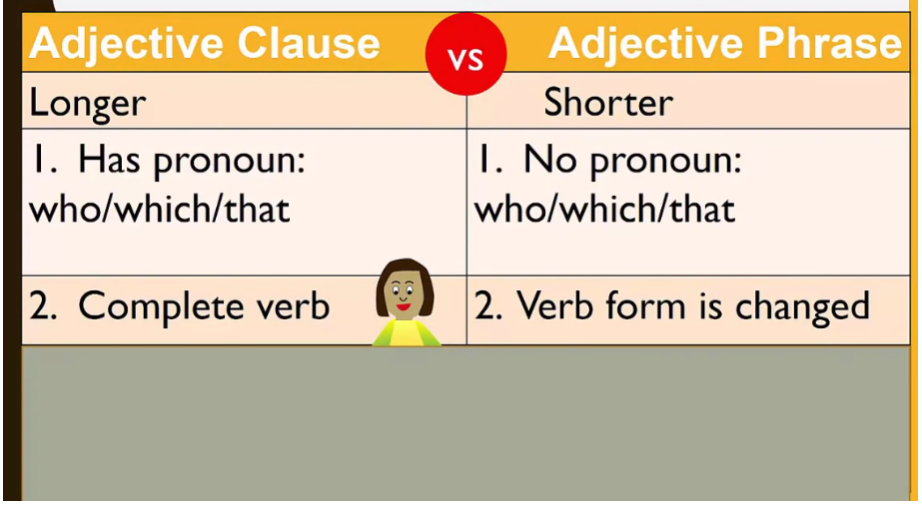
Here is an example of a sentence
with an adjective clause. The boy who is sitting in
the middle is 11 years old. Who is sitting in the middle
is the adjective clause. Now let’s reduce this clause
to an adjective phrase. The boy sitting in
the middle is 11 years old. Sitting in the middle is
the adjective phrase. In the phrase, you can see that there
is no adjective clause pronoun and the verb is shortened from is sitting,
to just sitting.

What are the rules to do this? Let’s take a look. Rule number one, you can only reduce adjective clauses that
use adjective clause subject pronouns. It doesn’t work with object pronouns. If you have forgotten
adjective clause subject or object pronouns please
review those videos again. However here is an example
not from the conversation. Number one, my friend who is working
in New York City is coming to visit. Number 2, my friend who I met in
New York City is coming to visit. The first sentence uses
who as a subject pronoun. This means that you can
reduce the sentence more. On the other hand, in the second sentence,
you see who and then the I next to it. This is a sign that you are using who
as an adjective clause object pronoun. This clause cannot be reduced.
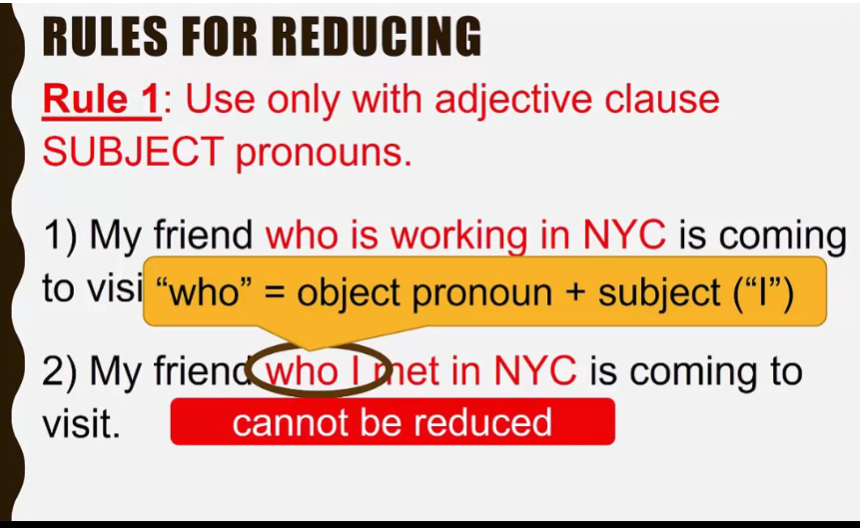
Rule two, check the verb
situation of the adjective clause. If it is a progressive tense
with a prepositional phrase or a passive verb, they can be reduced.

Let’s look at the adjective clauses
from the conversation again. Number one, the girl who is standing next
to him is his seven year old cousin. Who is standing is
the present progressive. The man who is on the left is a stranger. In this sentence you see who is on. On is a preposition. So this is a prepositional phrase. Number three, the cartoon t-shirt which is worn by
the boy is pretty popular these days. Which is worn is a passive verb. Finally number four, the road that was blocked by the barriers
was part of the finish line. That was blocked is also a passive.
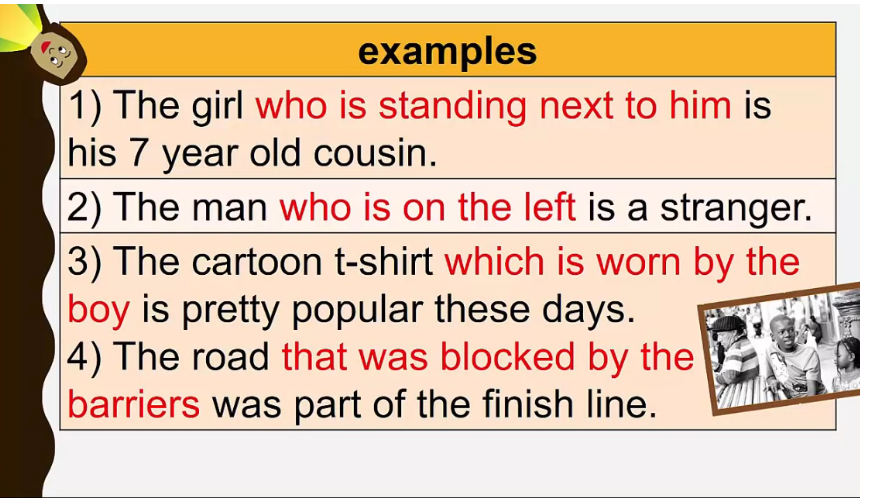
For these four sentences you reduce
the clauses by cutting the adjective clause pronouns who, which or
that then you cut the be verb. The reduced sentences become
the girl standing next to him is his seven year old cousin. The man on the left is stranger. The cartoon t-shirt worn by the boy
is pretty popular these days. The road blocked by the barriers
was part of the finish line.

There was one more sentence that
included a present progressive. I like taking pictures of people
who aren’t looking at the camera. Here, you see a negative verb. Aren’t looking,
which basically means are not looking. What should we do with negatives? Well, cut the who and
the be verb, and keep the not. It would look like this, I like taking pictures of people
not looking at the camera.
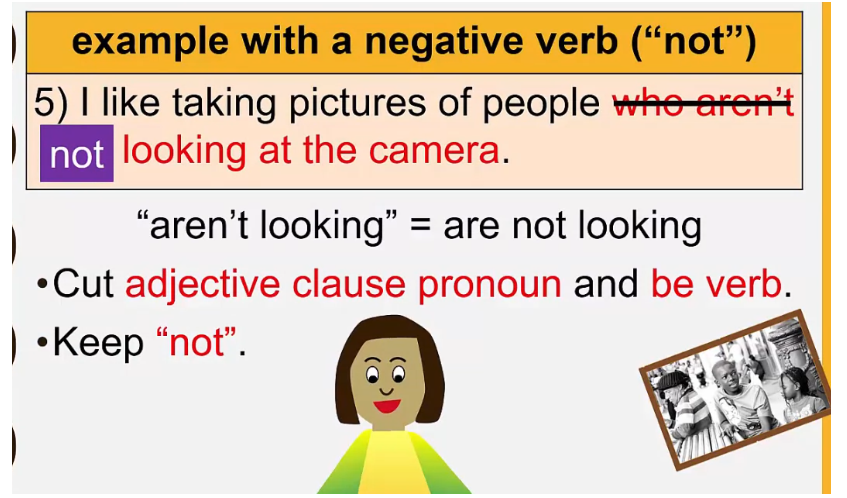
Now what should we do if
there are no be verbs? Let’s look at the following sentence. People who wear stripes should be careful
about mixing too many stripe patterns. Here, we have the simple
present tense wear. In this situation ,cut the who,
which, that, and take the verb and add -ing. The shorten sentence becomes
people wearing stripes should be careful about mixing
too many stripe patterns.

Now we have reduced all
the clauses to phrases. Let’s listen to the conversation
one more to see what happens. >> Hey, cool picture. >> Thanks.
I like taking pictures of people not looking at the camera. Did you talk to them after? >> Yeah, I sat down to chat with them for
a little bit. The boy sitting in
the middle is 11 years old. The girl standing next to him
is his seven year old cousin. The man on the left is a stranger. The cartoon t-shirt worn by the boy
is pretty popular these days. My brother also likes that cartoon. >> I’ve never seen it before. I actually thought that
the man’s outfit was funnier. He had so many different types of stripes. His hat, sweater, and inside shirt. >> You’re right. People wearing stripes should be careful
about mixing too many stripe patterns. By the way, why are there so
many pedestrian barriers? >> That day police were setting up for
a marathon. The road blocked by the barriers
was part of the finish line.
The conversation is a little shorter,
right? Reducing adjective
clauses may be confusing, so remember to do the exercises.
Reduced Adjective Clauses Practice Quiz
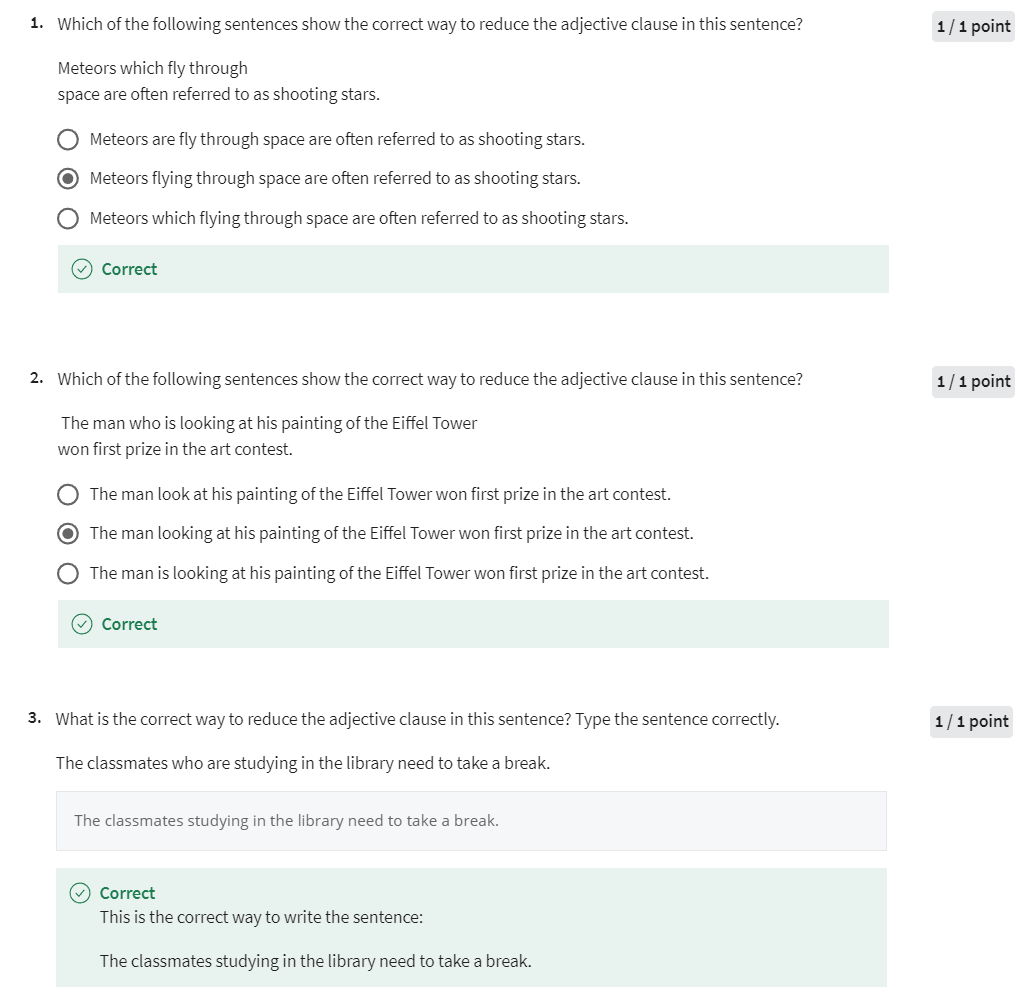
Reduced Adjective Clauses Practice
Practice


key
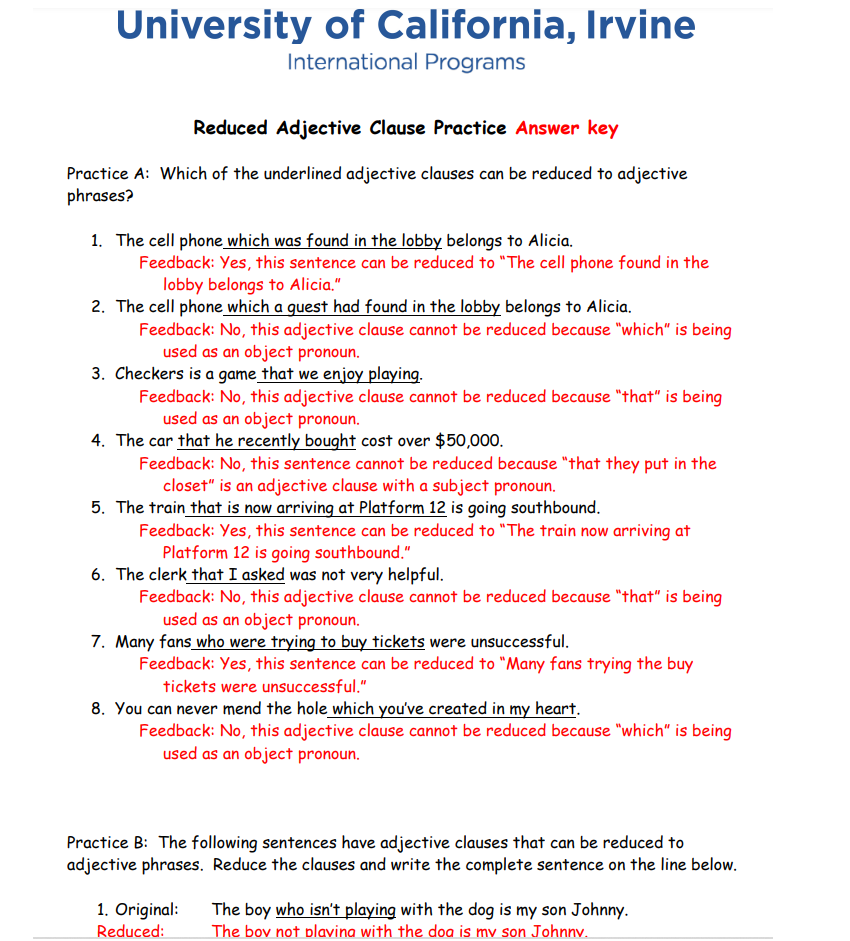
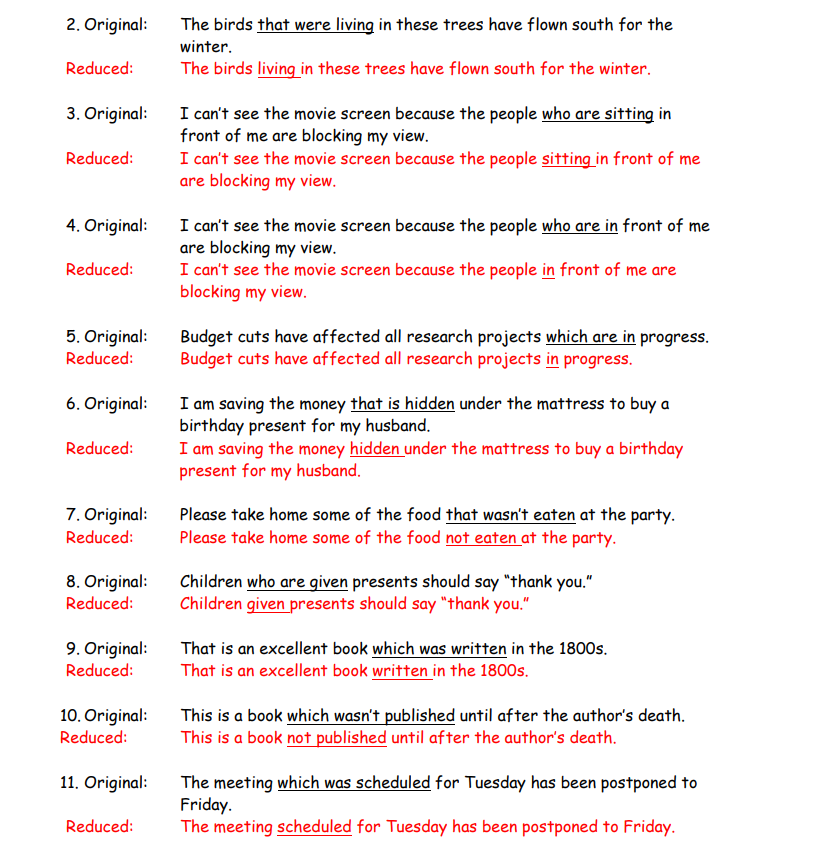
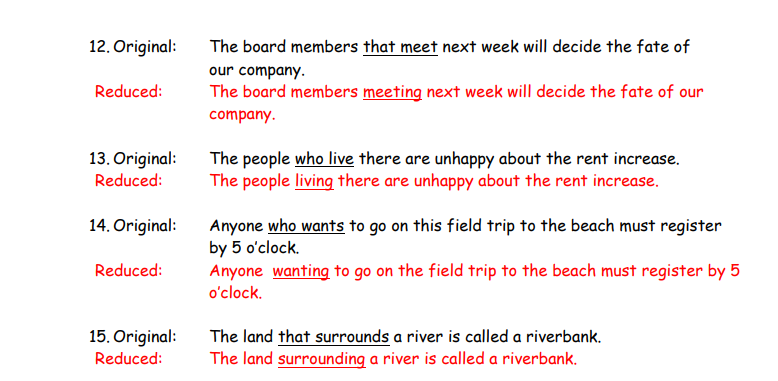
Appositives
This is a continuation lesson
of reducing adjective clauses. If you haven’t watched the lesson
on reduced adjective clauses, make sure to check that one out first. This lesson focuses on appositives. Before I show you what an appositive is,
take a look at the following sentences. UCI, which is a university in
Orange County, is known for its biology and engineering programs. Michelle Obama,
who is President Obama’s wife, cares about the health of
children in the United States. Lord of the rings,
which was a story by J.R.R. Tolkien, was made into a three-part movie. Did you notice the commas
in each sentence? Take a look. Why are there commas? If you look at the main subject of each
sentence, UCI, Michelle Obama, and Lord of the Rings, they are all nouns that
are specific and generally well known. The adjective clauses between
the commas just give extra information.

Compare them to the following sentences. The lady who is the manager of
the supermarket is my neighbor. The building which is an institution for after-school tutoring is very
popular in this neighborhood. Here, there are no commas. Why? It is because the lady and
the building are not specific. They are too general. The listener might not know
what I am referring to. It is necessary to say, the lady,
who is the manager of the supermarket, and the building, which is an institution for
after school tutoring, to be clear. Remember, when commas are added that
means the adjective clause is just additional information. Let’s look at the original
three sentences again and study the pattern of the adjective clause. We see the main subject, Then the comma, Then the adjective clause pronoun who or
which, Then the be verb, And then a noun or a noun phrase,
And then, finally, the last comma. What are the rules? Similar to the previous video
on reducing adjective clauses, you would just have to cut the adjective
clause pronoun as well as the be verb. For this sentences, don’t cut the commas
or the articles like a and an or the.
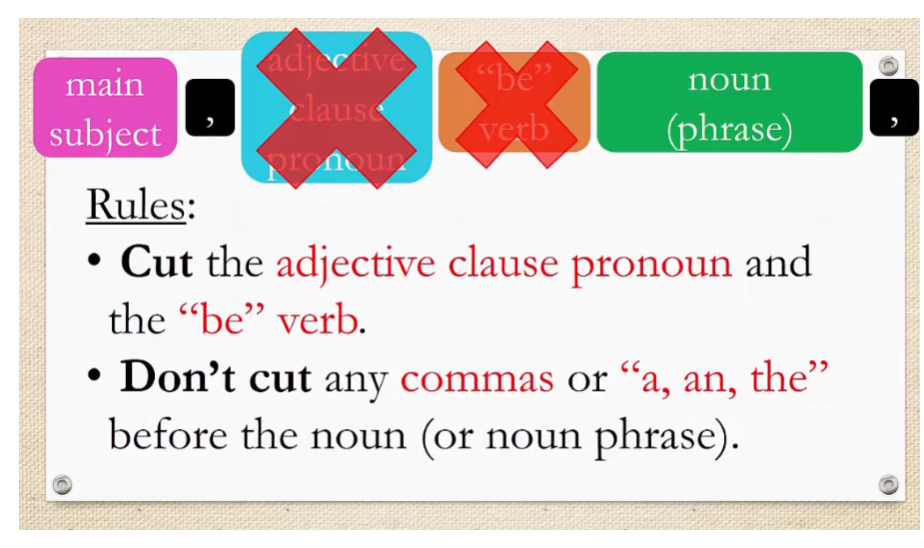
Let’s take a look at what
happens after reduction. UCI, a university in Orange County,
is known for its biology and engineering programs. Michelle Obama, President Obama’s wife, cares about the health of
children in the United States. Lord of the Rings, a story by J.R.R.
Tolkien, was made into a three-part movie.
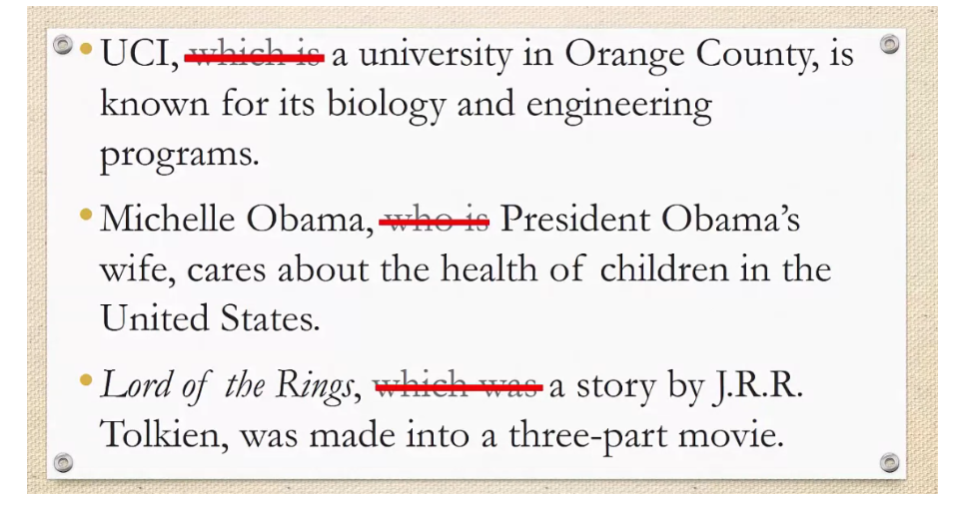
These adjective clauses have been
reduced to nouns or noun phrases. Can you guess what these special
noun phrases are called? I’ll give you a hint,
what’s this video about? That’s right, it’s an appositive. An appositive is basically a noun, or a noun phrase,
that gives a new name to the main noun. A university in Orange County
is a noun phrase explaining UCI. President Obama’s wife is a noun
explaining Michelle Obama. A story by J.R.R. Tolkien is a noun
phrase explaining Lord of the Rings. Appositives can be used in speaking or
writing but remember, if you use them in writing, make sure to
include the commas to separate the noun, or noun phases,
from the main part of the sentence. You are now ready to try the exercises.
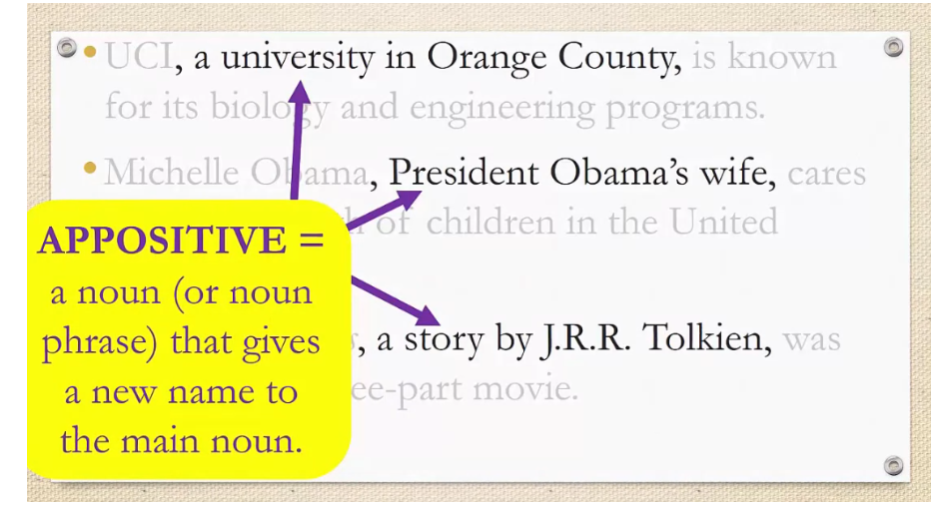
Appositives Practice Quiz
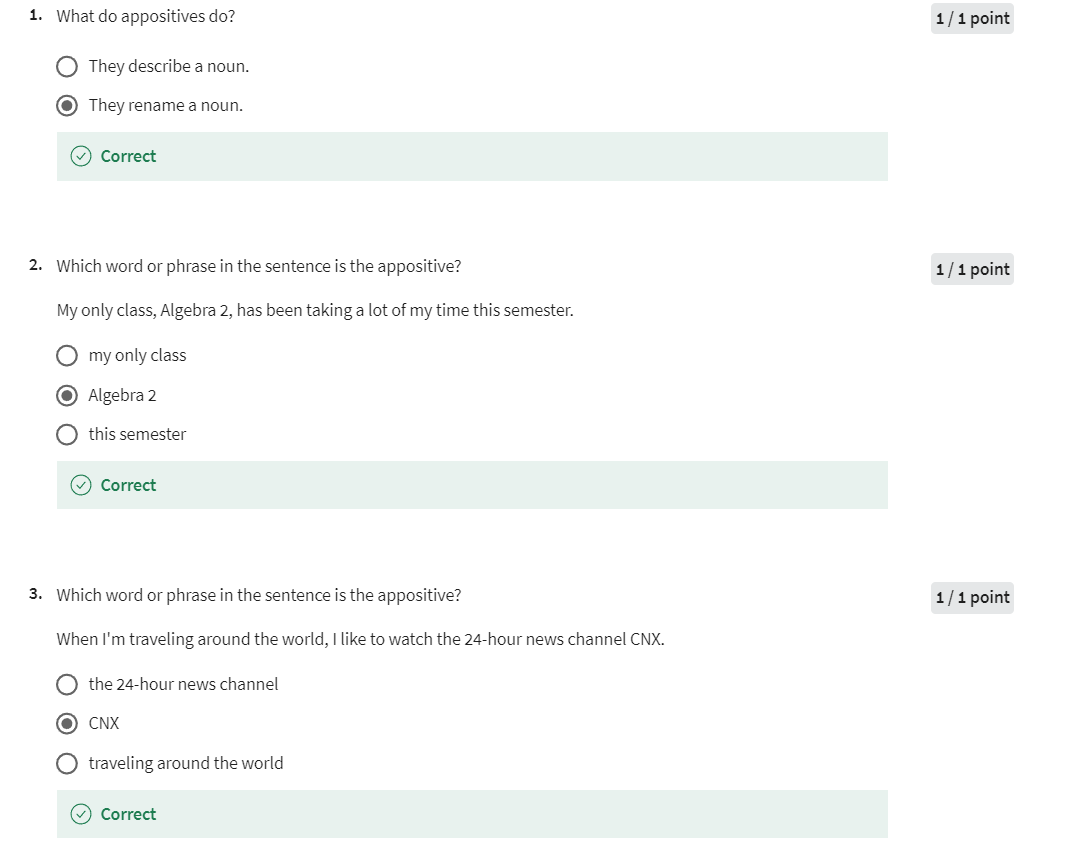
Appositives Practice
Practice
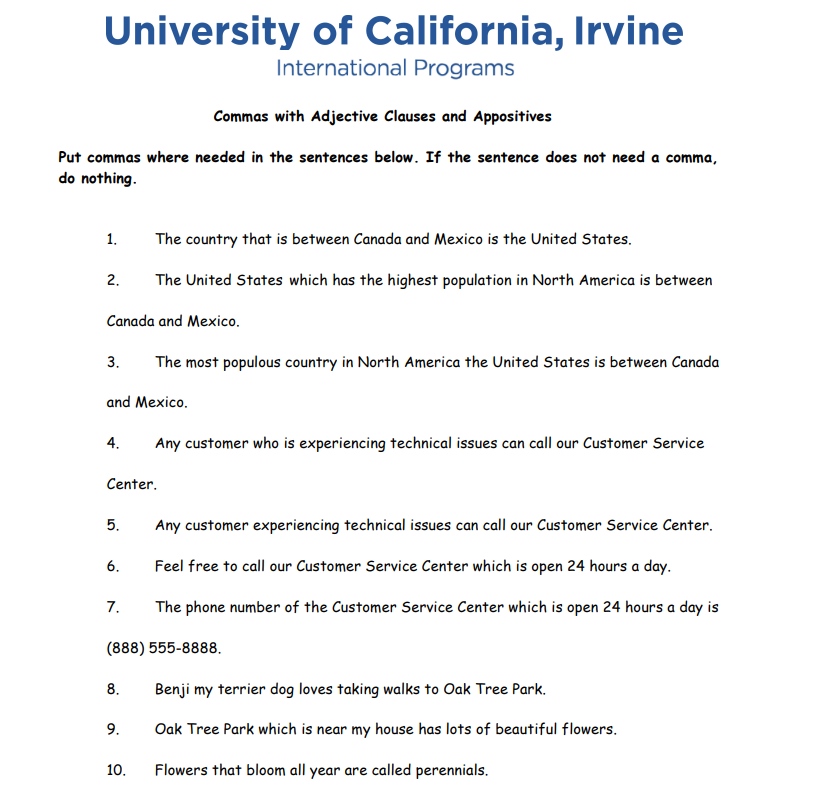
key

Graded Assignment: Reduced Adjective Clauses and Appositives Assignment
Type 5 sentences with adjective clauses or appositives that need commas.
Then type 5 sentences with adjective clauses or appositives that do not need commas.
Remember commas are needed when the information is additional and not necessary. Commas are not needed when the information is necessary in the sentence.
My try
Sentences with commas:
- My friend, who is a talented musician, performed at the school talent show.
- The cat, a fluffy Persian, enjoys lounging in the sun.
- Mrs. Smith, the science teacher, assigned a challenging project to her students.
- The old house, which has a red door, is rumored to be haunted.
- My favorite movie, which is a romantic comedy, always makes me laugh.
Sentences without commas:
- The boy who won the race is my cousin.
- The car that I bought yesterday is parked in the driveway.
- The book that you lent me is on my desk.
- The restaurant that serves delicious pizza is just around the corner.
- The dog that barks loudly at night belongs to my neighbor.
Graded Quiz

第一题应该是No
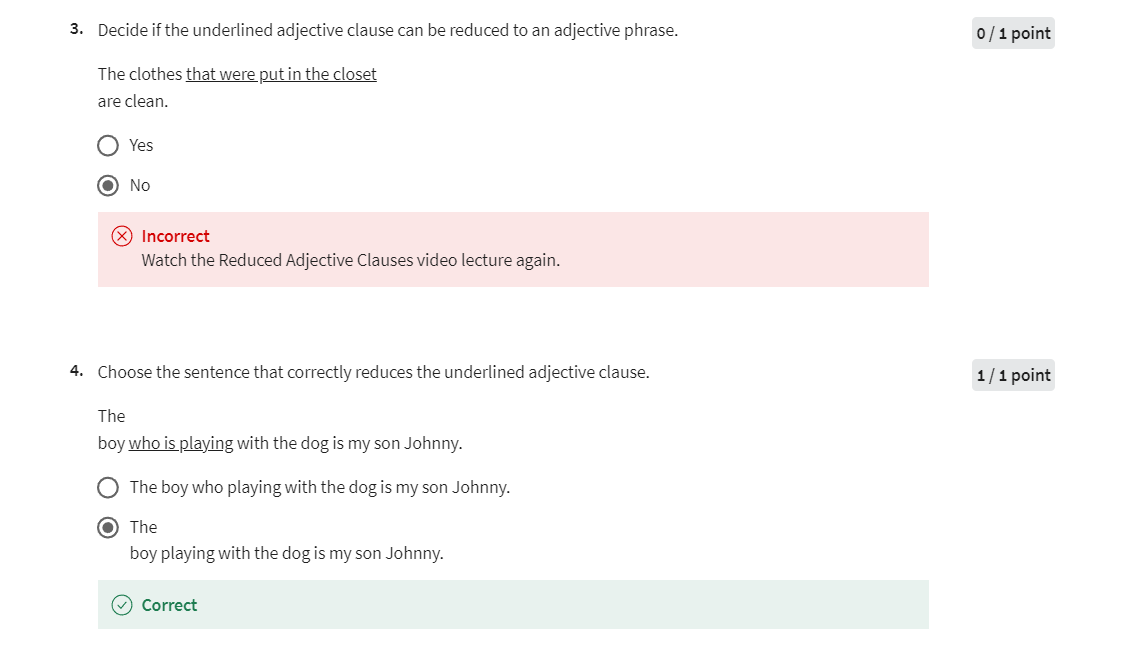
第三题是Yes
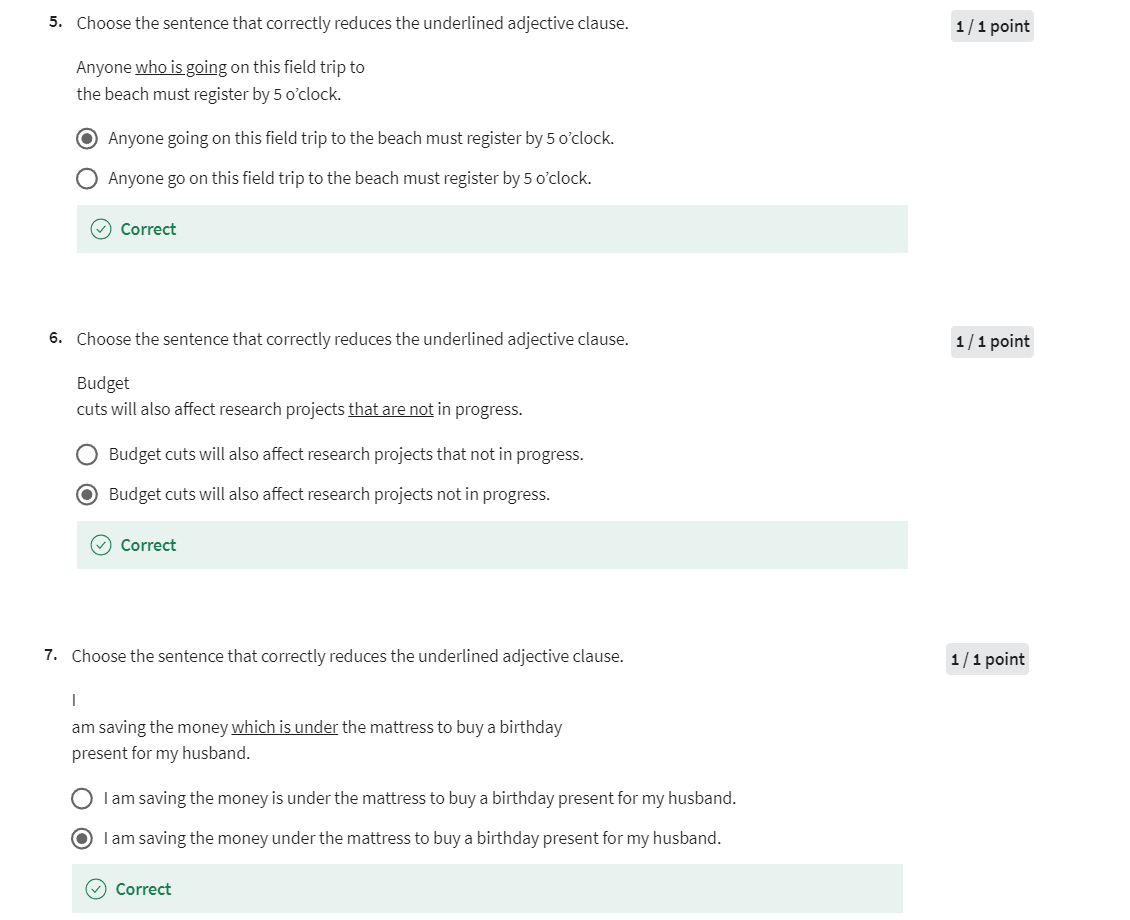

后记
2024年5月2日16点47分完成这门课的学习。这门课是关于定语从句的,学会用英语表述语法现象。在思考一个问题,如果让我用英语在国际学校教英语语法,我从这门课中学到了什么呢?






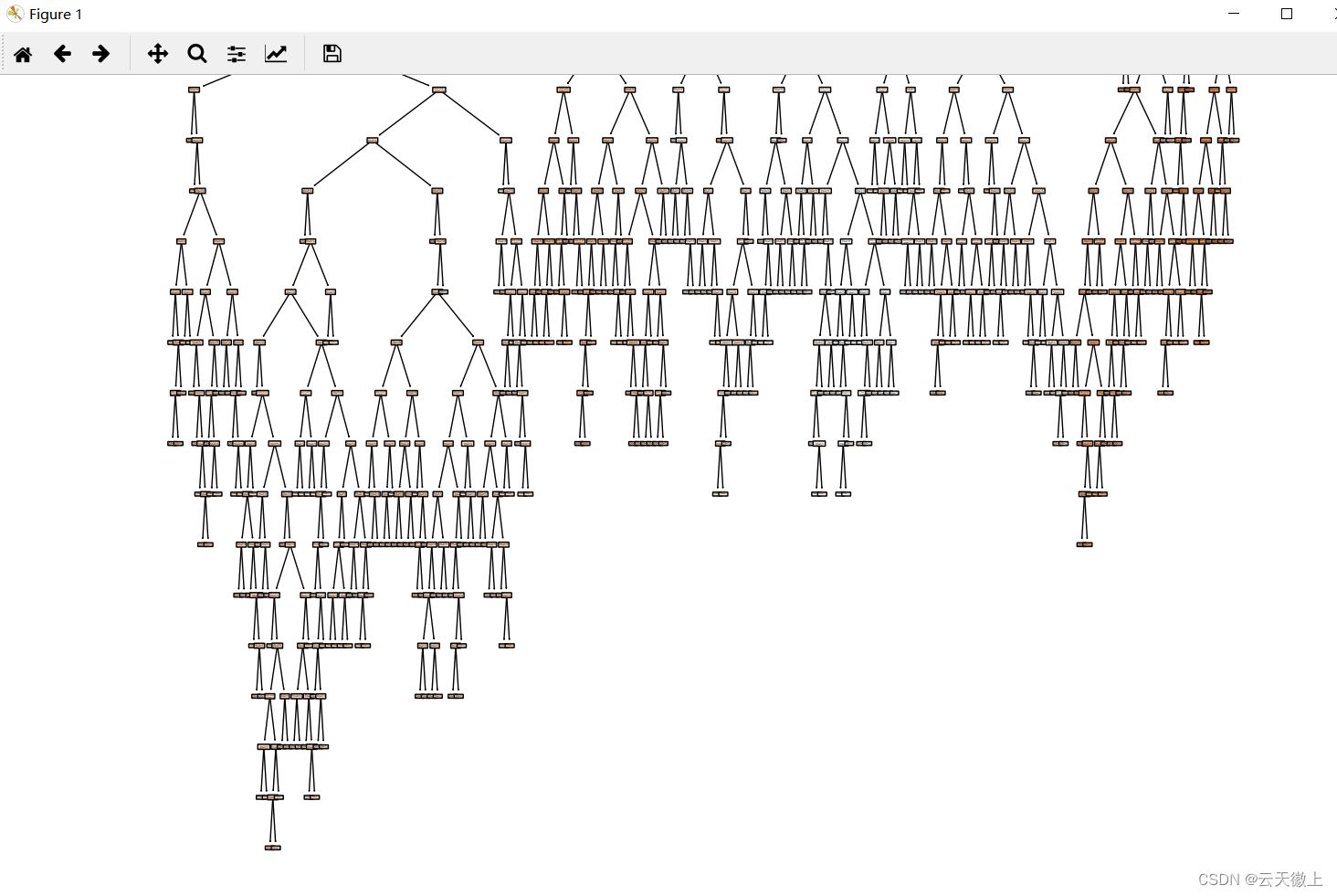

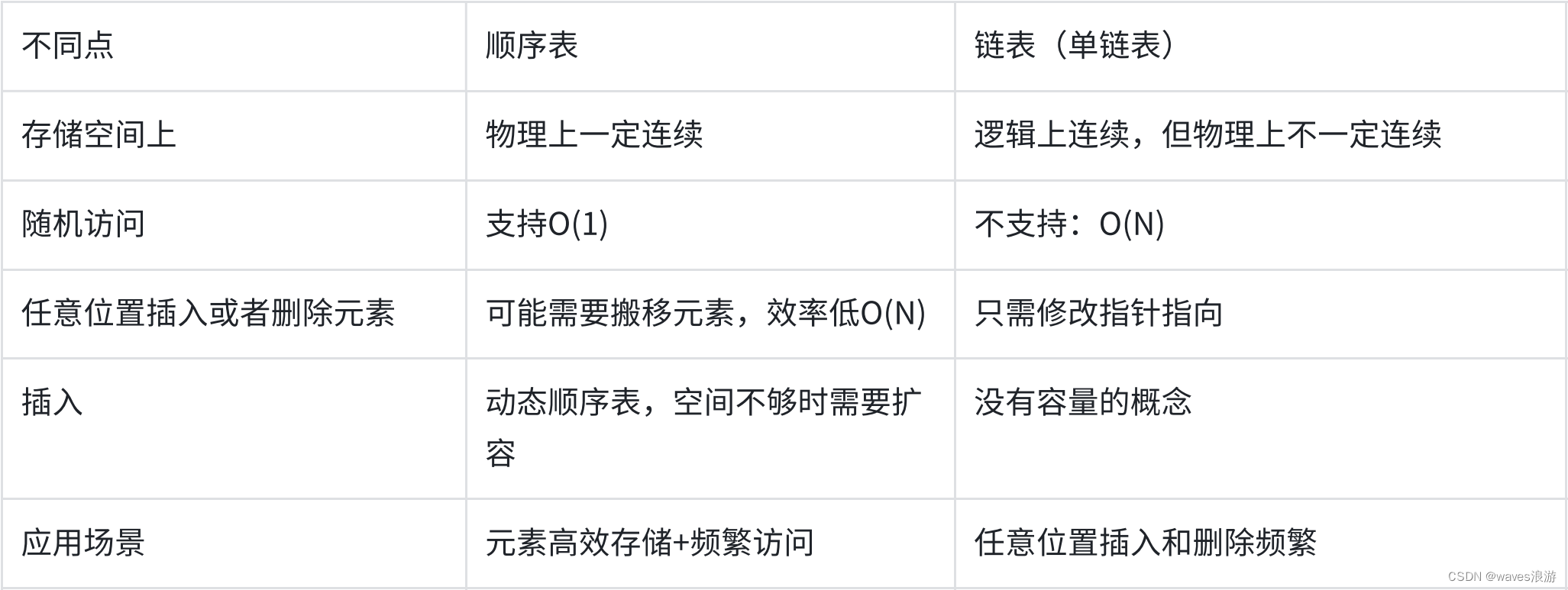

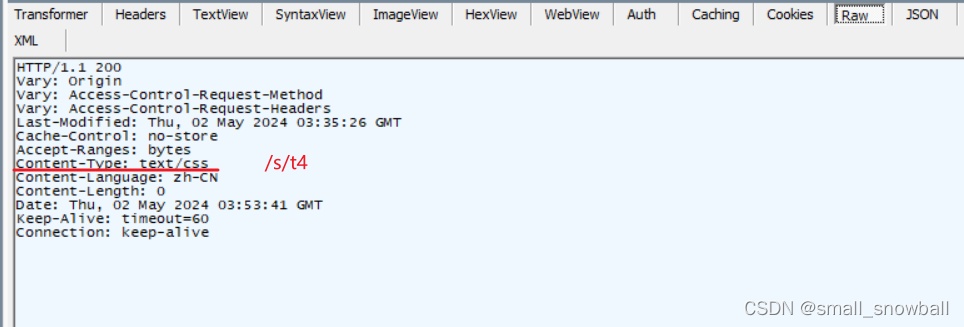
![[嵌入式系统-53]:嵌入式系统集成开发环境大全 ( IAR Embedded Workbench(通用)、MDK(ARM)比较 )](https://img-blog.csdnimg.cn/direct/bacd86ae5fc147faa9cc17f0eb48fc70.png)


